Paul van Yperen's Blog, page 107
October 31, 2022
Directed by John Huston
American director, screenwriter and character actor John Huston (1906-1987) was a Hollywood titan for more than five decades. His debut was the hardboiled mystery The Maltese Falcon (1941) which turned Humphrey Bogart into a superstar. With such films as Key Largo (1948) and The Asphalt Jungle (1950), he became one of the decisive factors in the popularity of Film Noir. His other classics include The Treasure of the Sierra Madre (1948), The African Queen (1951), Moby Dick (1956), The Misfits (1961), Fat City (1972), The Man Who Would Be King (1975) and Prizzi's Honor (1985). Huston received 15 Oscar nominations and won twice, and he directed both his father, Walter Huston and his daughter, Anjelica Huston, to Oscar wins.

American postcard by Pomegranate Publications, Petaluma, CA, no. 5314, 1989. Photo: The Avery Collection. John Huston in Man in the Wilderness (Richard C. Sarafian, 1971).
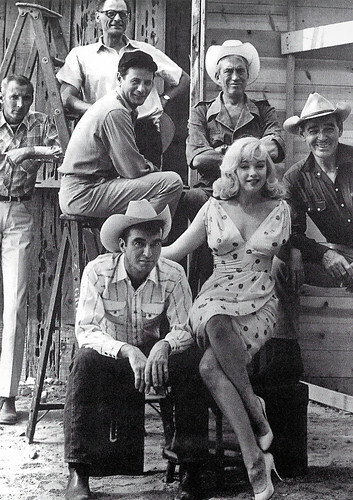
Chinese postcard by Laverton. Photo: Elliott Erwitt/Magnum Photos. John Huston on the set of The Misfits (John Huston, 1961) with his stars Montgomery Clift , Marilyn Monroe , Clark Gable , Eli Wallach, producer Frank E. Taylor and writer Arthur Miller.
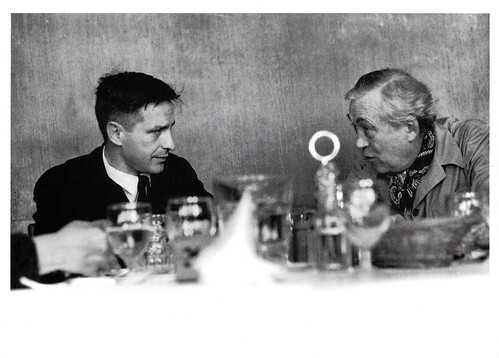
Swiss-British-German postcard by News Productions, Baulmes and Stroud / Filmwelt Berlin, Bakede, no. 56569, 1994. Photo: Larry Shaw. Caption: John Cassavetes and John Huston, Pinewood Studios, England, 1967.
One of the greatest detective films ever made
John Marcellus Huston was born in Nevada, Missouri, in 1906. The age-old story goes that the small town of his birth was won by John's grandfather in a poker game. However, he was raised in Weatherford, Texas, until his family moved to Los Angeles, California. John's father was the character actor Walter Huston, and his mother, Rhea Gore, was a newspaperwoman who travelled around the country looking for stories. The only child of the couple, John began performing on stage with his vaudevillian father at age 3. Upon his parents' divorce at age 7, the young boy would take turns travelling around the vaudeville circuit with his father and the country with his mother on reporting excursions. A frail and sickly child, he was once placed in a sanitarium due to both an enlarged heart and kidney ailment. Making a miraculous recovery, he quit school at age 14 to become a full-fledged boxer and eventually won the Amateur Lightweight Boxing Championship of California.
John married his high school sweetheart, Dorothy Harvey, and in 1925, he also made his stage debut with a leading role off-Broadway in the play 'The Triumph of the Egg'. He made his Broadway debut that same year with 'Ruint' (1925) and followed that with another Broadway show 'Adam Solitaire' (1925). John soon grew restless with the confines of both his marriage and acting and abandoned both, taking a sojourn to Mexico where he became an officer in the cavalry and expert horseman while writing plays on the sly. Trying to control his wanderlust urges, he subsequently returned to America and attempted newspaper and magazine reporting work in New York by submitting short stories. He was even hired at one point by mogul Samuel Goldwyn Jr. as a screenwriter, but again he grew restless. During this time he also appeared unbilled in a few obligatory films. By 1932 John was on the move again and left for London and Paris where he studied painting and sketching. The promising artist became a homeless beggar during one harrowing point.
Returning again to America in 1933, he played the title role in a production of 'Abraham Lincoln', only a few years after his father Walter portrayed the part on film for D.W. Griffith . John began to collaborate on a few scripts for Warner Brothers. He also married again. Warners was so impressed with his talents that he was signed on as both screenwriter and director for the Dashiell Hammett hardboiled mystery The Maltese Falcon (John Huston, 1941). This film classic made a superstar out of Humphrey Bogart and is considered by critics as one of the greatest detective films ever made. In the meantime, John wrote and staged a couple of Broadway plays. After his successful film debut, he directed bad-girl Bette Davis and good girl Olivia de Havilland in the melodrama In This Our Life (John Huston, 1942). He then reunited with three of the stars of The Maltese Falcon, Humphrey Bogart , Mary Astor and Sydney Greenstreet in the romantic war picture Across the Pacific (John Huston, Vincent Sherman, 1942).
During World War II, John Huston served as a Signal Corps lieutenant and went on to helm a number of film documentaries for the U.S. government including the controversial Let There Be Light (1941) about Post-Traumatic Stress Disorder (PTSD), or 'shell shock', for which he followed a group of mentally traumatized veteran patients as they go through psychiatric treatment. His father Walter narrated the film. This film was banned for 35 years because the American government thought it was unsuitable for audiences, and it was shown for the first time at the Cannes festival in 1981. The end of WWII also saw the end of his second marriage with Edith Lesley Black (1937-1945).
The impulsive and unpredictable Huston married his third wife, actress Evelyn Keyes , in 1946 but this marriage also lasted a relatively short time. That same year Huston directed Jean-Paul Sartre's experimental play 'No Exit' on Broadway. The show was a box-office bust and ran less than a month but it nevertheless earned the New York Drama Critics Award as 'best foreign play'. Hollywood glory came to him again in association with Bogart and Warner Brothers. The Treasure of the Sierra Madre (John Huston, 1948) became a classic tale of gold, greed and man's inhumanity to man set in Mexico. John won Oscars for both director and screenplay and his father Walter received the Best Supporting Actor award. John can be glimpsed at the beginning of the film in a cameo playing a tourist, but he wouldn't act again on film for a decade and a half.
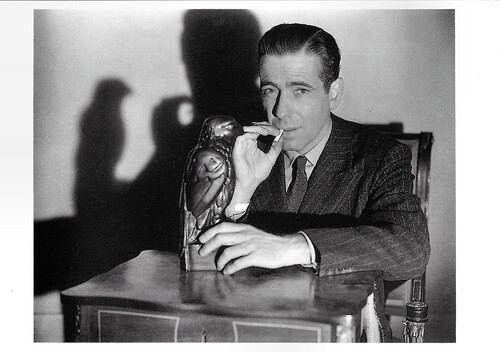
Swiss-German-British postcard by News Productions, Baulmes / Filmwelt Berlin, Bakede / News Productions, Stroud, no. 56495. Photo: Warner Bros / Collection Cinémathèque Suisse, Lausanne. Humphrey Bogart in The Maltese Falcon (John Huston, 1941).
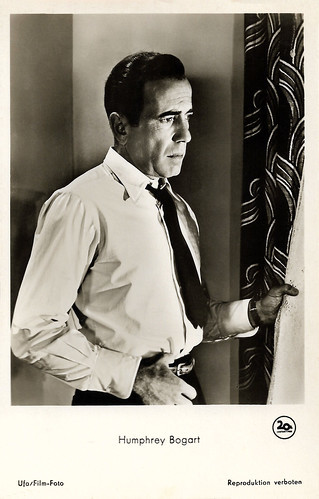
German postcard by UFA/Film-Foto, Berlin-Tempelhof, no. FK 305. Photo: 20th Century Fox. Humphrey Bogart in The Maltese Falcon (John Huston, 1941).
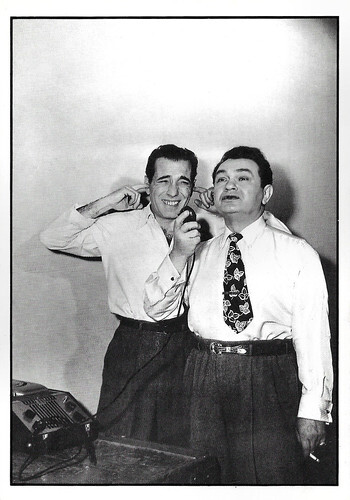
French postcard in the Entr'acte series by Éditions Asphodèle, Mâcon, no. 004/13. Photo: Collection B. Courtel / D.R. Humphrey Bogart and Edward G. Robinson on the set of Key Largo (John Huston, 1948). Caption: Ouch! My ears! Wouldn't Humphrey Bogart appreciate the efforts of his partner Edward G. Robinson in recording a song?
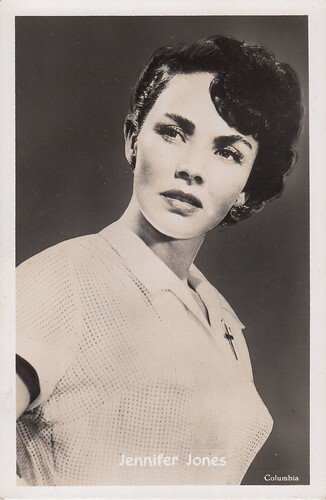
Belgian postcard by Nieuwe Merksemsche Chocolaterie S.P.R.L., Merksem Anvers, no. D7. Photo: Columbia. Jennifer Jones in We Were Strangers (John Huston, 1949). Collection: Marlene Pilaete.
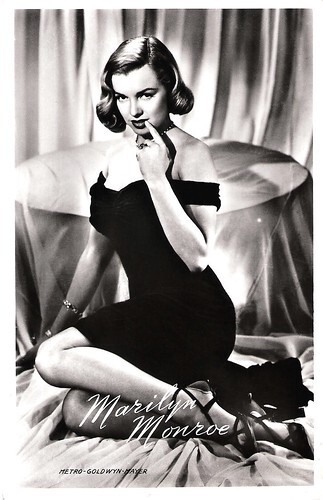
Dutch postcard by Uitg. Takken, Utrecht, no. 1708. Photo: Eric Carpenter / Metro-Goldwyn-Mayer. Marilyn Monroe in The Asphalt Jungle (John Huston, 1950).
Some of the finest American films of that period
In the following decade, John Huston wrote and directed write and/or direct some of the finest American films of that period including Key Largo (1948) and The African Queen (1951) both with Humphrey Bogart , the Film Noir The Asphalt Jungle (John Huston, 1950), the war film The Red Badge of Courage (John Huston, 1951) with Audie Murphy and the classic musical Moulin Rouge (John Huston, 1952) starring José Ferrer.
An ardent supporter of human rights, he, along with director William Wyler and others, dared to form the Committee for the First Amendment in 1947, which strove to undermine the House Un-American Activities Committee. Disgusted by the Hollywood blacklisting that was killing the careers of many talented colleagues, he moved to St. Clerans in Ireland and became a citizen there along with his fourth wife, Russian prima ballerina Enrica (Ricki) Soma. The couple had two children, son Tony Huston (1950) and daughter Anjelica Huston (1951) who went on to have an enviable Hollywood career of her own. Huston and Ricki split after his son, director Danny Huston (1962), was born to actress Zoe Sallis. They did not divorce, however, and remained estranged until her sudden death in 1969 in a car accident. John subsequently adopted his late wife's daughter, Allegra Huston, from another union. The ever-impulsive Huston would move yet again to Mexico where he married (1972) and divorced (1977) his fifth and final wife, Celeste Shane. In his autobiography, published some five years after their divorce, he refused to mention her by name, referring to her only as "a crocodile". On talk shows, he often said it was the only one of his marriages he regretted.
His later films included Moby Dick (John Huston, 1956) based on the classic story by Herman Melville about Captain Ahab ( Gregory Peck ) and his obsession with a huge whale, Moby Dick, The Unforgiven (John Huston, 1960) about a frontier family who is suspected that their adopted daughter ( Audrey Hepburn ) was stolen from the local Kiowa tribe, and The Misfits (John Huston, 1961) the last completed film for both Clark Gable and Marilyn Monroe . The films he made in the 1960s also included Freud (John Huston, 1962) with Montgomery Clift , The Night of the Iguana (John Huston, 1964) starring Richard Burton and Ava Gardner , and The Bible: In the Beginning... (John Huston, 1966) with Michael Parks as Jesus were mostly well-regarded but not close to the level of his earlier revered work. Huston also experimented behind the camera with colour effects and approached such taboo topics as homosexuality and psychoanalysis.
Huston returned to acting auspiciously with a major role in Otto Preminger's epic film The Cardinal (1963) for which Huston received an Oscar nomination at age 57. From that time forward, he would be glimpsed here and there in character roles in both good and bad films that, at the very least, helped finance his own projects. Gary Brumburgh at IMDb : "The former list included outstanding roles in Chinatown (Roman Polanski, 1974) and The Wind and the Lion (John Milius, 1975), while the latter comprised of hammy parts in such awful drek as Candy (Christian Marquand, 1968) and Myra Breckinridge (Michael Sarne, 1970).
Huston directed his daughter Angelica in her film debut, the thoroughly mediocre A Walk with Love and Death (John Huston, 1969), but he made up for it 15 years later by directing her to an Oscar in the gangster film Prizzi's Honor (1985) with Jack Nicholson . In the 1970s Huston resurged as a director of quality films with Fat City (John Huston, 1972) starring Jeff Bridges, The Man Who Would Be King (John Huston, 1975) with Sean Connery and Wise Blood (John Huston, 1979). He ended his career on a high note with Under the Volcano (1984) with Albert Finney , Prizzi's Honor (1985) and the James Joyce adaptation The Dead (John Huston, 1987). His only certifiable misfire during that era was the musical version of Annie (John Huston, 1982), though it was popular among children.
Huston lived the macho, outdoors life, unencumbered by convention or restrictions, and is often compared to Ernest Hemingway and Orson Welles . Gary Brumbrugh: "He was, in fact, the source of inspiration for Clint Eastwood in the helming of the film White Hunter Black Heart (1990) which chronicled the making of The African Queen. Illness robbed Huston of a good portion of his twilight years with chronic emphysema the main culprit. As always, however, he continued to work tirelessly while hooked up to an oxygen machine if need be. At the end, the living legend was shooting an acting cameo in the film Mr. North (1988) for his son Danny, making his directorial bow at the time." While on location, John Huston became seriously ill with pneumonia and died in Middletown, Rhode Island, at the age of 81. He was buried with his mother at Hollywood Memorial Park, now called Hollywood Forever.
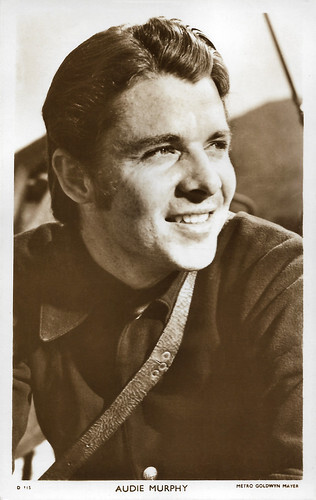
British postcard, in the Picturegoer Series, London, no. D 115. Photo: Metro Goldwyn Mayer. Audie Murphy in The Red Badge of Courage (John Huston, 1951).
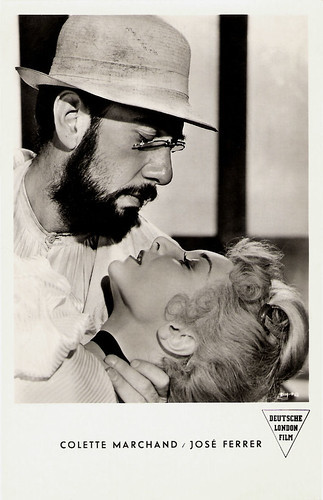
German postcard. Photo: Deutsche London Film. José Ferrer and Colette Marchand in Moulin Rouge (John Huston, 1952).
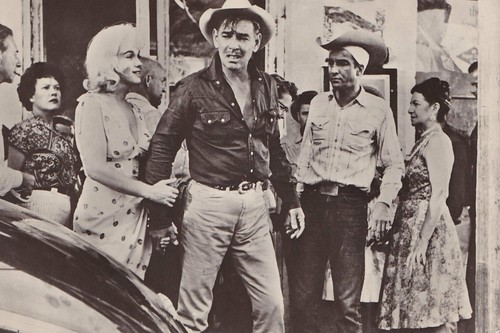
Czech postcard by Pressfoto, Praha (Prague). Photo: Marilyn Monroe , Clark Gable , and Montgomery Clift in The Misfits (John Huston, 1961). Collection: Carla Bosch.
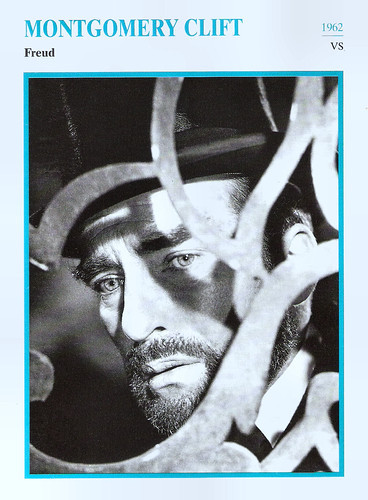
Dutch collectors card in the series 'Filmsterren: een Portret' by Edito Service, 1994. Photo: The Kobal Collection. Montgomery Clift in Freud (John Huston, 1962).
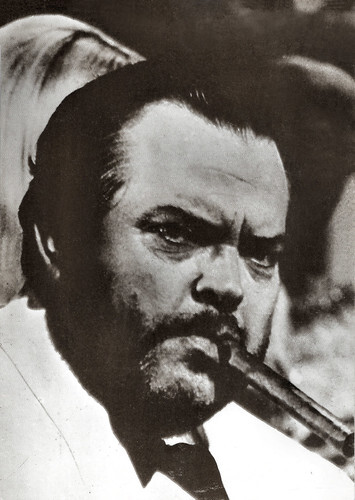
French postcard by Delta Productions, Montpellier, no. CP152. Orson Welles in Casino Royale (Val Guest, Ken Hughes, John Huston, 1967).
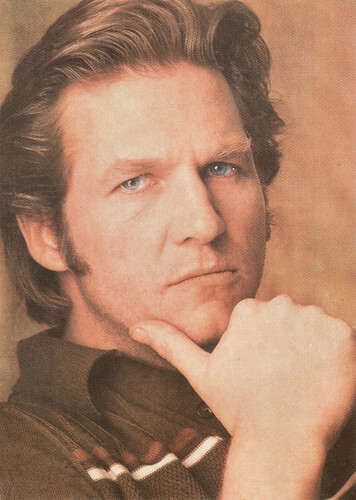
Romanian postcard by Casa Filmului Acin. Jeff Bridges on a publicity still for Fat City (John Huston, 1972).
Sources: (IMDb), Wikipedia and .

American postcard by Pomegranate Publications, Petaluma, CA, no. 5314, 1989. Photo: The Avery Collection. John Huston in Man in the Wilderness (Richard C. Sarafian, 1971).

Chinese postcard by Laverton. Photo: Elliott Erwitt/Magnum Photos. John Huston on the set of The Misfits (John Huston, 1961) with his stars Montgomery Clift , Marilyn Monroe , Clark Gable , Eli Wallach, producer Frank E. Taylor and writer Arthur Miller.

Swiss-British-German postcard by News Productions, Baulmes and Stroud / Filmwelt Berlin, Bakede, no. 56569, 1994. Photo: Larry Shaw. Caption: John Cassavetes and John Huston, Pinewood Studios, England, 1967.
One of the greatest detective films ever made
John Marcellus Huston was born in Nevada, Missouri, in 1906. The age-old story goes that the small town of his birth was won by John's grandfather in a poker game. However, he was raised in Weatherford, Texas, until his family moved to Los Angeles, California. John's father was the character actor Walter Huston, and his mother, Rhea Gore, was a newspaperwoman who travelled around the country looking for stories. The only child of the couple, John began performing on stage with his vaudevillian father at age 3. Upon his parents' divorce at age 7, the young boy would take turns travelling around the vaudeville circuit with his father and the country with his mother on reporting excursions. A frail and sickly child, he was once placed in a sanitarium due to both an enlarged heart and kidney ailment. Making a miraculous recovery, he quit school at age 14 to become a full-fledged boxer and eventually won the Amateur Lightweight Boxing Championship of California.
John married his high school sweetheart, Dorothy Harvey, and in 1925, he also made his stage debut with a leading role off-Broadway in the play 'The Triumph of the Egg'. He made his Broadway debut that same year with 'Ruint' (1925) and followed that with another Broadway show 'Adam Solitaire' (1925). John soon grew restless with the confines of both his marriage and acting and abandoned both, taking a sojourn to Mexico where he became an officer in the cavalry and expert horseman while writing plays on the sly. Trying to control his wanderlust urges, he subsequently returned to America and attempted newspaper and magazine reporting work in New York by submitting short stories. He was even hired at one point by mogul Samuel Goldwyn Jr. as a screenwriter, but again he grew restless. During this time he also appeared unbilled in a few obligatory films. By 1932 John was on the move again and left for London and Paris where he studied painting and sketching. The promising artist became a homeless beggar during one harrowing point.
Returning again to America in 1933, he played the title role in a production of 'Abraham Lincoln', only a few years after his father Walter portrayed the part on film for D.W. Griffith . John began to collaborate on a few scripts for Warner Brothers. He also married again. Warners was so impressed with his talents that he was signed on as both screenwriter and director for the Dashiell Hammett hardboiled mystery The Maltese Falcon (John Huston, 1941). This film classic made a superstar out of Humphrey Bogart and is considered by critics as one of the greatest detective films ever made. In the meantime, John wrote and staged a couple of Broadway plays. After his successful film debut, he directed bad-girl Bette Davis and good girl Olivia de Havilland in the melodrama In This Our Life (John Huston, 1942). He then reunited with three of the stars of The Maltese Falcon, Humphrey Bogart , Mary Astor and Sydney Greenstreet in the romantic war picture Across the Pacific (John Huston, Vincent Sherman, 1942).
During World War II, John Huston served as a Signal Corps lieutenant and went on to helm a number of film documentaries for the U.S. government including the controversial Let There Be Light (1941) about Post-Traumatic Stress Disorder (PTSD), or 'shell shock', for which he followed a group of mentally traumatized veteran patients as they go through psychiatric treatment. His father Walter narrated the film. This film was banned for 35 years because the American government thought it was unsuitable for audiences, and it was shown for the first time at the Cannes festival in 1981. The end of WWII also saw the end of his second marriage with Edith Lesley Black (1937-1945).
The impulsive and unpredictable Huston married his third wife, actress Evelyn Keyes , in 1946 but this marriage also lasted a relatively short time. That same year Huston directed Jean-Paul Sartre's experimental play 'No Exit' on Broadway. The show was a box-office bust and ran less than a month but it nevertheless earned the New York Drama Critics Award as 'best foreign play'. Hollywood glory came to him again in association with Bogart and Warner Brothers. The Treasure of the Sierra Madre (John Huston, 1948) became a classic tale of gold, greed and man's inhumanity to man set in Mexico. John won Oscars for both director and screenplay and his father Walter received the Best Supporting Actor award. John can be glimpsed at the beginning of the film in a cameo playing a tourist, but he wouldn't act again on film for a decade and a half.

Swiss-German-British postcard by News Productions, Baulmes / Filmwelt Berlin, Bakede / News Productions, Stroud, no. 56495. Photo: Warner Bros / Collection Cinémathèque Suisse, Lausanne. Humphrey Bogart in The Maltese Falcon (John Huston, 1941).

German postcard by UFA/Film-Foto, Berlin-Tempelhof, no. FK 305. Photo: 20th Century Fox. Humphrey Bogart in The Maltese Falcon (John Huston, 1941).

French postcard in the Entr'acte series by Éditions Asphodèle, Mâcon, no. 004/13. Photo: Collection B. Courtel / D.R. Humphrey Bogart and Edward G. Robinson on the set of Key Largo (John Huston, 1948). Caption: Ouch! My ears! Wouldn't Humphrey Bogart appreciate the efforts of his partner Edward G. Robinson in recording a song?

Belgian postcard by Nieuwe Merksemsche Chocolaterie S.P.R.L., Merksem Anvers, no. D7. Photo: Columbia. Jennifer Jones in We Were Strangers (John Huston, 1949). Collection: Marlene Pilaete.

Dutch postcard by Uitg. Takken, Utrecht, no. 1708. Photo: Eric Carpenter / Metro-Goldwyn-Mayer. Marilyn Monroe in The Asphalt Jungle (John Huston, 1950).
Some of the finest American films of that period
In the following decade, John Huston wrote and directed write and/or direct some of the finest American films of that period including Key Largo (1948) and The African Queen (1951) both with Humphrey Bogart , the Film Noir The Asphalt Jungle (John Huston, 1950), the war film The Red Badge of Courage (John Huston, 1951) with Audie Murphy and the classic musical Moulin Rouge (John Huston, 1952) starring José Ferrer.
An ardent supporter of human rights, he, along with director William Wyler and others, dared to form the Committee for the First Amendment in 1947, which strove to undermine the House Un-American Activities Committee. Disgusted by the Hollywood blacklisting that was killing the careers of many talented colleagues, he moved to St. Clerans in Ireland and became a citizen there along with his fourth wife, Russian prima ballerina Enrica (Ricki) Soma. The couple had two children, son Tony Huston (1950) and daughter Anjelica Huston (1951) who went on to have an enviable Hollywood career of her own. Huston and Ricki split after his son, director Danny Huston (1962), was born to actress Zoe Sallis. They did not divorce, however, and remained estranged until her sudden death in 1969 in a car accident. John subsequently adopted his late wife's daughter, Allegra Huston, from another union. The ever-impulsive Huston would move yet again to Mexico where he married (1972) and divorced (1977) his fifth and final wife, Celeste Shane. In his autobiography, published some five years after their divorce, he refused to mention her by name, referring to her only as "a crocodile". On talk shows, he often said it was the only one of his marriages he regretted.
His later films included Moby Dick (John Huston, 1956) based on the classic story by Herman Melville about Captain Ahab ( Gregory Peck ) and his obsession with a huge whale, Moby Dick, The Unforgiven (John Huston, 1960) about a frontier family who is suspected that their adopted daughter ( Audrey Hepburn ) was stolen from the local Kiowa tribe, and The Misfits (John Huston, 1961) the last completed film for both Clark Gable and Marilyn Monroe . The films he made in the 1960s also included Freud (John Huston, 1962) with Montgomery Clift , The Night of the Iguana (John Huston, 1964) starring Richard Burton and Ava Gardner , and The Bible: In the Beginning... (John Huston, 1966) with Michael Parks as Jesus were mostly well-regarded but not close to the level of his earlier revered work. Huston also experimented behind the camera with colour effects and approached such taboo topics as homosexuality and psychoanalysis.
Huston returned to acting auspiciously with a major role in Otto Preminger's epic film The Cardinal (1963) for which Huston received an Oscar nomination at age 57. From that time forward, he would be glimpsed here and there in character roles in both good and bad films that, at the very least, helped finance his own projects. Gary Brumburgh at IMDb : "The former list included outstanding roles in Chinatown (Roman Polanski, 1974) and The Wind and the Lion (John Milius, 1975), while the latter comprised of hammy parts in such awful drek as Candy (Christian Marquand, 1968) and Myra Breckinridge (Michael Sarne, 1970).
Huston directed his daughter Angelica in her film debut, the thoroughly mediocre A Walk with Love and Death (John Huston, 1969), but he made up for it 15 years later by directing her to an Oscar in the gangster film Prizzi's Honor (1985) with Jack Nicholson . In the 1970s Huston resurged as a director of quality films with Fat City (John Huston, 1972) starring Jeff Bridges, The Man Who Would Be King (John Huston, 1975) with Sean Connery and Wise Blood (John Huston, 1979). He ended his career on a high note with Under the Volcano (1984) with Albert Finney , Prizzi's Honor (1985) and the James Joyce adaptation The Dead (John Huston, 1987). His only certifiable misfire during that era was the musical version of Annie (John Huston, 1982), though it was popular among children.
Huston lived the macho, outdoors life, unencumbered by convention or restrictions, and is often compared to Ernest Hemingway and Orson Welles . Gary Brumbrugh: "He was, in fact, the source of inspiration for Clint Eastwood in the helming of the film White Hunter Black Heart (1990) which chronicled the making of The African Queen. Illness robbed Huston of a good portion of his twilight years with chronic emphysema the main culprit. As always, however, he continued to work tirelessly while hooked up to an oxygen machine if need be. At the end, the living legend was shooting an acting cameo in the film Mr. North (1988) for his son Danny, making his directorial bow at the time." While on location, John Huston became seriously ill with pneumonia and died in Middletown, Rhode Island, at the age of 81. He was buried with his mother at Hollywood Memorial Park, now called Hollywood Forever.

British postcard, in the Picturegoer Series, London, no. D 115. Photo: Metro Goldwyn Mayer. Audie Murphy in The Red Badge of Courage (John Huston, 1951).

German postcard. Photo: Deutsche London Film. José Ferrer and Colette Marchand in Moulin Rouge (John Huston, 1952).

Czech postcard by Pressfoto, Praha (Prague). Photo: Marilyn Monroe , Clark Gable , and Montgomery Clift in The Misfits (John Huston, 1961). Collection: Carla Bosch.

Dutch collectors card in the series 'Filmsterren: een Portret' by Edito Service, 1994. Photo: The Kobal Collection. Montgomery Clift in Freud (John Huston, 1962).

French postcard by Delta Productions, Montpellier, no. CP152. Orson Welles in Casino Royale (Val Guest, Ken Hughes, John Huston, 1967).

Romanian postcard by Casa Filmului Acin. Jeff Bridges on a publicity still for Fat City (John Huston, 1972).
Sources: (IMDb), Wikipedia and .
Published on October 31, 2022 23:00
October 30, 2022
La Belle et la Bête (1946)
The surrealistic fairytale La belle et la bête/Beauty and the Beast (Jean Cocteau, René Clément, 1946) is a classic of French cinema. Josette Day stars as Belle and Jean Marais in a triple role as the beast, Avenant and the prince. The film, produced by André Paulvé, was based on the eponymous 1756 fairy tale by Jeanne-Marie Leprince de Beaumont. The wonderful shadowy images were created by Cocteau, cameraman Henri Alekan and photographer Aldo Graziati.
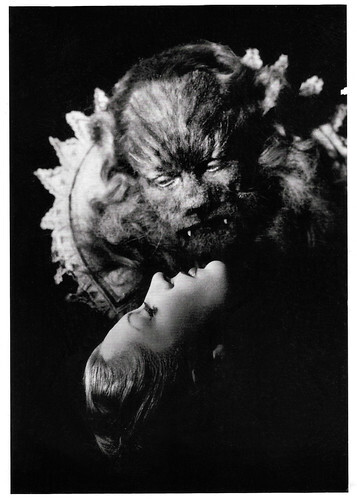
Swiss postcard by News Productions, Baulmes, no. 56515. Photo: Collection Cinémathèque Suisse, Lausanne. Jean Marais and Josette Day in La belle et la bête/Beauty and the Beast (Jean Cocteau, René Clément, 1946).
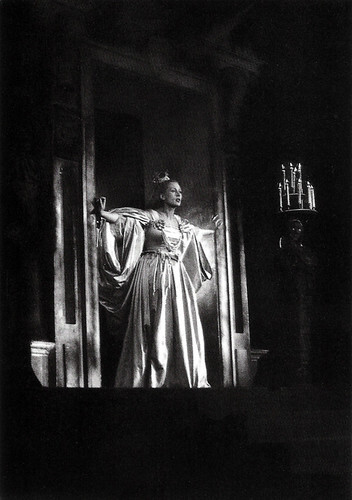
French postcard, no. C130. Photo: Josette Day in La belle et la bête/Beauty and the Beast (Jean Cocteau, René Clément, 1946).
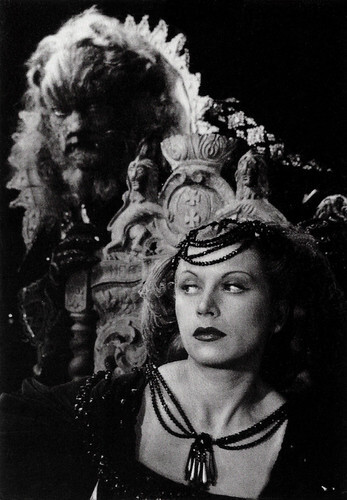
French postcard, no. C142. Photo: Aldo. Jean Marais and Josette Day in La belle et la bête/Beauty and the Beast (Jean Cocteau, René Clément, 1946).
One of the most beautiful fantasy films of all time
La belle et la bête/Beauty and the Beast (Jean Cocteau, René Clément, 1946) is a French black-and-white fairy tale adaptation. This film is often cited as one of the most beautiful fantasy films of all time and to some extent inspired Disney's animated film, Beauty and the Beast (Gary Trousdale, Kirk Wise, 1991).
At the end of World War II, Jean Marais suggested to Jean Cocteau that he make a film based on the 18th-century fairy tale of Madame Jeanne-Marie Le Prince de Beaumont. Cocteau thought it was an excellent idea. Not only did it coincide with the dreams he had in his childhood - but it also offered an opportunity for a new genre within the film: filmed fairy tales. During the shooting of the film, Cocteau became very ill because of a skin disease and eventually had to be hospitalised. While he was recovering, René Clément served as the director.
The leads feature Josette Day as Belle and Michel Auclair as her brother Ludovic. He gave the role of the Beast to the actor who was then seen as the world's most beautiful man, Jean Marais . Marais plays a triple role as the beast, Belle's worshipper (Avenant) and the prince. Georges Auric wrote the music and Henri Alekan did the camera work. Christian Bérard and Lucien Carré did the art direction. The House of Lanvin made all of the costumes, with resident designer Pierre Cardin supervising the men's wardrobe. Many rules were broken during the making of this film, Auric's music breaking rather than underlining the visual effects. Alekan's camerawork is not conventional, but sharp and clear - almost like a documentary.
It was the first film that Jean Cocteau both wrote and directed since his debut Le sang d'un poète/The Blood of a Poet (Jean Cocteau, 1932). On the surface, La belle et la bête seems different from the previous one, but both films work with myths and create an atmosphere of unearthly beauty. In his adaptation, Cocteau made morality play a role subject to magic, symbolism, surrealism and psychoanalysis. There are human arms anchored in the wall carrying candlesticks and caryatids with moving eyes and exhaling smoke. Cocteau also placed several enchanted lucky charms and enchanted gardens in the film. The film was shot in the French countryside, in a setting that lends credibility to both the down-to-earth, realistic home of Belle and her family. The Beast's castle exteriors were shot at the Château de la Roche Courbon, a French historic site.
La belle et la bête is known for its surrealistic qualities and its use of existing film techniques to evoke a sense of magic and enchantment. Cocteau shows here how difficult it is sometimes to separate fantasy from reality. The camera work and set designs reference nineteenth-century artist Gustave Doré's illustrations and engravings and, in the farm scenes, Johannes Vermeer's paintings. Jean Cocteau's use of imagery provided a lot of surrealist or Jungian analysis. La belle et la bête remains true to the fairy tale in spirit, but the portrayal is definitely Cocteau's. With this, he inspired later directors such as Ingmar Bergman , François Truffaut and Vincente Minnelli.
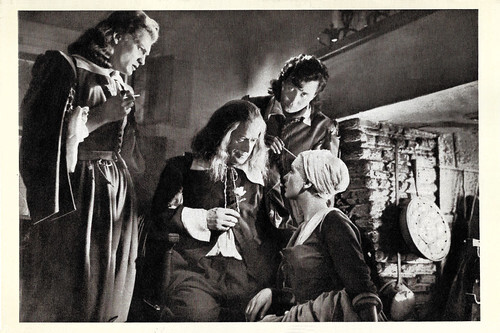
French card by Editions La Malibran, Saint-Dié, no CF 19. Photo: Aldo. Jean Marais , Marcel André, Michel Auclair and Josette Day in La belle et la bête/Beauty and the Beast (Jean Cocteau, René Clément, 1946).
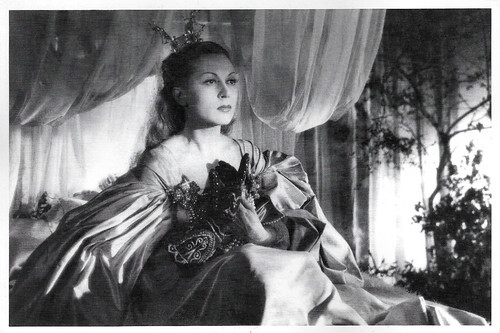
French card by Groupes National des cinemas de recherche (CNC). Josette Day in La belle et la bête/Beauty and the Beast (Jean Cocteau, René Clément, 1946).
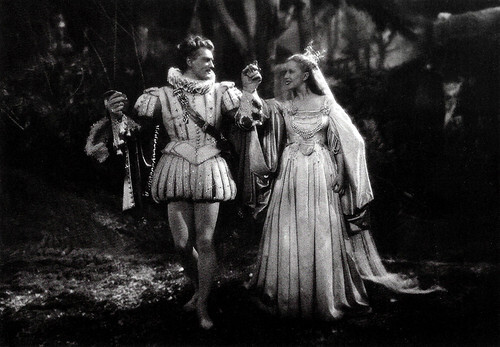
French postcard, no. C 141. Jean Marais and Josette Day in La belle et la bête/Beauty and the Beast (Jean Cocteau, René Clément, 1946).
A monster with magical abilities, created as half-man, half-animal
A merchant (Marcel André) lives in the countryside with his son Ludovic ( Michel Auclair ) and three daughters, Félicie ( Mila Parély ), Adélaïde (Nane Germon) and Belle ( Josette Day ). The merchant is balancing on the brink of bankruptcy. His two eldest daughters are vain, selfish and mean and treat their youngest sister Belle like a servant. Jean Cocteau regularly mocks them in the film, for instance when he lets clucking ducks be a comment on their bickering between them.
One day, the father leaves on a business trip. Before his departure, he promised his daughters to bring back gifts. For Félicie and Adélaïde beautiful dresses and for Belle a beautiful rose. On the way, he gets lost in a forest. There he discovers a strange castle, where he picks a rose to give to Belle. Suddenly, the owner of the castle ( Jean Marais ) appears, a monster with magical abilities, created as half-man, half-animal.
The lord of the castle condemns the merchant to death unless he gives him one of his daughters. Belle sacrifices herself and goes to the castle. Her journey to the castle is filmed in slow motion, creating a dreamy atmosphere. When she meets the beast, she faints. Slowly, she learns to love him. It turns out that only she can see his hidden inner beauty. The real beast turns out to be Avenant, the one who wants to marry her.
There are two different worlds in this film, the ordinary bourgeois home of the merchant on the one hand, and the enchanted castle of the Beast where anything is possible. These two worlds are linked by the mysterious forest. In and around the castle live the candelabra, the gardens and the caryatids.
Throughout the film, the Beast unveils five magical guides, the rose, a golden key, a gauntlet, a ring and the mirror, some of these are taken from Madame Leprince de Beaumont's fairy tale. Later this is joined by the white horse, "le Magnifique", and in the end, these two worlds come together. Belle's room is in her father's room - but also in her castle room. When Avenant dies, the Beast becomes the Prince he once used to be.
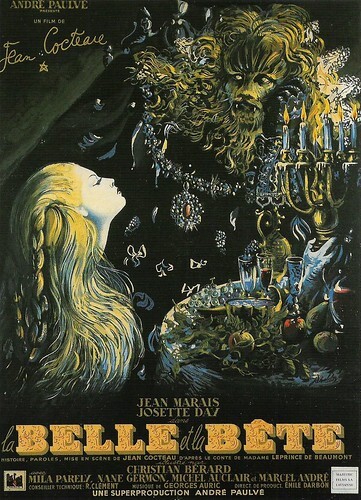
Swiss postcard by CVB Publishers. Image: Collection Cinémathèque Lausanne. Reproduction of the French film poster for La Belle et la Bête (Jean Cocteau, René Clément, 1946). The poster was designed by Cocteau's friend Jean-Denis Malcles.
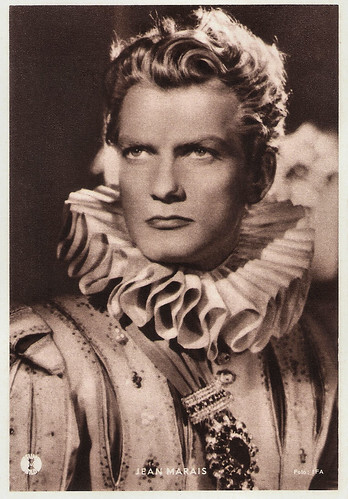
German postcard by Film und Bild, Frankfurt a.M. Photo: Aldo Graziati / IFA. Publicity still for La belle et la bête/Beauty and the Beast (Jean Coctteau, 1946).
Sources: Wikipedia (Dutch) and IMDb.

Swiss postcard by News Productions, Baulmes, no. 56515. Photo: Collection Cinémathèque Suisse, Lausanne. Jean Marais and Josette Day in La belle et la bête/Beauty and the Beast (Jean Cocteau, René Clément, 1946).

French postcard, no. C130. Photo: Josette Day in La belle et la bête/Beauty and the Beast (Jean Cocteau, René Clément, 1946).

French postcard, no. C142. Photo: Aldo. Jean Marais and Josette Day in La belle et la bête/Beauty and the Beast (Jean Cocteau, René Clément, 1946).
One of the most beautiful fantasy films of all time
La belle et la bête/Beauty and the Beast (Jean Cocteau, René Clément, 1946) is a French black-and-white fairy tale adaptation. This film is often cited as one of the most beautiful fantasy films of all time and to some extent inspired Disney's animated film, Beauty and the Beast (Gary Trousdale, Kirk Wise, 1991).
At the end of World War II, Jean Marais suggested to Jean Cocteau that he make a film based on the 18th-century fairy tale of Madame Jeanne-Marie Le Prince de Beaumont. Cocteau thought it was an excellent idea. Not only did it coincide with the dreams he had in his childhood - but it also offered an opportunity for a new genre within the film: filmed fairy tales. During the shooting of the film, Cocteau became very ill because of a skin disease and eventually had to be hospitalised. While he was recovering, René Clément served as the director.
The leads feature Josette Day as Belle and Michel Auclair as her brother Ludovic. He gave the role of the Beast to the actor who was then seen as the world's most beautiful man, Jean Marais . Marais plays a triple role as the beast, Belle's worshipper (Avenant) and the prince. Georges Auric wrote the music and Henri Alekan did the camera work. Christian Bérard and Lucien Carré did the art direction. The House of Lanvin made all of the costumes, with resident designer Pierre Cardin supervising the men's wardrobe. Many rules were broken during the making of this film, Auric's music breaking rather than underlining the visual effects. Alekan's camerawork is not conventional, but sharp and clear - almost like a documentary.
It was the first film that Jean Cocteau both wrote and directed since his debut Le sang d'un poète/The Blood of a Poet (Jean Cocteau, 1932). On the surface, La belle et la bête seems different from the previous one, but both films work with myths and create an atmosphere of unearthly beauty. In his adaptation, Cocteau made morality play a role subject to magic, symbolism, surrealism and psychoanalysis. There are human arms anchored in the wall carrying candlesticks and caryatids with moving eyes and exhaling smoke. Cocteau also placed several enchanted lucky charms and enchanted gardens in the film. The film was shot in the French countryside, in a setting that lends credibility to both the down-to-earth, realistic home of Belle and her family. The Beast's castle exteriors were shot at the Château de la Roche Courbon, a French historic site.
La belle et la bête is known for its surrealistic qualities and its use of existing film techniques to evoke a sense of magic and enchantment. Cocteau shows here how difficult it is sometimes to separate fantasy from reality. The camera work and set designs reference nineteenth-century artist Gustave Doré's illustrations and engravings and, in the farm scenes, Johannes Vermeer's paintings. Jean Cocteau's use of imagery provided a lot of surrealist or Jungian analysis. La belle et la bête remains true to the fairy tale in spirit, but the portrayal is definitely Cocteau's. With this, he inspired later directors such as Ingmar Bergman , François Truffaut and Vincente Minnelli.

French card by Editions La Malibran, Saint-Dié, no CF 19. Photo: Aldo. Jean Marais , Marcel André, Michel Auclair and Josette Day in La belle et la bête/Beauty and the Beast (Jean Cocteau, René Clément, 1946).

French card by Groupes National des cinemas de recherche (CNC). Josette Day in La belle et la bête/Beauty and the Beast (Jean Cocteau, René Clément, 1946).

French postcard, no. C 141. Jean Marais and Josette Day in La belle et la bête/Beauty and the Beast (Jean Cocteau, René Clément, 1946).
A monster with magical abilities, created as half-man, half-animal
A merchant (Marcel André) lives in the countryside with his son Ludovic ( Michel Auclair ) and three daughters, Félicie ( Mila Parély ), Adélaïde (Nane Germon) and Belle ( Josette Day ). The merchant is balancing on the brink of bankruptcy. His two eldest daughters are vain, selfish and mean and treat their youngest sister Belle like a servant. Jean Cocteau regularly mocks them in the film, for instance when he lets clucking ducks be a comment on their bickering between them.
One day, the father leaves on a business trip. Before his departure, he promised his daughters to bring back gifts. For Félicie and Adélaïde beautiful dresses and for Belle a beautiful rose. On the way, he gets lost in a forest. There he discovers a strange castle, where he picks a rose to give to Belle. Suddenly, the owner of the castle ( Jean Marais ) appears, a monster with magical abilities, created as half-man, half-animal.
The lord of the castle condemns the merchant to death unless he gives him one of his daughters. Belle sacrifices herself and goes to the castle. Her journey to the castle is filmed in slow motion, creating a dreamy atmosphere. When she meets the beast, she faints. Slowly, she learns to love him. It turns out that only she can see his hidden inner beauty. The real beast turns out to be Avenant, the one who wants to marry her.
There are two different worlds in this film, the ordinary bourgeois home of the merchant on the one hand, and the enchanted castle of the Beast where anything is possible. These two worlds are linked by the mysterious forest. In and around the castle live the candelabra, the gardens and the caryatids.
Throughout the film, the Beast unveils five magical guides, the rose, a golden key, a gauntlet, a ring and the mirror, some of these are taken from Madame Leprince de Beaumont's fairy tale. Later this is joined by the white horse, "le Magnifique", and in the end, these two worlds come together. Belle's room is in her father's room - but also in her castle room. When Avenant dies, the Beast becomes the Prince he once used to be.

Swiss postcard by CVB Publishers. Image: Collection Cinémathèque Lausanne. Reproduction of the French film poster for La Belle et la Bête (Jean Cocteau, René Clément, 1946). The poster was designed by Cocteau's friend Jean-Denis Malcles.

German postcard by Film und Bild, Frankfurt a.M. Photo: Aldo Graziati / IFA. Publicity still for La belle et la bête/Beauty and the Beast (Jean Coctteau, 1946).
Sources: Wikipedia (Dutch) and IMDb.
Published on October 30, 2022 23:00
October 29, 2022
The 50 most beautiful women of the century!
It's a guilty pleasure. I mean a postcard series like 'De 50 mooiste vrouwen van de eeuw!' (The 50 most beautiful women of the century!) series by P-Magazine was a typically 20th-century fad. But of course, we still like to watch beautiful women and compare the editor's selection with our own preferences, but a series like this is something from another era.
P-Magazine is a former Belgian magazine aimed primarily at a male audience. The magazine started in December 1997 as the successor to the defunct weekly De Nieuwe Panorama. The last paper issue appeared at the beginning of February 2017. The magazine was a Dutch-language weekly (from 2015 a monthly) that covered cars, film, women and games, as well as politics, sociology, science, music and literature. The magazine was best known for its annual 8-week swimming costume special, for which famous Flemish women posed at exotic locations. It also featured more or less well-known female models or persons on the cover every week.
The complete postcard series included several models and TV personalities who were never seen on the screen. So for this post, we selected 13 postcards with beautiful film stars who were popular in the 20th Century.
No. 47: Nastassja Kinski
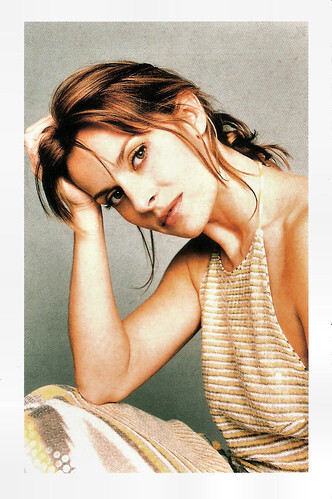
Belgian postcard in the series 'De 50 mooiste vrouwen van de eeuw!' by P-Magazine, no. 48. Photo: Davis Factor / Outline.
Beautiful German-born actress Nastassja Kinski (1961) has appeared in more than 60 films. Her starring roles include her Golden Globe Award-winning portrayal of the title character in Tess (1979) and parts in Wim Wenders' films Falsche Bewegung/The Wrong Move (1975), Paris, Texas (1984) and In weiter Ferne, so nah!/Faraway, So Close! (1993).
No. 38: Teri Hatcher
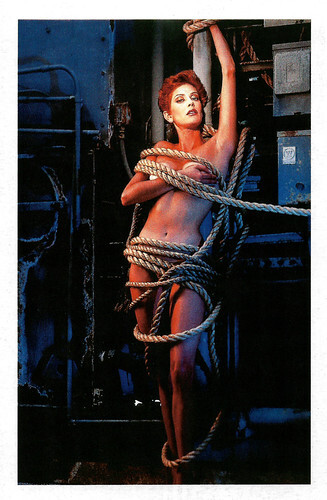
Belgian postcard in de 'De 50 mooiste vrouwen van de eeuw' series by P-Magazine, no. 38. Photo: Michael Grecco /I.D. Press. The October 1996 issue of American film magazine Movieline originally had a cover with this picture of Teri Hatcher wearing nothing but rope wrapped around her. This proved too controversial and a second cover picture (of Hatcher in a dress) was substituted.
American actress, writer, presenter and singer Teri Hatcher (1964) is most known as Lois Lane on the television series Lois & Clark: The New Adventures of Superman (1993–1997), as Paris Carver in the James Bond film Tomorrow Never Dies (1997), and as Susan Mayer on the TV series Desperate Housewives (2004–2012). For the latter, she won a Golden Globe Award, three Screen Actors Guild Awards and a nomination for an Emmy Award.
No. 37: Kate Winslet
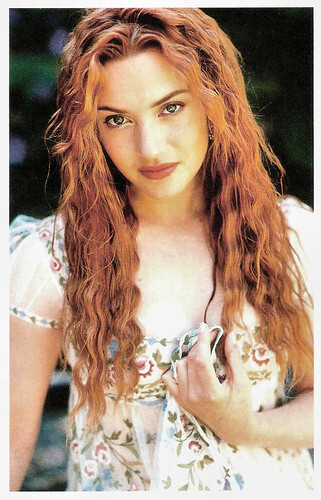
Belgian postcard in the series 'De mooiste vrouwen van de eeuw' by P-Magazine, no. 37. Photo: Sante D'Orazio / Outline.
Vivacious Kate Winslet (1975) is often seen as the best English-speaking film actress of her generation. The English actress and singer was the youngest person to acquire six Academy Award nominations and won the Oscar for The Reader (2008).
No. 36: Raquel Welch
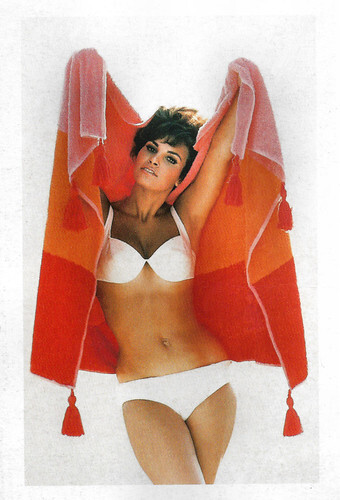
Belgian postcard in de 'De 50 mooiste vrouwen van de eeuw' series by P-Magazine, no. 36. Photo: Sygma / VPM.
American actress Raquel Welch (1940) is one of the icons of the 1960s and 1970s. She first won attention for her role in Fantastic Voyage (1966). In Great Britain, she then made One Million Years B.C. (1966). Although she had only three lines in the film, a poster of Welch in a furry prehistoric bikini became an amazing bestseller and catapulted her to stardom.
No. 33: Brooke Shields

Belgian postcard in de 'De 50 mooiste vrouwen van de eeuw' series by P-Magazine, no. 33. Photo: Isabel Snyder / Outline.
Brooke Shields (1965) is an American actress and model. She was initially a child model and gained critical acclaim at age 12 for her leading role in Louis Malle's film Pretty Baby (1978), in which she played a child prostitute in New Orleans at the beginning of the 20th century. She continued to model and starred in films like The Blue Lagoon (1980), and Franco Zeffirelli's Endless Love (1981). In 1983, Shields suspended her career as a model to attend Princeton University. In the 1990s, Shields returned to acting and appeared in minor roles in films and major roles in series like Suddenly Susan (1996-2000), for which she received two Golden Globe nominations, Lipstick Jungle (2008-2009) and Law & Order: Special Victims Unit (2017-2018).
No. 32: Carmen Electra
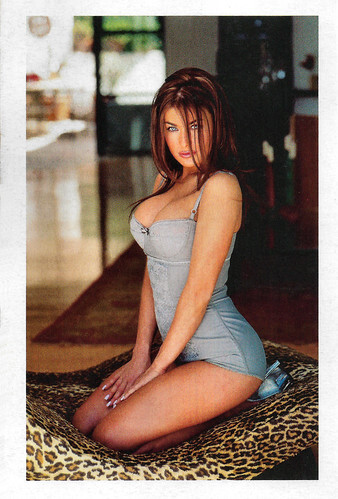
Belgian postcard in de 'De 50 mooiste vrouwen van de eeuw' series by P magazine, no. 32. Photo: McLaren / Isopress.
Carmen Electra (1972) is an American glamour model and actress, who began her career as a singer. Prince produced her debut record. She later appeared in the television series Baywatch (1997-1998). She made her film debut in the horror comedy American Vampire (1997), and has had roles in multiple parody films. Electra was featured several times as a model in Playboy magazine.
No. 20: Kim Basinger
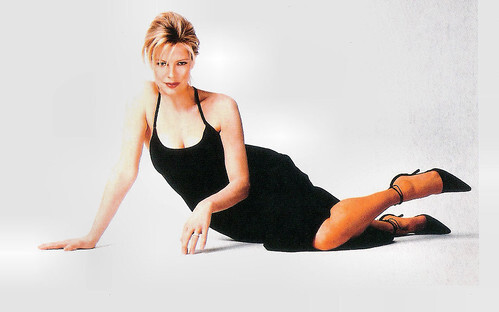
Belgian postcard in de 'De 50 mooiste vrouwen van de eeuw' series by P-Magazine, no. 20. Photo: Sante D'Orazio / Outline.
American film actress and former top model Kim Basinger (1953) won an Oscar for Best Supporting Actress in L.A. Confidential (1997). Her other films include Never Say Never Again (1983), Nine ½ Weeks (1986), Batman (1989), and 8 Mile (2002). She was married to actor Alec Baldwin from 1993 to 2001.
No. 17: Michelle Pfeiffer
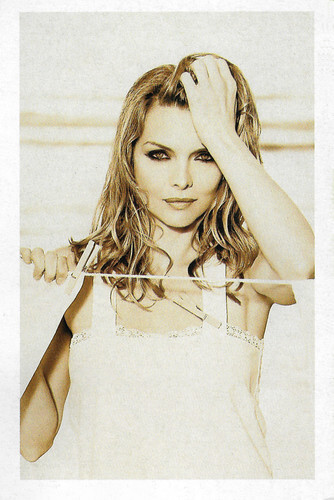
Belgian postcard in de 'De 50 mooiste vrouwen van de eeuw' series by P-Magazine, no. 17. Photo: Visages.
American actress and producer Michelle Pfeiffer (1958) was one of the most popular and talented Hollywood actresses of the 1980s and 1990s. Noted for her versatility as a character actress, Pfeiffer has become particularly known for portraying nuanced and unglamorous, emotionally distant women as well as strong female characters with intense sex appeal.
No. 16: Pamela Anderson
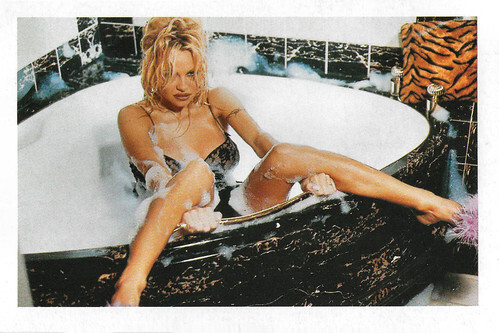
Belgian postcard in de 'De 50 mooiste vrouwen van de eeuw' series by P-Magazine, no. 16. Photo: Lance Staedler / I.D. Press.
Sexy Canadian-American actress and model Pamela Anderson (1967) is best known for the TV series Home Improvement, Baywatch and V.I.P., but the platinum blonde but naturally born brunette also appeared in a dozen of feature films and on a record 14 Playboy covers. Furthermore, she is an international celebrity thanks to her rocky marriages, her animal rights activism and her changing bust sizes.
No. 12: Sharon Stone
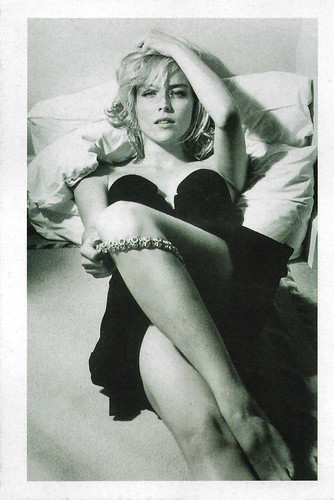
Belgian postcard in de 'De 50 mooiste vrouwen van de eeuw' series by P-Magazine, no. 12. Photo: Bettina Reims.
Sharon Stone (1958) is an American actress, producer, and former fashion model. With her role in Paul Verhoeven's Basic Instinct (1992), she became one of the most talked about actresses of the 1990s, earning both admiration and infamy for her on- and off-screen personae. Cast as an ex-prostitute in Martin Scorsese's Casino (1995), she won an Oscar nomination and a Golden Globe for her work, as well as the general opinion that she was capable of dramatic acting.
No. 7: Demi Moore
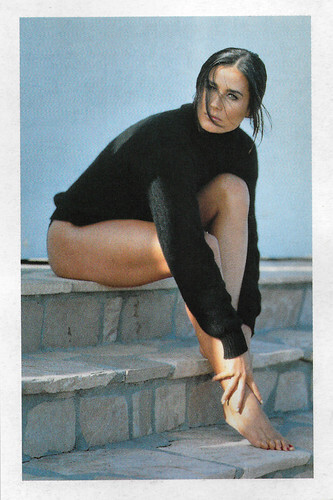
Belgian postcard in the 'De 50 mooiste vrouwen van de eeuw' series by P-Magazine, no. 7. Photo: Lance Steadler / Outline.
Demi Moore (1962) is an American actress and film producer who had her breakthrough with the Bratpack film St. Elmo's Fire (1985). By 1995 Moore was the highest-paid actress in Hollywood thanks to such blockbusters as Ghost (1990), A Few Good Men (1992) and Indecent Proposal (1993).
No. 3: Catherine Zeta-Jones
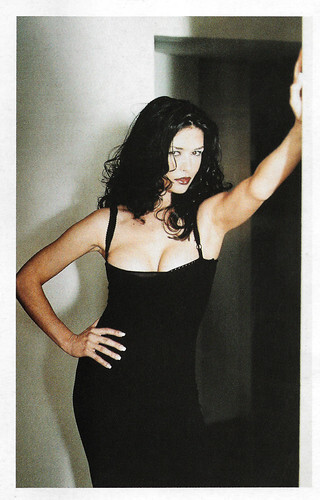
Belgian postcard in the series 'De 50 mooiste vrouwen van de eeuw!' by P-Magazine, no. 3. Photo: Terry Doyle / Outline.
Welsh actress Catherine Zeta-Jones (1969) was typecast as the token pretty girl in British films and therefore relocated to Los Angeles. She established herself in Hollywood with sexy action roles in The Mask of Zorro (1998), Entrapment (1999) and the black comedy Intolerable Cruelty (2003).
No. 1: Cameron Diaz
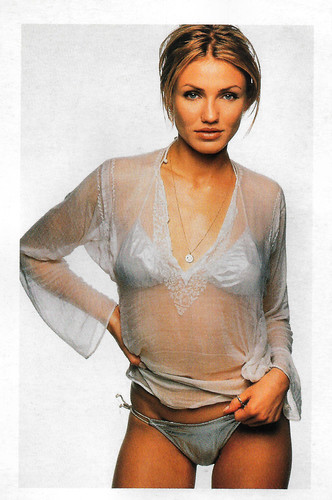
Belgian postcard in de 'De 50 mooiste vrouwen van de eeuw' (The 50 most beautiful women of the century) series by P magazine, no. 1. Photo: Mark Seuger / Outline.
Blue-eyed, natural blonde Cameron Diaz (1972) is a former model and film actress. Her big break arrived in 1994 with the Jim Carrey film The Mask. Roles in My Best Friend's Wedding (1997), There's Something About Mary (1998), and Shrek (2001) – in which she voiced Princess Fiona – solidified her as one of the most bankable Hollywood stars. Her other film credits include hits like Charlie's Angels (2000), Gangs of New York (2003) and In Her Shoes (2005).
Source: Wikipedia (Dutch).
P-Magazine is a former Belgian magazine aimed primarily at a male audience. The magazine started in December 1997 as the successor to the defunct weekly De Nieuwe Panorama. The last paper issue appeared at the beginning of February 2017. The magazine was a Dutch-language weekly (from 2015 a monthly) that covered cars, film, women and games, as well as politics, sociology, science, music and literature. The magazine was best known for its annual 8-week swimming costume special, for which famous Flemish women posed at exotic locations. It also featured more or less well-known female models or persons on the cover every week.
The complete postcard series included several models and TV personalities who were never seen on the screen. So for this post, we selected 13 postcards with beautiful film stars who were popular in the 20th Century.
No. 47: Nastassja Kinski

Belgian postcard in the series 'De 50 mooiste vrouwen van de eeuw!' by P-Magazine, no. 48. Photo: Davis Factor / Outline.
Beautiful German-born actress Nastassja Kinski (1961) has appeared in more than 60 films. Her starring roles include her Golden Globe Award-winning portrayal of the title character in Tess (1979) and parts in Wim Wenders' films Falsche Bewegung/The Wrong Move (1975), Paris, Texas (1984) and In weiter Ferne, so nah!/Faraway, So Close! (1993).
No. 38: Teri Hatcher

Belgian postcard in de 'De 50 mooiste vrouwen van de eeuw' series by P-Magazine, no. 38. Photo: Michael Grecco /I.D. Press. The October 1996 issue of American film magazine Movieline originally had a cover with this picture of Teri Hatcher wearing nothing but rope wrapped around her. This proved too controversial and a second cover picture (of Hatcher in a dress) was substituted.
American actress, writer, presenter and singer Teri Hatcher (1964) is most known as Lois Lane on the television series Lois & Clark: The New Adventures of Superman (1993–1997), as Paris Carver in the James Bond film Tomorrow Never Dies (1997), and as Susan Mayer on the TV series Desperate Housewives (2004–2012). For the latter, she won a Golden Globe Award, three Screen Actors Guild Awards and a nomination for an Emmy Award.
No. 37: Kate Winslet

Belgian postcard in the series 'De mooiste vrouwen van de eeuw' by P-Magazine, no. 37. Photo: Sante D'Orazio / Outline.
Vivacious Kate Winslet (1975) is often seen as the best English-speaking film actress of her generation. The English actress and singer was the youngest person to acquire six Academy Award nominations and won the Oscar for The Reader (2008).
No. 36: Raquel Welch

Belgian postcard in de 'De 50 mooiste vrouwen van de eeuw' series by P-Magazine, no. 36. Photo: Sygma / VPM.
American actress Raquel Welch (1940) is one of the icons of the 1960s and 1970s. She first won attention for her role in Fantastic Voyage (1966). In Great Britain, she then made One Million Years B.C. (1966). Although she had only three lines in the film, a poster of Welch in a furry prehistoric bikini became an amazing bestseller and catapulted her to stardom.
No. 33: Brooke Shields

Belgian postcard in de 'De 50 mooiste vrouwen van de eeuw' series by P-Magazine, no. 33. Photo: Isabel Snyder / Outline.
Brooke Shields (1965) is an American actress and model. She was initially a child model and gained critical acclaim at age 12 for her leading role in Louis Malle's film Pretty Baby (1978), in which she played a child prostitute in New Orleans at the beginning of the 20th century. She continued to model and starred in films like The Blue Lagoon (1980), and Franco Zeffirelli's Endless Love (1981). In 1983, Shields suspended her career as a model to attend Princeton University. In the 1990s, Shields returned to acting and appeared in minor roles in films and major roles in series like Suddenly Susan (1996-2000), for which she received two Golden Globe nominations, Lipstick Jungle (2008-2009) and Law & Order: Special Victims Unit (2017-2018).
No. 32: Carmen Electra

Belgian postcard in de 'De 50 mooiste vrouwen van de eeuw' series by P magazine, no. 32. Photo: McLaren / Isopress.
Carmen Electra (1972) is an American glamour model and actress, who began her career as a singer. Prince produced her debut record. She later appeared in the television series Baywatch (1997-1998). She made her film debut in the horror comedy American Vampire (1997), and has had roles in multiple parody films. Electra was featured several times as a model in Playboy magazine.
No. 20: Kim Basinger

Belgian postcard in de 'De 50 mooiste vrouwen van de eeuw' series by P-Magazine, no. 20. Photo: Sante D'Orazio / Outline.
American film actress and former top model Kim Basinger (1953) won an Oscar for Best Supporting Actress in L.A. Confidential (1997). Her other films include Never Say Never Again (1983), Nine ½ Weeks (1986), Batman (1989), and 8 Mile (2002). She was married to actor Alec Baldwin from 1993 to 2001.
No. 17: Michelle Pfeiffer

Belgian postcard in de 'De 50 mooiste vrouwen van de eeuw' series by P-Magazine, no. 17. Photo: Visages.
American actress and producer Michelle Pfeiffer (1958) was one of the most popular and talented Hollywood actresses of the 1980s and 1990s. Noted for her versatility as a character actress, Pfeiffer has become particularly known for portraying nuanced and unglamorous, emotionally distant women as well as strong female characters with intense sex appeal.
No. 16: Pamela Anderson

Belgian postcard in de 'De 50 mooiste vrouwen van de eeuw' series by P-Magazine, no. 16. Photo: Lance Staedler / I.D. Press.
Sexy Canadian-American actress and model Pamela Anderson (1967) is best known for the TV series Home Improvement, Baywatch and V.I.P., but the platinum blonde but naturally born brunette also appeared in a dozen of feature films and on a record 14 Playboy covers. Furthermore, she is an international celebrity thanks to her rocky marriages, her animal rights activism and her changing bust sizes.
No. 12: Sharon Stone

Belgian postcard in de 'De 50 mooiste vrouwen van de eeuw' series by P-Magazine, no. 12. Photo: Bettina Reims.
Sharon Stone (1958) is an American actress, producer, and former fashion model. With her role in Paul Verhoeven's Basic Instinct (1992), she became one of the most talked about actresses of the 1990s, earning both admiration and infamy for her on- and off-screen personae. Cast as an ex-prostitute in Martin Scorsese's Casino (1995), she won an Oscar nomination and a Golden Globe for her work, as well as the general opinion that she was capable of dramatic acting.
No. 7: Demi Moore

Belgian postcard in the 'De 50 mooiste vrouwen van de eeuw' series by P-Magazine, no. 7. Photo: Lance Steadler / Outline.
Demi Moore (1962) is an American actress and film producer who had her breakthrough with the Bratpack film St. Elmo's Fire (1985). By 1995 Moore was the highest-paid actress in Hollywood thanks to such blockbusters as Ghost (1990), A Few Good Men (1992) and Indecent Proposal (1993).
No. 3: Catherine Zeta-Jones

Belgian postcard in the series 'De 50 mooiste vrouwen van de eeuw!' by P-Magazine, no. 3. Photo: Terry Doyle / Outline.
Welsh actress Catherine Zeta-Jones (1969) was typecast as the token pretty girl in British films and therefore relocated to Los Angeles. She established herself in Hollywood with sexy action roles in The Mask of Zorro (1998), Entrapment (1999) and the black comedy Intolerable Cruelty (2003).
No. 1: Cameron Diaz

Belgian postcard in de 'De 50 mooiste vrouwen van de eeuw' (The 50 most beautiful women of the century) series by P magazine, no. 1. Photo: Mark Seuger / Outline.
Blue-eyed, natural blonde Cameron Diaz (1972) is a former model and film actress. Her big break arrived in 1994 with the Jim Carrey film The Mask. Roles in My Best Friend's Wedding (1997), There's Something About Mary (1998), and Shrek (2001) – in which she voiced Princess Fiona – solidified her as one of the most bankable Hollywood stars. Her other film credits include hits like Charlie's Angels (2000), Gangs of New York (2003) and In Her Shoes (2005).
Source: Wikipedia (Dutch).
Published on October 29, 2022 23:00
October 28, 2022
Tösen fran Stormyrtorpet (1917)
Victor Sjöström, one of the great pioneers of silent Scandinavian cinema, made several fascinating films in Sweden between 1912 and 1922 when Hollywood devoured him. One of these was Tösen från Stormyrtorpet/The Girl from the Marsh Croft (Victor Sjöström, 1917), starring Greta Almroth, Lars Hanson and Karin Molander. The film, produced by Svenska Biografteatern AB, was the first of Sjöström's several film adaptations of Selma Lagerlöf's literary works, heralding the first significant phase of Swedish cinema in film history. The sepia postcards were published by Förlag Nordisk Konst in Stockholm.

Swedish postcard by Nordisk Konst, Stockholm, no. 843/1. Photo: Svenska Biografteatern AB. Gösta Cederlund as Per Månsson, Greta Almroth as Helga and William Larsson as her father in Tösen från Stormyrtorpet/The Girl from the Marsh Croft (Victor Sjöström, 1917). The woman in the back may be Edla Rothgardt, who plays Per Månsson's wife. Caption: At the house of Per Månsson at Västgården.
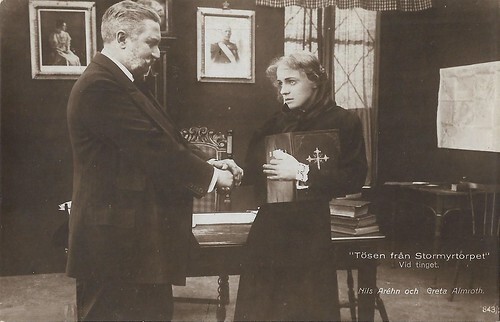
Swedish postcard by Nordisk Konst, Stockholm, no. 843/2. Photo: Svenska Biografteatern AB. Greta Almroth as Helga and Nils Aréhn as the Judge in Tösen från Stormyrtorpet/The Girl from the Marsh Croft (Victor Sjöström, 1917). Caption: At the courtcase.

Swedish postcard by Nordisk Konst, Stockholm, no. 843/3. Photo: Svenska Biografteatern AB. Lars Hanson and Greta Almroth in Tösen från Stormyrtorpet/The Girl from the Marsh Croft (Victor Sjöström, 1917). Caption: Outside of the courthouse.
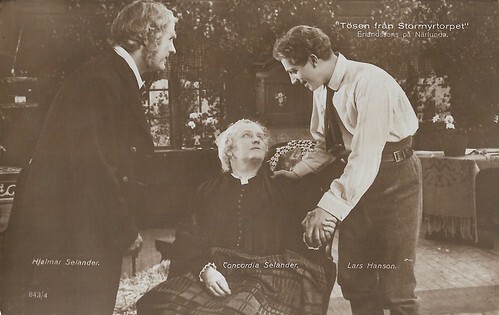
Swedish postcard by Nordisk Konst, Stockholm, no. 843/4. Photo: Svenska Biografteatern AB. Lars Hanson , Concordia Selander and Hjalmar Selander in Tösen från Stormyrtorpet/The Girl from the Marsh Croft (Victor Sjöström, 1917). Caption: Erlandsson at Närlunda.
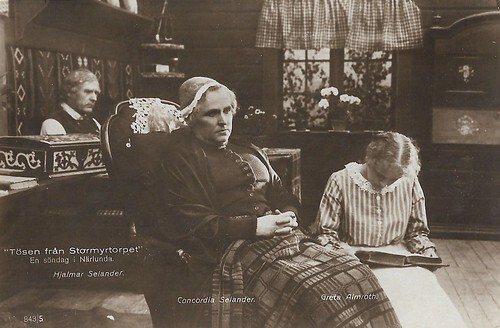
Swedish postcard by Nordisk Konst, Stockholm, no. 843/5. Photo: Svenska Biografteatern AB. Greta Almroth, Concordia Selander and Hjalmar Selander in Tösen från Stormyrtorpet/The Girl from the Marsh Croft (Victor Sjöström, 1917). Caption: Sundays at Närlunda.
Profound intimacy
Helga Nilsson (Greta Almroth), the daughter of a poor farmer from the moors, starts working for Per Martinsson (Gösta Cederlund) as a maid. Although married, Martinsson cannot keep his hands off the pretty young maid and seduces her. When Helga becomes pregnant by him, however, Per abandons her and is even prepared to commit perjury in court when it comes to a lawsuit and, in the trial, to establish paternity. Helga is able to stop him at the last moment from swearing on the Bible that he is not the child's father and subsequently withdraws her complaint.
Gudmund Erlandsson ( Lars Hanson ), who attends the court hearing and is the future groom of the alderman's daughter Hildur Persson (Karin Molander), is deeply impressed by Helga's behaviour and tells his mother Ingeborg about Helga's fate. Before Helga can commit an act of desperation and kill herself in view of the "shame" of having borne an illegitimate child, Gudmund's parents take her on as a new maid on their farm. Gudmund's fiancée Hildur is the exact opposite of Helga: spoilt and exalted, and she meets Helga, whose good relationship with Gudmund is a thorn in her side, with increasing rejection. Thus Helga's stay with the Erlandssons is also only temporary.
Gudmund begins to drink without restraint in view of the fact that his future wife is doing worse and worse in comparison to Helga. In this state, he is involved in a violent scuffle one day, which ends fatally for Martinsson. When Gudmund wakes up the next morning, Per is dead, stabbed to death. Gudmund's knife blade is broken off, and Gudmund, who cannot remember anything due to alcohol consumption, then believes that he must have been the murderer of Helga's seducer. He confesses to his own father the crime he did not commit. When Hildur and her family learn of these circumstances, they immediately call off the upcoming wedding. Hildur now shows her true colours and has only contempt for her fiancé.
Gudmund, who is sure that he will now have to go to prison, visits Helga one last time and talks about the crime and the knife with the broken blade. Helga immediately realises that there has been a mistake and tells Gudmund that she herself broke off the blade when she used his knife for carving the day before. Although Helga loves Gudmund, she only wants his happiness, and since she does not want Gudmund's relationship with Hildur to fall apart because of this misunderstanding, she rushes to her to explain the true facts. Hildur, in turn, recognises in Helga's actions that Helga loves her ex and that she herself will never evoke such profound intimacy in Gudmund. And so she goes to him and tells the young Erlandsson about Helga's feelings. Gudmund, in turn, has long since realised that Hildur, who only speculated on his family's wealth, would have been the wrong choice of wife either way. Now, at last, the way is clear for a future together for Helga, the girl from the moors, and Gudmund Erlandsson.
Lars Hanson (1886-1965) was a highly successful Swedish film and stage actor mostly remembered for his motion picture roles during the silent film era, both in Scandinavia and Hollywood. Karin Molander (1889–1978), who plays Hildur, was a star in silent Scandinavian cinema and the real-life wife of Lars Hanson (Gudmund). In the films of Mauritz Stiller, the Swedish actress became a symbol of the modern, young and emancipated women of the 1910s. Swedish stage and screen actress Greta Almroth (1888-1981), who plays Helga was one of the Swedish silent cinema's first big stars. She participated in just over 30 films, including Hans Nåds testamente/His Grace's Testament (Victor Sjöström, 1919) and Prästänkan/The Parson's Wife (1920).
The film is based on the novel 'Tösen från Stormyrtorpet', published in 1908 in the collection 'En saga om en saga och andra sagor'and written by popular Swedish author Selma Lagerlof, who was receiving international attention as the first woman to get a Nobel Prize for literature. This was the first time she had one of her books made into a film. Tösen från Stormyrtorpet (Victor Sjöström, 1917) was originally released in the US as The Girl from the March Croft and the UK as The Woman He Chose. However it is today generally referred to as The Lass from the Stormy Croft, which is closer to the original Swedish title. Six other adaptions of the same novel have been made, a German and a Turkish in 1935, a Finnish in 1940, another Swedish in 1947, a Danish (Husmandstøsen) in 1952 and another German in 1958.

Swedish postcard by Förlag Nordisk Konst, Stockholm, no. 843/6. Photo: Svenska Biografteatern AB. Karin Molander in Tösen från Stormyrtorpet/The Girl from the Marsh Croft (Victor Sjöström, 1917). Caption: The alderman's daughter Hildur from Alvakra.
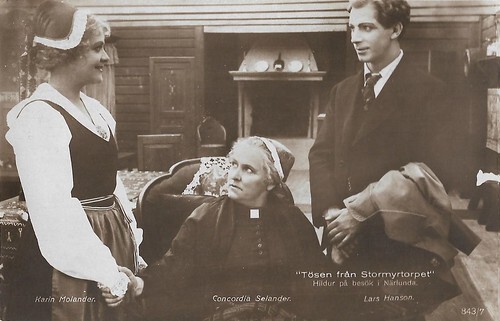
Swedish postcard by Nordisk Konst, Stockholm, no. 843/7. Photo: Svenska Biografteatern AB. Karin Molander , Lars Hanson and Concordia Selander in Tösen från Stormyrtorpet/The Girl from the Marsh Croft (Victor Sjöström, 1917). Caption: Hildur visits Närlunda.

Swedish postcard by Nordisk Konst, Stockholm, no. 843/8. Photo: Svenska Biografteatern AB. Karin Molander and Lars Hanson in Tösen från Stormyrtorpet/The Girl from the Marsh Croft (Victor Sjöström, 1917). Caption: Gudmund Erlandsson and Hildur Eriksdotter.
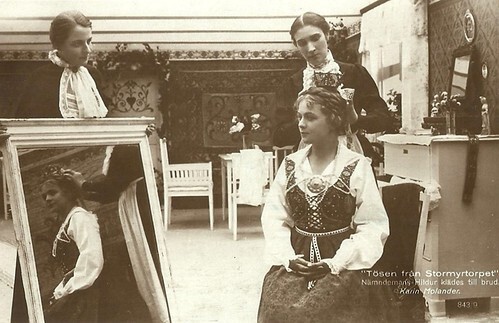
Swedish postcard by Nordisk Konst, Stockholm, no. 843/9. Photo: Svenska Biografteatern AB. Karin Molander in Tösen från Stormyrtorpet/The Girl from the Marsh Croft (Victor Sjöström, 1917). Caption: Hildur dressed up as bride.
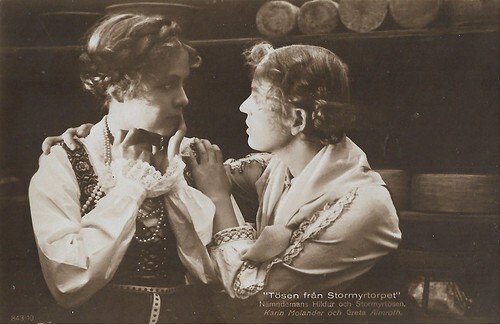
Swedish postcard by Nordisk Konst, Stockholm, no. 843/10. Photo: Svenska Biografteatern AB. Karin Molander and Greta Almroth in Tösen från Stormyrtorpet/The Girl from the Marsh Croft (Victor Sjöström, 1917). Caption: Alderman's daughter Hildur and the Marsh Girl.
Sources: Wikipedia (English and Swedish) and IMDb.

Swedish postcard by Nordisk Konst, Stockholm, no. 843/1. Photo: Svenska Biografteatern AB. Gösta Cederlund as Per Månsson, Greta Almroth as Helga and William Larsson as her father in Tösen från Stormyrtorpet/The Girl from the Marsh Croft (Victor Sjöström, 1917). The woman in the back may be Edla Rothgardt, who plays Per Månsson's wife. Caption: At the house of Per Månsson at Västgården.

Swedish postcard by Nordisk Konst, Stockholm, no. 843/2. Photo: Svenska Biografteatern AB. Greta Almroth as Helga and Nils Aréhn as the Judge in Tösen från Stormyrtorpet/The Girl from the Marsh Croft (Victor Sjöström, 1917). Caption: At the courtcase.

Swedish postcard by Nordisk Konst, Stockholm, no. 843/3. Photo: Svenska Biografteatern AB. Lars Hanson and Greta Almroth in Tösen från Stormyrtorpet/The Girl from the Marsh Croft (Victor Sjöström, 1917). Caption: Outside of the courthouse.

Swedish postcard by Nordisk Konst, Stockholm, no. 843/4. Photo: Svenska Biografteatern AB. Lars Hanson , Concordia Selander and Hjalmar Selander in Tösen från Stormyrtorpet/The Girl from the Marsh Croft (Victor Sjöström, 1917). Caption: Erlandsson at Närlunda.

Swedish postcard by Nordisk Konst, Stockholm, no. 843/5. Photo: Svenska Biografteatern AB. Greta Almroth, Concordia Selander and Hjalmar Selander in Tösen från Stormyrtorpet/The Girl from the Marsh Croft (Victor Sjöström, 1917). Caption: Sundays at Närlunda.
Profound intimacy
Helga Nilsson (Greta Almroth), the daughter of a poor farmer from the moors, starts working for Per Martinsson (Gösta Cederlund) as a maid. Although married, Martinsson cannot keep his hands off the pretty young maid and seduces her. When Helga becomes pregnant by him, however, Per abandons her and is even prepared to commit perjury in court when it comes to a lawsuit and, in the trial, to establish paternity. Helga is able to stop him at the last moment from swearing on the Bible that he is not the child's father and subsequently withdraws her complaint.
Gudmund Erlandsson ( Lars Hanson ), who attends the court hearing and is the future groom of the alderman's daughter Hildur Persson (Karin Molander), is deeply impressed by Helga's behaviour and tells his mother Ingeborg about Helga's fate. Before Helga can commit an act of desperation and kill herself in view of the "shame" of having borne an illegitimate child, Gudmund's parents take her on as a new maid on their farm. Gudmund's fiancée Hildur is the exact opposite of Helga: spoilt and exalted, and she meets Helga, whose good relationship with Gudmund is a thorn in her side, with increasing rejection. Thus Helga's stay with the Erlandssons is also only temporary.
Gudmund begins to drink without restraint in view of the fact that his future wife is doing worse and worse in comparison to Helga. In this state, he is involved in a violent scuffle one day, which ends fatally for Martinsson. When Gudmund wakes up the next morning, Per is dead, stabbed to death. Gudmund's knife blade is broken off, and Gudmund, who cannot remember anything due to alcohol consumption, then believes that he must have been the murderer of Helga's seducer. He confesses to his own father the crime he did not commit. When Hildur and her family learn of these circumstances, they immediately call off the upcoming wedding. Hildur now shows her true colours and has only contempt for her fiancé.
Gudmund, who is sure that he will now have to go to prison, visits Helga one last time and talks about the crime and the knife with the broken blade. Helga immediately realises that there has been a mistake and tells Gudmund that she herself broke off the blade when she used his knife for carving the day before. Although Helga loves Gudmund, she only wants his happiness, and since she does not want Gudmund's relationship with Hildur to fall apart because of this misunderstanding, she rushes to her to explain the true facts. Hildur, in turn, recognises in Helga's actions that Helga loves her ex and that she herself will never evoke such profound intimacy in Gudmund. And so she goes to him and tells the young Erlandsson about Helga's feelings. Gudmund, in turn, has long since realised that Hildur, who only speculated on his family's wealth, would have been the wrong choice of wife either way. Now, at last, the way is clear for a future together for Helga, the girl from the moors, and Gudmund Erlandsson.
Lars Hanson (1886-1965) was a highly successful Swedish film and stage actor mostly remembered for his motion picture roles during the silent film era, both in Scandinavia and Hollywood. Karin Molander (1889–1978), who plays Hildur, was a star in silent Scandinavian cinema and the real-life wife of Lars Hanson (Gudmund). In the films of Mauritz Stiller, the Swedish actress became a symbol of the modern, young and emancipated women of the 1910s. Swedish stage and screen actress Greta Almroth (1888-1981), who plays Helga was one of the Swedish silent cinema's first big stars. She participated in just over 30 films, including Hans Nåds testamente/His Grace's Testament (Victor Sjöström, 1919) and Prästänkan/The Parson's Wife (1920).
The film is based on the novel 'Tösen från Stormyrtorpet', published in 1908 in the collection 'En saga om en saga och andra sagor'and written by popular Swedish author Selma Lagerlof, who was receiving international attention as the first woman to get a Nobel Prize for literature. This was the first time she had one of her books made into a film. Tösen från Stormyrtorpet (Victor Sjöström, 1917) was originally released in the US as The Girl from the March Croft and the UK as The Woman He Chose. However it is today generally referred to as The Lass from the Stormy Croft, which is closer to the original Swedish title. Six other adaptions of the same novel have been made, a German and a Turkish in 1935, a Finnish in 1940, another Swedish in 1947, a Danish (Husmandstøsen) in 1952 and another German in 1958.

Swedish postcard by Förlag Nordisk Konst, Stockholm, no. 843/6. Photo: Svenska Biografteatern AB. Karin Molander in Tösen från Stormyrtorpet/The Girl from the Marsh Croft (Victor Sjöström, 1917). Caption: The alderman's daughter Hildur from Alvakra.

Swedish postcard by Nordisk Konst, Stockholm, no. 843/7. Photo: Svenska Biografteatern AB. Karin Molander , Lars Hanson and Concordia Selander in Tösen från Stormyrtorpet/The Girl from the Marsh Croft (Victor Sjöström, 1917). Caption: Hildur visits Närlunda.

Swedish postcard by Nordisk Konst, Stockholm, no. 843/8. Photo: Svenska Biografteatern AB. Karin Molander and Lars Hanson in Tösen från Stormyrtorpet/The Girl from the Marsh Croft (Victor Sjöström, 1917). Caption: Gudmund Erlandsson and Hildur Eriksdotter.

Swedish postcard by Nordisk Konst, Stockholm, no. 843/9. Photo: Svenska Biografteatern AB. Karin Molander in Tösen från Stormyrtorpet/The Girl from the Marsh Croft (Victor Sjöström, 1917). Caption: Hildur dressed up as bride.

Swedish postcard by Nordisk Konst, Stockholm, no. 843/10. Photo: Svenska Biografteatern AB. Karin Molander and Greta Almroth in Tösen från Stormyrtorpet/The Girl from the Marsh Croft (Victor Sjöström, 1917). Caption: Alderman's daughter Hildur and the Marsh Girl.
Sources: Wikipedia (English and Swedish) and IMDb.
Published on October 28, 2022 22:00
October 27, 2022
Veronica Lake
During the 1940s, Veronica Lake (1922-1973) was Hollywood's Peek-a-boo Girl. We love her for Sullivan's Travels (1942), I Married a Witch (1942) and for her femme fatale roles opposite Alan Ladd in the Film Noirs This Gun for Hire (1942), The Glass Key (1942) and The Blue Dahlia (George Marshall, 1946).
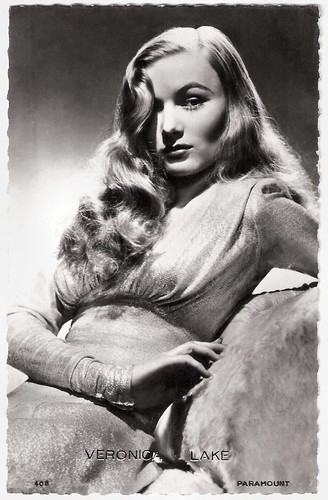
French postcard by Editions P.I., Paris, no. 408, 1952. Photo: George Hurrell / Paramount. Veronica Lake in This Gun for Hire (Frank Tuttle, 1942).
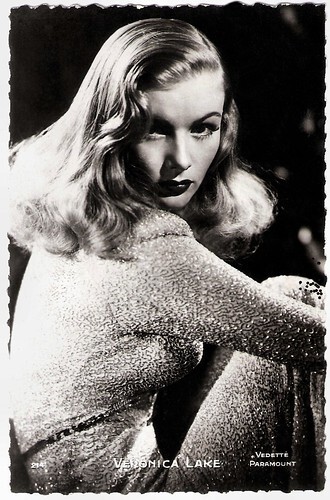
French postcard by Editions P.I., Paris, no. 214. Photo: Eugene Robert Richee / Paramount. Publicity still for I Wanted Wings (Mitchell Leisen, 1941).
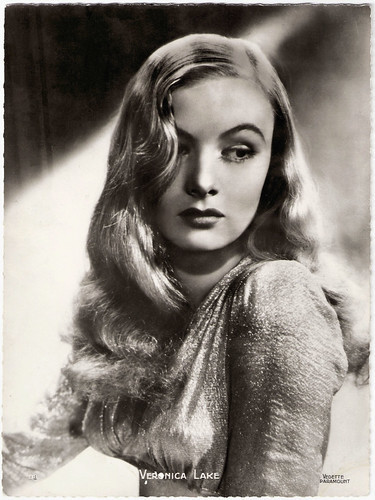
Big Belgian card by Chocolaterie Clovis, Pepinster. Photo: George Hurrell / Paramount. Publicity still for This Gun for Hire (Frank Tuttle, 1942).
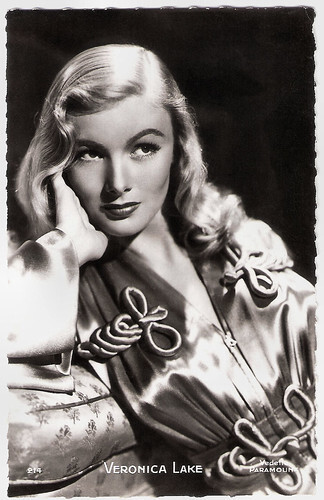
French postcard by Editions P.I., Paris, offered by S.A. Victoria, Brussels, no. 214, 1950. Photo: Paramount.
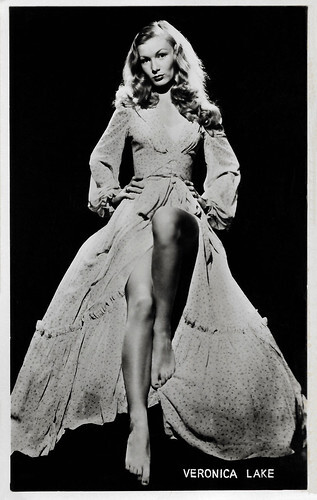
Dutch postcard, no. 1. Photo: Metro-Goldwyn-Mayer.
Peek-a-boo bang
Veronica Lake was born Constance Frances Marie Ockelman in Brooklyn, New York, in 1922. Lake grew up in poor circumstances. Her father, Harry Eugene Ockelman, worked for an oil company aboard a ship. He died in an oil tanker explosion in 1932. The following year, Lake's mother, Constance Frances Charlotta (née Trimble), married Anthony Keane, a newspaper staff artist and Lake began using his surname.
She moved with her mother from Miami to Beverly Hills after high school. At 16, she attended an acting school there and her career began not much later. In 1939 she had a small role as one of several students in the film Sorority House (John Farrow, 1939). Farrow introduced her to Paramount Pictures producer Arthur Hornblow Jr. who gave her the stage name Veronica Lake.
In Forty Little Mothers (Busby Berkeley, 1940), she let her hair down on the screen for the first time. In 1941, she was signed by Paramount. Lake received the supporting role of a nightclub singer in the military drama I Wanted Wings (Mitchell Leisen, 1941), starring Ray Milland and William Holden . Although her part was small, Lake ultimately stole the show and although still in her teens, Lake became a star. It was during the filming of I Wanted Wings that she developed her signature look. Audiences were especially fascinated by her hairstyle which became famous under the name 'peek-a-boo bang' and the studio presented her as 'the peek-a-boo girl'.
She starred in the Film Noir This Gun for Hire (Frank Tuttle, 1942). Robert Preston was her love interest, but she shared more scenes with Alan Ladd . The two were so popular together that they would be reteamed in lead roles for three more films, including The Glass Key (Frank Tuttle, 1942). Lake had another good role in the comedy Sullivan's Travels (Preston Sturges, 1941) alongside Joel McCrea. She starred with Fredric March in the title role of the comedy I Married a Witch (René Clair, 1942). Lake had a cameo in the all-star propaganda revue Star Spangled Rhythm (George Marshall, a.o., 1943). She sang the song 'A Sweater, a Sarong and a Peek-A-Boo' alongside Dorothy Lamour and Paulette Goddard .
In the same year, she had one of her best roles in So Proudly We Hail! (Mark Sandrich, 1943) alongside Claudette Colbert and again Paulette Goddard . The drama about nurses who are trapped by the Japanese in Bataan and suffer a terrible fate was one of the first Hollywood productions to depict the everyday lives of female army personnel. She also became a popular pin-up girl for soldiers during World War II and travelled throughout the United States to raise money for war bonds.
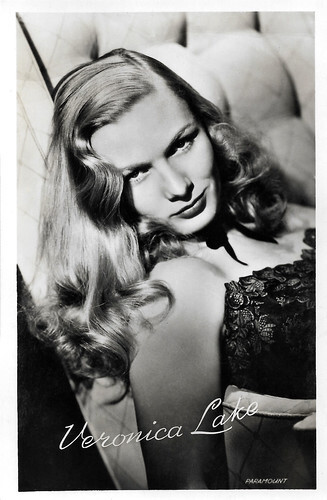
Dutch postcard by Foto-archief Film en Toneel, no. 3443. Photo: Paramount.
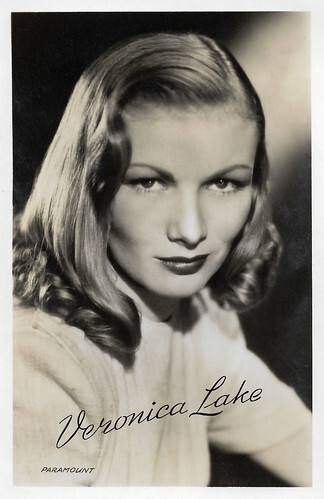
Vintage postcard, no. 354. Photo: Paramount.
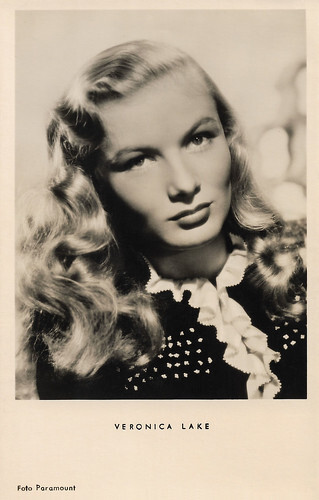
West-German postcard by Kunst und Bild, Berlin, no. A 361. Photo: Paramount.
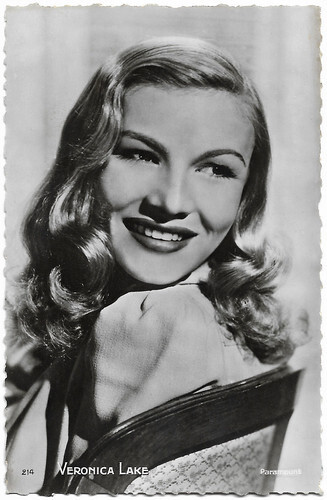
Vintage postcard by Editions P.I., Paris, no. 214. Photo: Paramount.
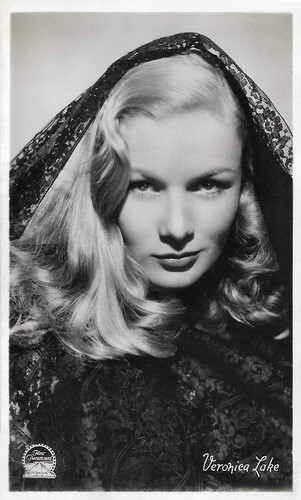
Belgian card by Fotoprim, Brussels, for De Beukelaer, Antwerp, no. A 33. Photo: Paramount.
Public drunkenness and disorderly conduct
Veronica Lake's Peek-a-Boo hairstyle was a sensation and was copied millions of times. But when accidents occurred in factories because workers got their hair caught in the production machines and were scalped, the US government asked Lake to wear a different hairstyle. Curiously, Lake's career was over soon after. One of her last significant roles was alongside Alan Ladd in The Blue Dahlia (George Marshall, 1946), based on an original screenplay by Raymond Chandler.
Although popular, Lake was known to be difficult to work with. During the filming of The Blue Dahlia (1946), Raymond Chandler referred to her as "Moronica Lake". Psychological problems are said to have been the reason for her behaviour. She also drank heavily and later became an alcoholic. Her contract with Paramount was not renewed because of this.
She made her first film outside Paramount since she became a star, a Western, Ramrod (1947), directed by her then-husband André De Toth, which reunited her with Joel McCrea. Lake had a career in the television industry in the first half of the 1950s. She performed in summer stock theatre and in stage roles in England, but after she broke her ankle, she had to quit.
She deteriorated more and more, both mentally and physically. After her third divorce, Lake drifted between cheap hotels in New York City and was arrested several times for public drunkenness and disorderly conduct. In the early 1960s, she worked as a waitress in the cocktail lounge of the hotel where she lived. She was diagnosed with paranoia in the 1960s.
In 1966 she tried to make a comeback with the low-budget independent Canadian thriller Footsteps in the Snow (Martin Green, 1966). Her last film was the horror film Flesh Feast (Brad F. Grinter, 1970) for which she also acted as producer. It was filmed in 1967 but not released until 1970. Both films failed to revitalise her career. Lake's memoirs, 'Veronica: The Autobiography of Veronica Lake', which she dictated to the writer Donald Bain, were published in the United Kingdom in 1969, and in the United States the following year. In the book, Lake discusses her career, her failed marriages, her romances with Howard Hughes, Tommy Manville and Aristotle Onassis, her alcoholism, and her guilt over not spending enough time with her children.
Only 50, Veronica Lake died of a liver infection in Burlington, Vermont, in 1973. It was a consequence of her decades-long alcoholism. Veronica Lake was married four times, in her first marriage to director John S. Detlie and in her second marriage to director André De Toth. Her body was cremated and scattered off the coast of Florida.
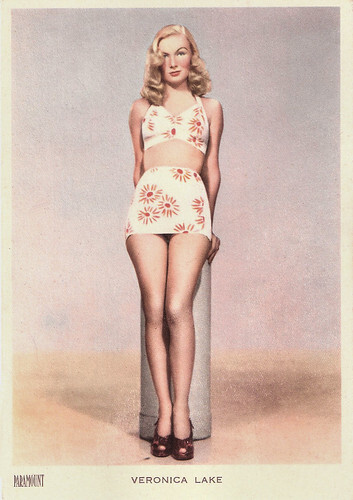
Vintage postcard by GM. Photo: Paramount.
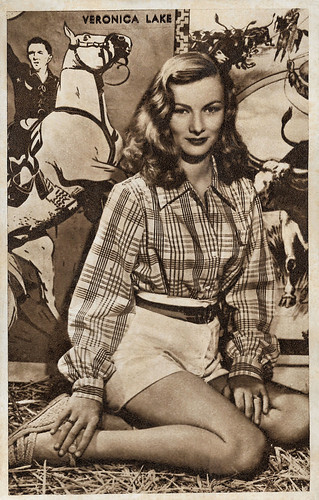
Vintage card.
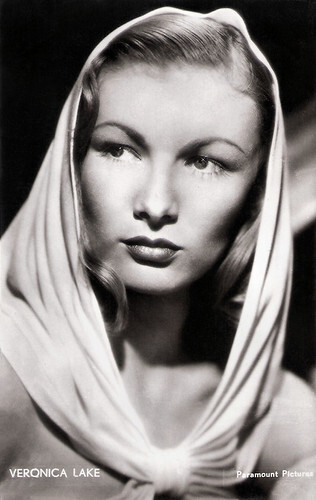
Vintage postcard, no. AX 164. Photo: Paramount Pictures.
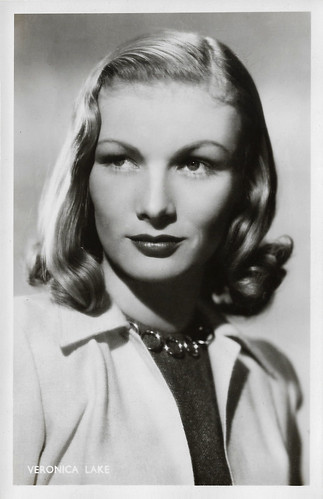
Dutch postcard.
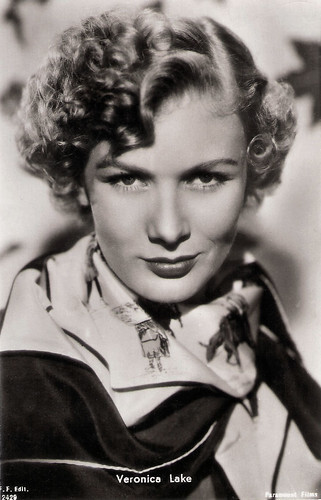
Italian postcard by B.F.F. Edit. (Casa Editr. Ballerini & Fratini, Firenze), no. 2429. Photo: Paramount. Sadly, a former owner cut the edges of this card.
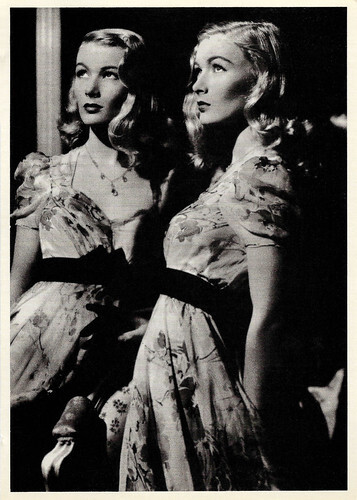
British postcard by Moviestar, no. F 04.
Sources: Wikipedia (Dutch and English), and .

French postcard by Editions P.I., Paris, no. 408, 1952. Photo: George Hurrell / Paramount. Veronica Lake in This Gun for Hire (Frank Tuttle, 1942).

French postcard by Editions P.I., Paris, no. 214. Photo: Eugene Robert Richee / Paramount. Publicity still for I Wanted Wings (Mitchell Leisen, 1941).

Big Belgian card by Chocolaterie Clovis, Pepinster. Photo: George Hurrell / Paramount. Publicity still for This Gun for Hire (Frank Tuttle, 1942).

French postcard by Editions P.I., Paris, offered by S.A. Victoria, Brussels, no. 214, 1950. Photo: Paramount.

Dutch postcard, no. 1. Photo: Metro-Goldwyn-Mayer.
Peek-a-boo bang
Veronica Lake was born Constance Frances Marie Ockelman in Brooklyn, New York, in 1922. Lake grew up in poor circumstances. Her father, Harry Eugene Ockelman, worked for an oil company aboard a ship. He died in an oil tanker explosion in 1932. The following year, Lake's mother, Constance Frances Charlotta (née Trimble), married Anthony Keane, a newspaper staff artist and Lake began using his surname.
She moved with her mother from Miami to Beverly Hills after high school. At 16, she attended an acting school there and her career began not much later. In 1939 she had a small role as one of several students in the film Sorority House (John Farrow, 1939). Farrow introduced her to Paramount Pictures producer Arthur Hornblow Jr. who gave her the stage name Veronica Lake.
In Forty Little Mothers (Busby Berkeley, 1940), she let her hair down on the screen for the first time. In 1941, she was signed by Paramount. Lake received the supporting role of a nightclub singer in the military drama I Wanted Wings (Mitchell Leisen, 1941), starring Ray Milland and William Holden . Although her part was small, Lake ultimately stole the show and although still in her teens, Lake became a star. It was during the filming of I Wanted Wings that she developed her signature look. Audiences were especially fascinated by her hairstyle which became famous under the name 'peek-a-boo bang' and the studio presented her as 'the peek-a-boo girl'.
She starred in the Film Noir This Gun for Hire (Frank Tuttle, 1942). Robert Preston was her love interest, but she shared more scenes with Alan Ladd . The two were so popular together that they would be reteamed in lead roles for three more films, including The Glass Key (Frank Tuttle, 1942). Lake had another good role in the comedy Sullivan's Travels (Preston Sturges, 1941) alongside Joel McCrea. She starred with Fredric March in the title role of the comedy I Married a Witch (René Clair, 1942). Lake had a cameo in the all-star propaganda revue Star Spangled Rhythm (George Marshall, a.o., 1943). She sang the song 'A Sweater, a Sarong and a Peek-A-Boo' alongside Dorothy Lamour and Paulette Goddard .
In the same year, she had one of her best roles in So Proudly We Hail! (Mark Sandrich, 1943) alongside Claudette Colbert and again Paulette Goddard . The drama about nurses who are trapped by the Japanese in Bataan and suffer a terrible fate was one of the first Hollywood productions to depict the everyday lives of female army personnel. She also became a popular pin-up girl for soldiers during World War II and travelled throughout the United States to raise money for war bonds.

Dutch postcard by Foto-archief Film en Toneel, no. 3443. Photo: Paramount.

Vintage postcard, no. 354. Photo: Paramount.

West-German postcard by Kunst und Bild, Berlin, no. A 361. Photo: Paramount.

Vintage postcard by Editions P.I., Paris, no. 214. Photo: Paramount.

Belgian card by Fotoprim, Brussels, for De Beukelaer, Antwerp, no. A 33. Photo: Paramount.
Public drunkenness and disorderly conduct
Veronica Lake's Peek-a-Boo hairstyle was a sensation and was copied millions of times. But when accidents occurred in factories because workers got their hair caught in the production machines and were scalped, the US government asked Lake to wear a different hairstyle. Curiously, Lake's career was over soon after. One of her last significant roles was alongside Alan Ladd in The Blue Dahlia (George Marshall, 1946), based on an original screenplay by Raymond Chandler.
Although popular, Lake was known to be difficult to work with. During the filming of The Blue Dahlia (1946), Raymond Chandler referred to her as "Moronica Lake". Psychological problems are said to have been the reason for her behaviour. She also drank heavily and later became an alcoholic. Her contract with Paramount was not renewed because of this.
She made her first film outside Paramount since she became a star, a Western, Ramrod (1947), directed by her then-husband André De Toth, which reunited her with Joel McCrea. Lake had a career in the television industry in the first half of the 1950s. She performed in summer stock theatre and in stage roles in England, but after she broke her ankle, she had to quit.
She deteriorated more and more, both mentally and physically. After her third divorce, Lake drifted between cheap hotels in New York City and was arrested several times for public drunkenness and disorderly conduct. In the early 1960s, she worked as a waitress in the cocktail lounge of the hotel where she lived. She was diagnosed with paranoia in the 1960s.
In 1966 she tried to make a comeback with the low-budget independent Canadian thriller Footsteps in the Snow (Martin Green, 1966). Her last film was the horror film Flesh Feast (Brad F. Grinter, 1970) for which she also acted as producer. It was filmed in 1967 but not released until 1970. Both films failed to revitalise her career. Lake's memoirs, 'Veronica: The Autobiography of Veronica Lake', which she dictated to the writer Donald Bain, were published in the United Kingdom in 1969, and in the United States the following year. In the book, Lake discusses her career, her failed marriages, her romances with Howard Hughes, Tommy Manville and Aristotle Onassis, her alcoholism, and her guilt over not spending enough time with her children.
Only 50, Veronica Lake died of a liver infection in Burlington, Vermont, in 1973. It was a consequence of her decades-long alcoholism. Veronica Lake was married four times, in her first marriage to director John S. Detlie and in her second marriage to director André De Toth. Her body was cremated and scattered off the coast of Florida.

Vintage postcard by GM. Photo: Paramount.

Vintage card.

Vintage postcard, no. AX 164. Photo: Paramount Pictures.

Dutch postcard.

Italian postcard by B.F.F. Edit. (Casa Editr. Ballerini & Fratini, Firenze), no. 2429. Photo: Paramount. Sadly, a former owner cut the edges of this card.

British postcard by Moviestar, no. F 04.
Sources: Wikipedia (Dutch and English), and .
Published on October 27, 2022 22:00
October 26, 2022
Laurent Terzieff
During the 1960s and 1970s handsome French actor Laurent Terzieff (1935-2010) starred in many films by noted French and Italian directors. The magnetic and politically engaged actor began his film career as one of the existential youth in Les Tricheurs (1958) and later often portrayed cynical bohemians or political activists.
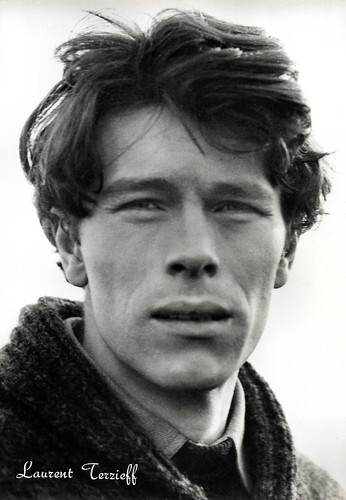
Italian postcard by Rotalfoto, Milano, no. 996.
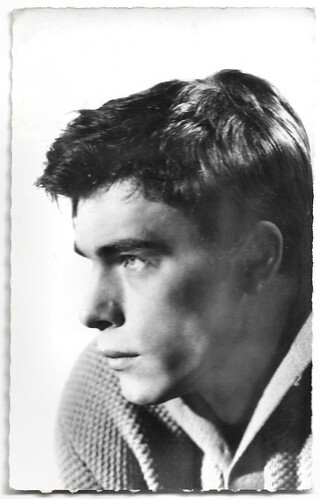
French postcard by Editions du Globe, Paris, no. 776. Photo: Studio Vauclair.
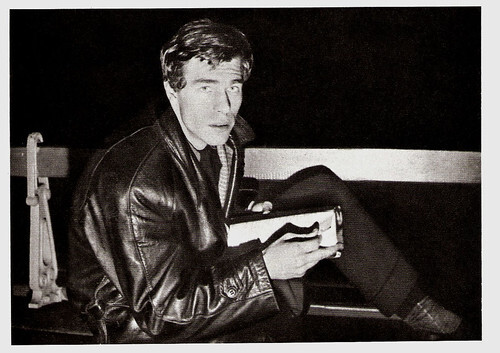
French Postcard by Editions La Malibran, Paris, no. T 2. Photo: Claude Schwartz.
Bohemian and cynical student
Laurent Terzieff was born Laurent Didier Alex Laurent Tchemerzine in 1935 in Toulouse, France. He was the son of a French visual artist and a Russian sculptor who had emigrated to France during the First World War.
The spectacle of the bombardments during WW II had a dramatic effect on nine-year-old Laurent. As an adolescent, he was fascinated with philosophy and poetry.
He assisted director Roger Blin with the production of the play La Sonate des spectres (The Ghost Sonata) by August Strindberg. Then and there, he decided to become an actor.
Terzieff made his debut in 1953 with the Theatre of Babylon in Tous contre Adamov (All Against Adamov) by Jean-Marie Serreau. His film début was opposite Yves Montand in Premier mai/The First of May (Luis Saslavsky, 1958).
A year earlier, he had gained some notoriety playing a role as an assassin in L'affaire Weidmann/The Weidmann case (Jean Prat, 1957), an episode of the TV series En votre âme et conscience/conscience (1954-1969).
Legendary director Marcel Carné spotted him and offered him a leading role opposite Pascale Petit , Jacques Charrier and Jean-Paul Belmondo in Les Tricheurs/The Cheats (Marcel Carné, 1958), a portrait of the existentialist youth in the late 1950s.
At AllMovie , Hal Erickson writes: “Carné's youthful characters are not so many people as symbols of the postwar relaxation of worldwide manners and mores. In anticipation of the hippie flicks of the 1960s, the main characters indulge in a great deal of sex, but abstain from true love and commitment, citing these things as irrelevant in a world full of instant gratification.“
Les Tricheurs was Terzieff’s breakthrough in the cinema. For a long time, the public would identify him with the bohemian and cynical student.
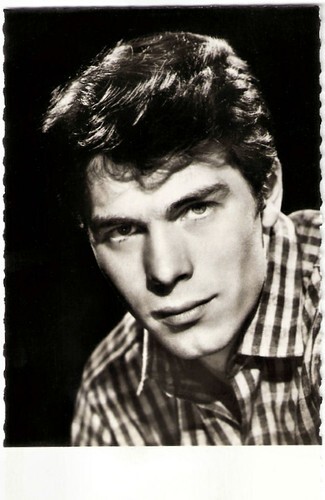
French Postcard by Editions P.I., Paris, offered by Les Carbones Korès 'Carboplane', no. 1007. Photo: Studio Vallois.
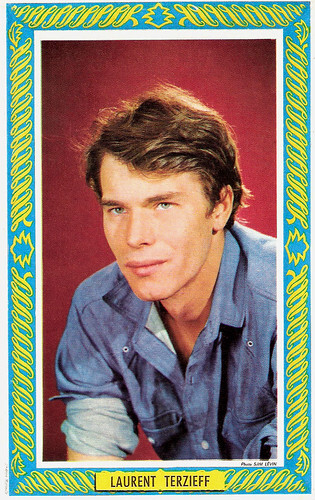
French Postcard by St. Anne, Marseille. Photo: Sam Lévin.
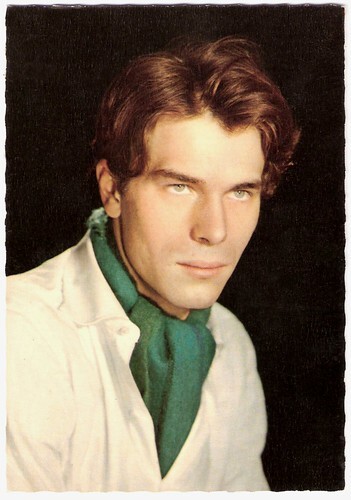
French postcard by E.D.U.G., no. 71. Photo: Sam Lévin.
Famous directors
Laurent Terzieff played roles in films by such famous directors as Gillo Pontecorvo in Kapò (1959) about a young Jewish girl (Susan Strasberg) who leads an escape attempt from a concentration camp, Claude Autant-Lara in Tu ne tueras point/Thou Shalt Not Kill (1961), a portrait of a conscientious objector, and Jacques Demy in the portmanteau (omnibus film) Les Sept Péchés/The Seven Deadly Sins (1962). He appeared in a segment about the lusty conversation between two young men, one of whom has x-ray eyes that enable him to see through women's clothing.
Terzieff starred with Rosanna Schiaffino and Elsa Martinelli in the Italian film La Notte Brava/Bad Girls Don't Cry (Mauro Bolognini, 1959). Pier Paolo Pasolini wrote this social drama about three young Roman criminals and three beautiful prostitutes without any perspective in life but having some money to spend during a night of illusions and adventures.
More famous Italian film directors would ask him for their films. Terzieff appeared as a revolutionary on the run from government troops in Vanina Vanini/The Betrayer (Roberto Rossellini, 1961), as the centaur in Medea (Pier Paolo Pasolini, 1969) opposite Maria Callas, as an anarchistic petty thief in Ostia (Sergio Citti, Pier Paolo Pasolini, 1970), and as a military in Il deserto dei Tartari/Desert of the Tartars (Valerio Zurlini, 1976) opposite Vittorio Gassman and Jacques Perrin .
In France, he played in A cœur joie/Two Weeks in September (Serge Bourguignon, 1967) with Brigitte Bardot , and La Prisonnière/Woman in Chains (Henri Georges Clouzot, 1968), in which he interpreted a disturbed modern art gallery owner who manipulates Elisabeth Wiener .
He made four films with director Philippe Garrel. Le Révélateur/The developper (Philippe Garrel, 1968) was shot in May 1968 during the student revolution, and Les hautes solitudes (Philippe Garrel, 1974), a biographical film about actress Jean Seberg.
Terzieff worked with more great auteurs. Famous Spanish director Luis Buñuel took him and Paul Frankeur on a pilgrimage to Santiago de Compostela in La Voie lactée/The Milky Way (Luis Buñuel, 1969). He was once directed by Jean-Luc Godard in Détective/Detective (Jean-Luc Godard, 1985).
On television, he appeared in the American-Italian Mini-Series Moses the Lawgiver/Moses (Gianfranco De Bosio, 1974) starring Burt Lancaster.
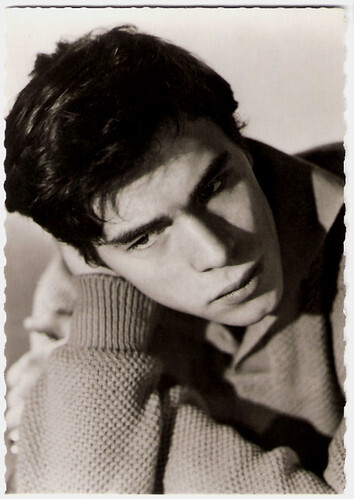
French Postcard by Editions P.I., Paris, offered by Les Carbones Korès 'Carboplane', no. 963. Photo: Studio Vauclair.
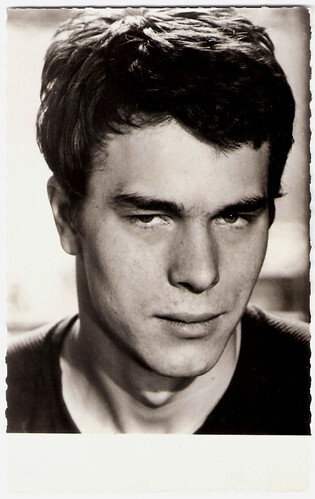
French Postcard by Editions P.I., Paris, offered by Les Carbones Korès 'Carboplane', no. 994. Photo: De Kermadec.
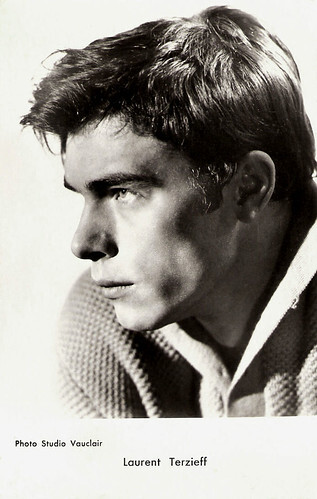
French Postcard by Editions P.I., Paris, no. 1099. Photo: Studio Vauclair.
Director, writer and actor
Since the 1980s, Laurent Terzieff was seen less in the cinemas and mostly acted on stage. In the theatre, he often worked as a director, writer and actor with his own troupe, co-founded in 1961 with his companion Pascale de Boysson. He also ran the theatre Lucernaire in Paris.
His later film roles include a Trotskyist in Rouge Baiser/Red Kiss (Véra Belmont, 1985), an anarchist in Germinal (Claude Berri, 1993) starring Gérard Depardieu , and the painter Hérigault in Le radeau de la Méduse/The Raft of the Medusa (Iradj Azimi, 1994), inspired by a tragic maritime event that happened in 1816.
Politically engaged, Terzieff signed in 1960 La Déclaration sur le droit à l'insoumission dans la Guerre d'Algérie (Declaration on the Right of Insubordination in the War of Algeria), and in 2002, the petition Pas en notre nom (Not in our name) against the Iraq War.
In his seventies, the gaunt-faced actor had not lost his magnetism, as was proved by his appearance in the Agatha Christie adaptation Mon petit doigt m'a dit.../A Little Bird Told Me... (Pascal Thomas, 2005) with Catherine Frot and André Dussollier.
Terzieff also stayed active in the theatre. In 2009 he played an acclaimed Philoctetes in the play by Sophocles.
His last films were the comedy J'ai toujours rêvé d'être un gangster/I always dreamed of being a gangster (Samuel Benchetrit, 2008) with Jean Rochefort, and the Italian production Le ombre rosse/The Red Shadow (Francesco Maselli, 2009). Posthumously he was seen opposite Sharon Stone in the thriller Largo Winch 2/The Burma Conspiracy (Jérôme Salle, 2011).
During his long career, Laurent Terzieff was hailed with many awards (Prix Gérard Philippe, Molière for Best Director and Best Show for Temps contre temps (Time against time) in 1993), and he was also an Officier de l'Ordre du Mérite (Officer of the Order of Merit) and Commandeur des Arts et des Lettres (Commander of Arts and Letters).
Laurent Terzieff died in 2010 in Paris from a lung ailment. He was 75. He was the widower of actress Pascale de Boysson.
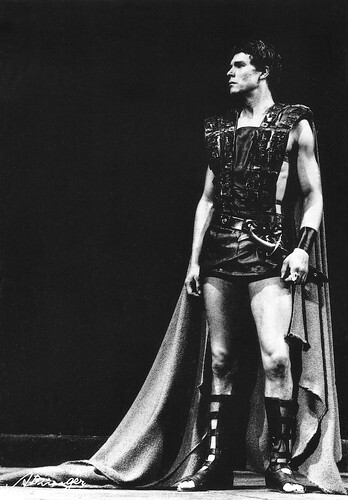
French postcard by Images d'Avignon, Avignon. Photo: Altzinger. Laurent Terzieff in the play 'Nicomède' (1964) by Pierre Corneille at the XVIIIe Festival d'Avignon (1964).
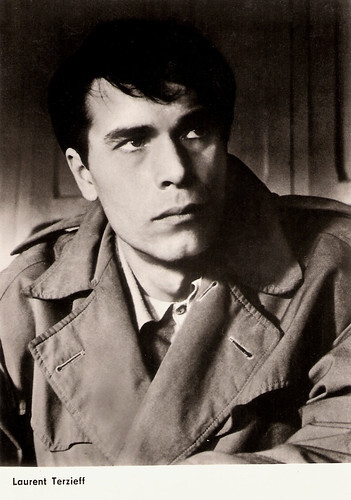
East-German postcard by VEB Progress Film-Vertrieb, Berlin, nr. 2992, 1967. Photo: Progress.
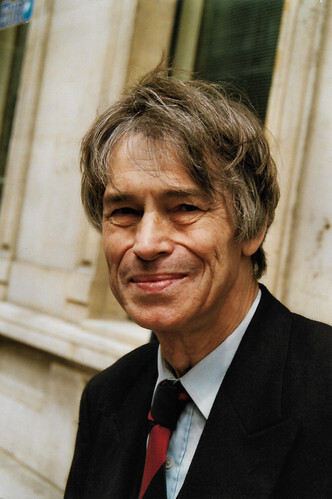
French photo.
Sources: Hans Beerekamp (Het Schimmenrijk) (Dutch), Hal Erickson (AllMovie), Evene.fr (French), Ciné-Ressources (Cinémathèque française) (French), Wikipedia (French and English), and .

Italian postcard by Rotalfoto, Milano, no. 996.

French postcard by Editions du Globe, Paris, no. 776. Photo: Studio Vauclair.

French Postcard by Editions La Malibran, Paris, no. T 2. Photo: Claude Schwartz.
Bohemian and cynical student
Laurent Terzieff was born Laurent Didier Alex Laurent Tchemerzine in 1935 in Toulouse, France. He was the son of a French visual artist and a Russian sculptor who had emigrated to France during the First World War.
The spectacle of the bombardments during WW II had a dramatic effect on nine-year-old Laurent. As an adolescent, he was fascinated with philosophy and poetry.
He assisted director Roger Blin with the production of the play La Sonate des spectres (The Ghost Sonata) by August Strindberg. Then and there, he decided to become an actor.
Terzieff made his debut in 1953 with the Theatre of Babylon in Tous contre Adamov (All Against Adamov) by Jean-Marie Serreau. His film début was opposite Yves Montand in Premier mai/The First of May (Luis Saslavsky, 1958).
A year earlier, he had gained some notoriety playing a role as an assassin in L'affaire Weidmann/The Weidmann case (Jean Prat, 1957), an episode of the TV series En votre âme et conscience/conscience (1954-1969).
Legendary director Marcel Carné spotted him and offered him a leading role opposite Pascale Petit , Jacques Charrier and Jean-Paul Belmondo in Les Tricheurs/The Cheats (Marcel Carné, 1958), a portrait of the existentialist youth in the late 1950s.
At AllMovie , Hal Erickson writes: “Carné's youthful characters are not so many people as symbols of the postwar relaxation of worldwide manners and mores. In anticipation of the hippie flicks of the 1960s, the main characters indulge in a great deal of sex, but abstain from true love and commitment, citing these things as irrelevant in a world full of instant gratification.“
Les Tricheurs was Terzieff’s breakthrough in the cinema. For a long time, the public would identify him with the bohemian and cynical student.

French Postcard by Editions P.I., Paris, offered by Les Carbones Korès 'Carboplane', no. 1007. Photo: Studio Vallois.

French Postcard by St. Anne, Marseille. Photo: Sam Lévin.

French postcard by E.D.U.G., no. 71. Photo: Sam Lévin.
Famous directors
Laurent Terzieff played roles in films by such famous directors as Gillo Pontecorvo in Kapò (1959) about a young Jewish girl (Susan Strasberg) who leads an escape attempt from a concentration camp, Claude Autant-Lara in Tu ne tueras point/Thou Shalt Not Kill (1961), a portrait of a conscientious objector, and Jacques Demy in the portmanteau (omnibus film) Les Sept Péchés/The Seven Deadly Sins (1962). He appeared in a segment about the lusty conversation between two young men, one of whom has x-ray eyes that enable him to see through women's clothing.
Terzieff starred with Rosanna Schiaffino and Elsa Martinelli in the Italian film La Notte Brava/Bad Girls Don't Cry (Mauro Bolognini, 1959). Pier Paolo Pasolini wrote this social drama about three young Roman criminals and three beautiful prostitutes without any perspective in life but having some money to spend during a night of illusions and adventures.
More famous Italian film directors would ask him for their films. Terzieff appeared as a revolutionary on the run from government troops in Vanina Vanini/The Betrayer (Roberto Rossellini, 1961), as the centaur in Medea (Pier Paolo Pasolini, 1969) opposite Maria Callas, as an anarchistic petty thief in Ostia (Sergio Citti, Pier Paolo Pasolini, 1970), and as a military in Il deserto dei Tartari/Desert of the Tartars (Valerio Zurlini, 1976) opposite Vittorio Gassman and Jacques Perrin .
In France, he played in A cœur joie/Two Weeks in September (Serge Bourguignon, 1967) with Brigitte Bardot , and La Prisonnière/Woman in Chains (Henri Georges Clouzot, 1968), in which he interpreted a disturbed modern art gallery owner who manipulates Elisabeth Wiener .
He made four films with director Philippe Garrel. Le Révélateur/The developper (Philippe Garrel, 1968) was shot in May 1968 during the student revolution, and Les hautes solitudes (Philippe Garrel, 1974), a biographical film about actress Jean Seberg.
Terzieff worked with more great auteurs. Famous Spanish director Luis Buñuel took him and Paul Frankeur on a pilgrimage to Santiago de Compostela in La Voie lactée/The Milky Way (Luis Buñuel, 1969). He was once directed by Jean-Luc Godard in Détective/Detective (Jean-Luc Godard, 1985).
On television, he appeared in the American-Italian Mini-Series Moses the Lawgiver/Moses (Gianfranco De Bosio, 1974) starring Burt Lancaster.

French Postcard by Editions P.I., Paris, offered by Les Carbones Korès 'Carboplane', no. 963. Photo: Studio Vauclair.

French Postcard by Editions P.I., Paris, offered by Les Carbones Korès 'Carboplane', no. 994. Photo: De Kermadec.

French Postcard by Editions P.I., Paris, no. 1099. Photo: Studio Vauclair.
Director, writer and actor
Since the 1980s, Laurent Terzieff was seen less in the cinemas and mostly acted on stage. In the theatre, he often worked as a director, writer and actor with his own troupe, co-founded in 1961 with his companion Pascale de Boysson. He also ran the theatre Lucernaire in Paris.
His later film roles include a Trotskyist in Rouge Baiser/Red Kiss (Véra Belmont, 1985), an anarchist in Germinal (Claude Berri, 1993) starring Gérard Depardieu , and the painter Hérigault in Le radeau de la Méduse/The Raft of the Medusa (Iradj Azimi, 1994), inspired by a tragic maritime event that happened in 1816.
Politically engaged, Terzieff signed in 1960 La Déclaration sur le droit à l'insoumission dans la Guerre d'Algérie (Declaration on the Right of Insubordination in the War of Algeria), and in 2002, the petition Pas en notre nom (Not in our name) against the Iraq War.
In his seventies, the gaunt-faced actor had not lost his magnetism, as was proved by his appearance in the Agatha Christie adaptation Mon petit doigt m'a dit.../A Little Bird Told Me... (Pascal Thomas, 2005) with Catherine Frot and André Dussollier.
Terzieff also stayed active in the theatre. In 2009 he played an acclaimed Philoctetes in the play by Sophocles.
His last films were the comedy J'ai toujours rêvé d'être un gangster/I always dreamed of being a gangster (Samuel Benchetrit, 2008) with Jean Rochefort, and the Italian production Le ombre rosse/The Red Shadow (Francesco Maselli, 2009). Posthumously he was seen opposite Sharon Stone in the thriller Largo Winch 2/The Burma Conspiracy (Jérôme Salle, 2011).
During his long career, Laurent Terzieff was hailed with many awards (Prix Gérard Philippe, Molière for Best Director and Best Show for Temps contre temps (Time against time) in 1993), and he was also an Officier de l'Ordre du Mérite (Officer of the Order of Merit) and Commandeur des Arts et des Lettres (Commander of Arts and Letters).
Laurent Terzieff died in 2010 in Paris from a lung ailment. He was 75. He was the widower of actress Pascale de Boysson.

French postcard by Images d'Avignon, Avignon. Photo: Altzinger. Laurent Terzieff in the play 'Nicomède' (1964) by Pierre Corneille at the XVIIIe Festival d'Avignon (1964).

East-German postcard by VEB Progress Film-Vertrieb, Berlin, nr. 2992, 1967. Photo: Progress.

French photo.
Sources: Hans Beerekamp (Het Schimmenrijk) (Dutch), Hal Erickson (AllMovie), Evene.fr (French), Ciné-Ressources (Cinémathèque française) (French), Wikipedia (French and English), and .
Published on October 26, 2022 22:00
October 25, 2022
La Collectionneuse: Tallulah Bankhead
Tallulah Bankhead was one of the 20th Century’s most famous American stage stars and became a legend of her own in her time. Many adjectives have been used to describe her: eccentric, carefree, exhibitionist, outspoken, extrovert, unconventional, uninhibited, outrageous, bawdy, unpredictable, colourful, controversial… In her husky deep voice, she addressed anyone as "Darling", which she pronounced "Dahling", and it became her trademark. She made the cover of Life Magazine in 1939 and Time Magazine in 1948. She was also the first white woman to appear on the cover of Ebony Magazine, alongside Louis Armstrong, in 1952.
Always an original, she was an enthusiastic baseball fan for many years and, later, became an avid watcher of soap operas on television. According to most of the sources, she was bisexual. She married only once, in 1937, with actor John Emery, whom she divorced in 1941, and never had any children. She was known to be a chain smoker, a heavy drinker and a drug user. She had exhibitionist tendencies such as parading around in the nude at parties or in her dressing room. She also allegedly didn’t like wearing underwear. She never learned to set herself limits and she created an instantly recognisable larger-than-life persona which, as years go by, went on to outshine her acting skills. Walt Disney animator Marc Davis admitted that she had been one of his models for the Cruella de Vil character in The 101 Dalmatians.
Needless to say that such a woman became a gay icon. Let’s discover more about this amazing lady.

British postcard in the Cameo Series, London, no. KC27.
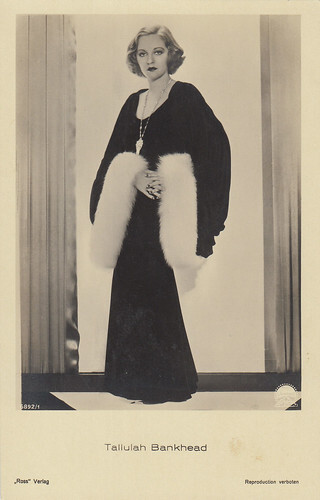
German postcard by Ross Verlag, no. 6892/1, 1931-1932. Photo: Paramount.
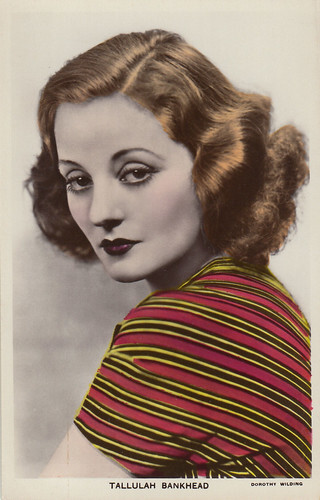
British postcard in the Colourgraph series, London, no. C208. Photo: Dorothy Wilding.
The beginnings
Tallulah Bankhead was born on the 31st of January 1902 in Huntsville, Alabama, U.S.A. She was not the first Tallulah in the Bankhead family, as she was named for her paternal grandmother, whose parents believed they have conceived her during a stopover at Tallulah Falls in Georgia.
Her paternal grandfather was a noted politician and was notably a Senator from Alabama from 1907 until he passed away in 1920. Tallulah’s father followed in his footsteps and reached the pinnacle of his brilliant political career when he became Speaker of the United States House of Representatives from 1936 to his death in 1940. Tallulah never knew her mother, who died of blood poisoning shortly after her birth, on the 23rd of February. She had an elder sister, Eugenia, also an original, who had an impressive record of seven marriages, including three to the same man.
Since childhood, Tallulah revelled in being the centre of attention and soon dreamed of becoming an actress. In 1917, she sent her photo to Picture Play Magazine, which was conducting a beauty contest that would award the twelve winners a movie part. Her elegant portrait in hat and furs made her appear older than she was and favourably impressed the members of the jury, who decided to select her. In 1918 and 1919, she played in several films, usually in supporting roles. The only exception was Thirty a Week (1918), in which she was Tom Moore ’s leading lady.
However, Tallulah was much more interested in the stage and, from 1918 to 1922, appeared in eight plays on Broadway, without managing to establish herself as a star and reach the topmost rung of the ladder. She began to grow impatient and disappointed with the progress of her career.
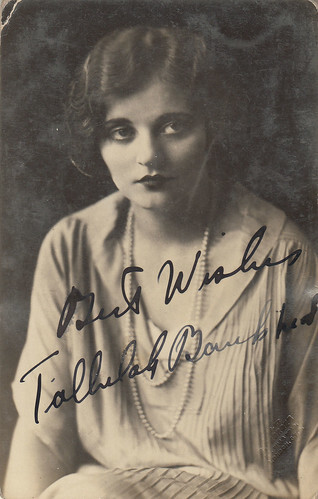
British autographed card from the 1920s.
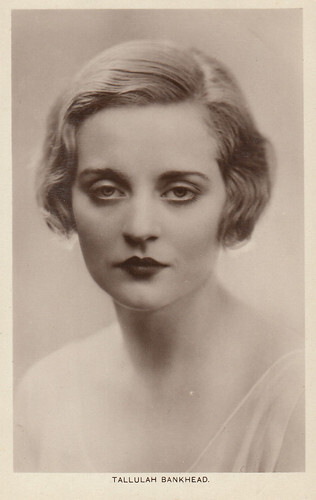
British postcard by Picturegoer, no. 297. Photo: Dorothy Wilding.
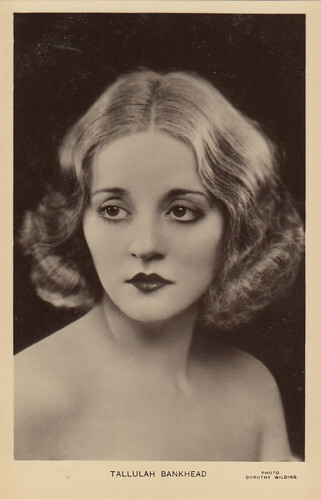
British postcard by Picturegoer, no. 297d. Photo: Dorothy Wilding.
The darling of the British stage
In the fall of 1922, she was noticed by famous British impresario and theatrical manager Charles B. Cochran, who campaigned for her upon his return to London and soon cabled her that she was seriously considered for the part of an American girl in Gerald Du Maurier’s forthcoming play 'The Dancers'. After having received another telegram informing her that another actress had been chosen, a determined Tallulah decided to go to Great Britain anyway. She arrived in January 1923 and quickly succeeded to convince Du Maurier that she was the ideal choice for his play.
'The Dancers' opened in February and was a huge hit. She played it more than three hundred times and it made her the darling of the British stage. Her other London plays include 'The Creaking Chair' (1924), 'Fallen Angels' (1925), 'The Green Hat' (1925), 'They Knew What They Wanted' (1926), 'The Gold Diggers' (1926-1927), 'The Garden of Eden' (1927), 'Her Cardboard Lover' (1928), 'Let Us Be Gay' (1930), …
She was noted for being the object of adulation from groups of young female fans, called the Gallery Girls, who greeted her loudly when she played on stage. For them, she represented the embodiment of their dreams and was the epitome of glamour and modernity. She also became famous for her wit, her hectic way of life, her antics and her constant partying.
In 1928, after her name has been linked to that of five Eton College students, she was the subject of a confidential report from the MI5 Security Service, which regarded her as an "extremely immoral woman" and even considered at a time to deport her from the country.
In 1928, she starred in the film His House in Order, for which she allegedly received the highest salary ever paid to a film star in England at the time. In 1929, she was seen and heard, thanks to the British Photophone process, in the short Her Cardboard Lover, a filmed extract from the play of the same name.
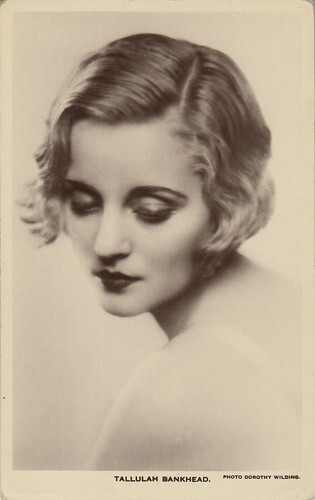
British postcard by Picturegoer, no. 297c. Photo: Dorothy Wilding.
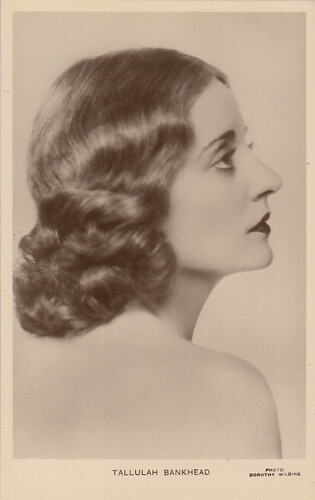
British postcard by Picturegoer, no. 297e. Photo: Dorothy Wilding.
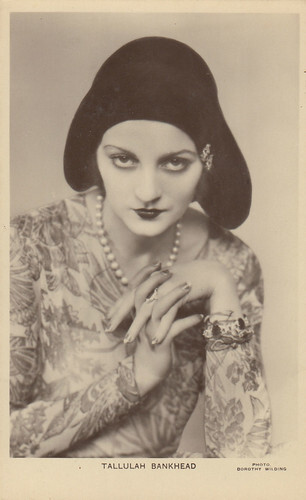
British postcard by Picturegoer, no. 538. Photo: Dorothy Wilding.
Back in the U.S.A.: difficult years
At the end of 1930, she signed a movie contract with Paramount, which wanted to turn her into another Marlene Dietrich . So, she came back to the United States. She was launched, in a blaze of publicity, in Tarnished Lady (1931), to disappointing box-office receipts and mostly negative reviews. My Sin (1931), The Cheat (1931), Thunder Below (1932), The Devil and the Deep (1932) and Faithless (1932), which she made on loan to M.G.M., followed.
However, on the whole, and despite an intensive promoting campaign ("We gave you Marlene Dietrich , now we give you Tallulah Bankhead" proclaimed the ads), she failed to elicit more than a tepid response from the public, which was not as enthusiastic as Paramount had hoped for. She was mostly used in heavy melodramas that didn’t do justice to her talents and were not really suited to her. Trying to make her a new Dietrich or a new Garbo had been a mistake. Tallulah had too much personality to be a second anybody.
Furthermore, in the summer of 1932, she gave an interview to the Motion Picture magazine in which she openly lamented over her lack of male companionship during the last six months and boldly declared: "I Want a Man". It caused a commotion at the time and Will Hays, the initiator of the famous decency code, soon expressed his disapproval. She issued a denial but it was too late: the damage had been done.
It was time for Tallulah to leave Hollywood and go back on the stage. She then starred in seven Broadway plays from 1933 to 1938, without scoring significant success. She reached the nadir when Shakespeare’s 'Antony and Cleopatra' closed after only five performances in November 1937. Ironically, one of her Broadway flops, 'Dark Victory', became a very successful screen vehicle for Bette Davis in 1939.
In December 1936, she screen-tested for the role of Scarlett O’Hara in Gone with the Wind but David O’ Selznick found her too old, as the heroine is not yet twenty years old at the beginning of the story.
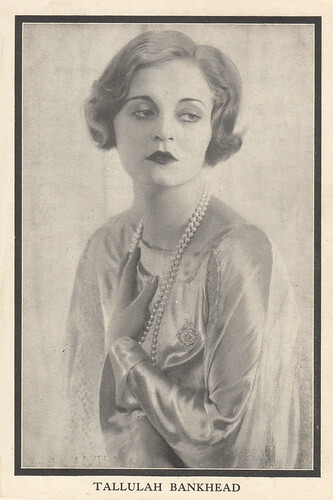
British promotional postcard for 'The Garden of Eden' at the Lyric Theatre (1927).

British promotional postcard for 'Let Us Be Gay' at the Lyric Theatre (1930).
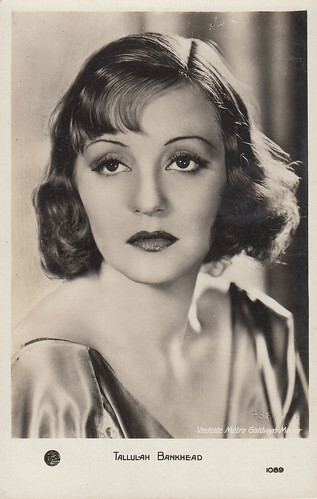
French postcard by Europe, no. 1089. Photo: Metro-Goldwyn-Mayer.
Back to the top
Fortunately, at the end of the 1930s, she was given the plum role of Regina Giddens in Lillian Hellman’s Broadway play 'The Little Foxes'. It was a triumph, which made her a luminary of the American Theatre, and she played it more than four hundred times, from February 1939 to February 1940. The 1940s were a brilliant decade for Tallulah on Broadway, especially thanks to Thornton Wilder’s 'The Skin of Our Teeth' (1942-1943) and Noël Coward’s 'Private Lives' (1948-1949).
In 1944, she starred in Alfred Hitchcock ’s Lifeboat, in a role much better suited to her persona than her previous film parts. She then played Empress Catherine of Russia in Otto Preminger’s A Royal Scandal (1945).
She had her last Broadway success with 'Dear Charles' (1954-1955). Four resounding flops followed: 'A Streetcar Named Desire' in 1956, 'Eugenia' in 1957, 'Midgie Purvis' in 1961 and 'The Milk Train Doesn’t Stop Here Anymore' in 1964.
As the years went by, Tallulah the legend began to put Tallulah the actress in the shade. Several audience members came to see her on stage only to be entertained by their idol and have fun, even if she was appearing in a drama. For example, on the opening night of 'A Streetcar Named Desire', her gay following, much to her dismay, decided to take the play as a comedy and broke into gales of laughter whenever she had a line that could be construed as camp.
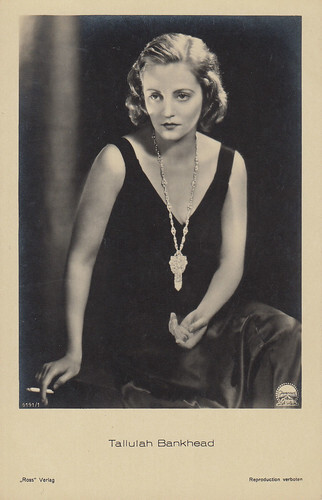
German postcard by Ross Verlag, no. 6191/1, 1931-1932. Photo: Paramount.

German postcard by Ross Verlag, no. 5998/1, 1930-1931. Photo: Paramount.
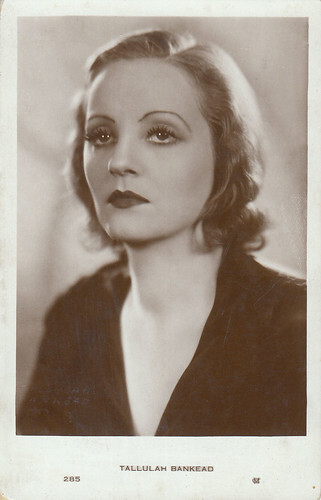
Spanish postcard by M.C. Barcelona, no. 285.
New challenges
In the 1950s, she tackled new challenges. From 1950 to 1952, she served as mistress of ceremonies on the radio in the big-budgeted and star-studded weekly program 'The Big Show'. People such as Groucho Marx, Ethel Barrymore, Marlene Dietrich , Louis Armstrong , Edith Piaf , Gloria Swanson , Gary Cooper , Danny Kaye , Ethel Merman, Bob Hope, Judy Garland , Ginger Rogers , Jimmy Durante, Frank Sinatra or Judy Holliday were among the prestigious guests.
In 1952, she made her first TV appearance and, in 1957, she played herself, to hilarious results, in an episode called The Celebrity Next Door of the popular Lucille Ball-Desi Arnaz Show. Her autobiography, simply called 'Tallulah', became one of 1952’s best-selling books. In 1953 and 1954, she headlined a lucrative cabaret act at the Sands Hotel in Las Vegas.
In 1951, she filed a complaint against her maid, who had been stealing money from her by forging checks. During the trial in December, the Defense tried to take the spotlight off their client and focused on Tallulah by making shocking revelations about her private life and her use of alcohol and drugs. The press had a field day, to her humiliation. The maid was finally declared guilty.
At the end of 1949, she screen-tested for the role of Amanda in The Glass Menagerie. Director Irving Rapper was amazed and deeply moved by her performance but Jack Warner, who thought that her drinking could cause problems during filming, chose Gertrude Lawrence instead. She appeared as herself in Main Street to Broadway (1953), seemingly having great fun at caricaturing her personality and uttering self-ironic lines such as "I doubt if anyone will have as many flops as I’ve had".
She later starred in England in the Hammer horror thriller film Fanatic/Die Die My Darling (1965), playing a former actress who has turned into an old ghastly-looking religious fanatic. It was intended to cash in on the vogue initiated by Whatever Happened to Baby Jane? three years before.
Tallulah Bankhead was a lifelong Democrat Party supporter. She was also a passionate anti-communist, but this didn’t prevent her from profoundly disliking Joseph McCarthy, whom she called a 'disgrace to the nation'. She expressed several times her support for the civil rights movement and opposed segregation. For example, in 1946, she publicly denounced the Washington National Theater, which, at the time, didn’t allow Afro-Americans to attend performances, and, in 1947, she spoke against lynching at a Chicago rally.
Her last role as an actress was as the evil Black Widow in two 1967 Batman episodes. She made her last appearance on television on The Tonight Show on the 14th of May 1968, alongside John Lennon and Paul McCartney , no less. She passed away on the 12th of December 1968, of pneumonia complicated by emphysema. Allegedly, her last audible words have been "codeine" and "bourbon". She thus would have stayed incorrigible until the end … and that’s the way we like her.
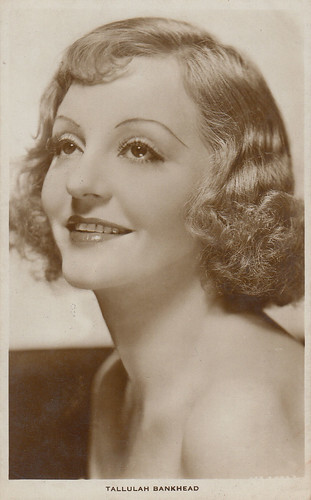
British postcard in the Film Weekly Series, London.
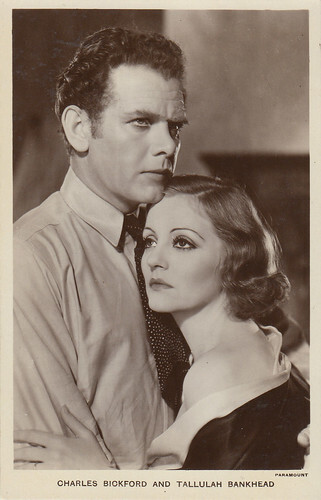
British postcard in the Film Partners Series, London, no. P55. Photo: Paramount. Tallulah Bankhead and Charles Bickford in Thunder Below (Richard Wallace, 1932).
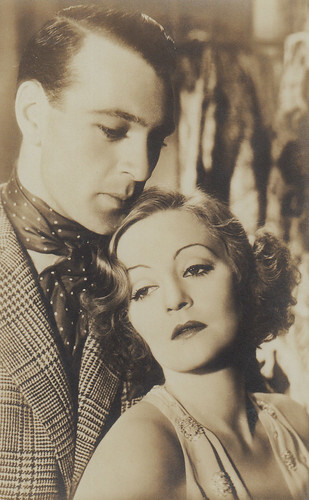
Vintage postcard. Tallulah Bankhead and Gary Cooper in Devil and the Deep (Marion Gering, 1932).
Quotes
To end this homage, here are several quotes credited to Tallulah. And also some quotes about her.

British postcard by Film Weekly Series, London.

American promotional postcard for 'The Little Foxes' at the National Theatre in 1939.

British promotional postcard for Tallulah Bankhead’s 1957 nightclub act at the Café de Paris in London. Collection: Marlene Pilaete.
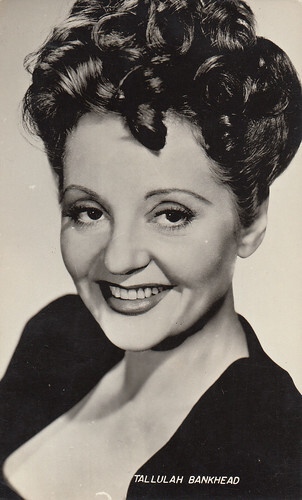
Vintage postcard.
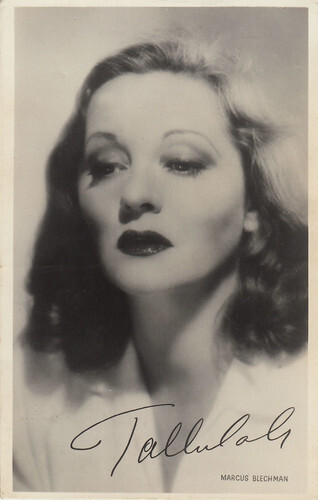
British promotional postcard for the publication of 'Tallulah’s story of her life' in the Sunday Express. Photo: Marcus Blechman.
Text and postcards: Marlene Pilaete.
Always an original, she was an enthusiastic baseball fan for many years and, later, became an avid watcher of soap operas on television. According to most of the sources, she was bisexual. She married only once, in 1937, with actor John Emery, whom she divorced in 1941, and never had any children. She was known to be a chain smoker, a heavy drinker and a drug user. She had exhibitionist tendencies such as parading around in the nude at parties or in her dressing room. She also allegedly didn’t like wearing underwear. She never learned to set herself limits and she created an instantly recognisable larger-than-life persona which, as years go by, went on to outshine her acting skills. Walt Disney animator Marc Davis admitted that she had been one of his models for the Cruella de Vil character in The 101 Dalmatians.
Needless to say that such a woman became a gay icon. Let’s discover more about this amazing lady.

British postcard in the Cameo Series, London, no. KC27.

German postcard by Ross Verlag, no. 6892/1, 1931-1932. Photo: Paramount.

British postcard in the Colourgraph series, London, no. C208. Photo: Dorothy Wilding.
The beginnings
Tallulah Bankhead was born on the 31st of January 1902 in Huntsville, Alabama, U.S.A. She was not the first Tallulah in the Bankhead family, as she was named for her paternal grandmother, whose parents believed they have conceived her during a stopover at Tallulah Falls in Georgia.
Her paternal grandfather was a noted politician and was notably a Senator from Alabama from 1907 until he passed away in 1920. Tallulah’s father followed in his footsteps and reached the pinnacle of his brilliant political career when he became Speaker of the United States House of Representatives from 1936 to his death in 1940. Tallulah never knew her mother, who died of blood poisoning shortly after her birth, on the 23rd of February. She had an elder sister, Eugenia, also an original, who had an impressive record of seven marriages, including three to the same man.
Since childhood, Tallulah revelled in being the centre of attention and soon dreamed of becoming an actress. In 1917, she sent her photo to Picture Play Magazine, which was conducting a beauty contest that would award the twelve winners a movie part. Her elegant portrait in hat and furs made her appear older than she was and favourably impressed the members of the jury, who decided to select her. In 1918 and 1919, she played in several films, usually in supporting roles. The only exception was Thirty a Week (1918), in which she was Tom Moore ’s leading lady.
However, Tallulah was much more interested in the stage and, from 1918 to 1922, appeared in eight plays on Broadway, without managing to establish herself as a star and reach the topmost rung of the ladder. She began to grow impatient and disappointed with the progress of her career.

British autographed card from the 1920s.

British postcard by Picturegoer, no. 297. Photo: Dorothy Wilding.

British postcard by Picturegoer, no. 297d. Photo: Dorothy Wilding.
The darling of the British stage
In the fall of 1922, she was noticed by famous British impresario and theatrical manager Charles B. Cochran, who campaigned for her upon his return to London and soon cabled her that she was seriously considered for the part of an American girl in Gerald Du Maurier’s forthcoming play 'The Dancers'. After having received another telegram informing her that another actress had been chosen, a determined Tallulah decided to go to Great Britain anyway. She arrived in January 1923 and quickly succeeded to convince Du Maurier that she was the ideal choice for his play.
'The Dancers' opened in February and was a huge hit. She played it more than three hundred times and it made her the darling of the British stage. Her other London plays include 'The Creaking Chair' (1924), 'Fallen Angels' (1925), 'The Green Hat' (1925), 'They Knew What They Wanted' (1926), 'The Gold Diggers' (1926-1927), 'The Garden of Eden' (1927), 'Her Cardboard Lover' (1928), 'Let Us Be Gay' (1930), …
She was noted for being the object of adulation from groups of young female fans, called the Gallery Girls, who greeted her loudly when she played on stage. For them, she represented the embodiment of their dreams and was the epitome of glamour and modernity. She also became famous for her wit, her hectic way of life, her antics and her constant partying.
In 1928, after her name has been linked to that of five Eton College students, she was the subject of a confidential report from the MI5 Security Service, which regarded her as an "extremely immoral woman" and even considered at a time to deport her from the country.
In 1928, she starred in the film His House in Order, for which she allegedly received the highest salary ever paid to a film star in England at the time. In 1929, she was seen and heard, thanks to the British Photophone process, in the short Her Cardboard Lover, a filmed extract from the play of the same name.

British postcard by Picturegoer, no. 297c. Photo: Dorothy Wilding.

British postcard by Picturegoer, no. 297e. Photo: Dorothy Wilding.

British postcard by Picturegoer, no. 538. Photo: Dorothy Wilding.
Back in the U.S.A.: difficult years
At the end of 1930, she signed a movie contract with Paramount, which wanted to turn her into another Marlene Dietrich . So, she came back to the United States. She was launched, in a blaze of publicity, in Tarnished Lady (1931), to disappointing box-office receipts and mostly negative reviews. My Sin (1931), The Cheat (1931), Thunder Below (1932), The Devil and the Deep (1932) and Faithless (1932), which she made on loan to M.G.M., followed.
However, on the whole, and despite an intensive promoting campaign ("We gave you Marlene Dietrich , now we give you Tallulah Bankhead" proclaimed the ads), she failed to elicit more than a tepid response from the public, which was not as enthusiastic as Paramount had hoped for. She was mostly used in heavy melodramas that didn’t do justice to her talents and were not really suited to her. Trying to make her a new Dietrich or a new Garbo had been a mistake. Tallulah had too much personality to be a second anybody.
Furthermore, in the summer of 1932, she gave an interview to the Motion Picture magazine in which she openly lamented over her lack of male companionship during the last six months and boldly declared: "I Want a Man". It caused a commotion at the time and Will Hays, the initiator of the famous decency code, soon expressed his disapproval. She issued a denial but it was too late: the damage had been done.
It was time for Tallulah to leave Hollywood and go back on the stage. She then starred in seven Broadway plays from 1933 to 1938, without scoring significant success. She reached the nadir when Shakespeare’s 'Antony and Cleopatra' closed after only five performances in November 1937. Ironically, one of her Broadway flops, 'Dark Victory', became a very successful screen vehicle for Bette Davis in 1939.
In December 1936, she screen-tested for the role of Scarlett O’Hara in Gone with the Wind but David O’ Selznick found her too old, as the heroine is not yet twenty years old at the beginning of the story.

British promotional postcard for 'The Garden of Eden' at the Lyric Theatre (1927).

British promotional postcard for 'Let Us Be Gay' at the Lyric Theatre (1930).

French postcard by Europe, no. 1089. Photo: Metro-Goldwyn-Mayer.
Back to the top
Fortunately, at the end of the 1930s, she was given the plum role of Regina Giddens in Lillian Hellman’s Broadway play 'The Little Foxes'. It was a triumph, which made her a luminary of the American Theatre, and she played it more than four hundred times, from February 1939 to February 1940. The 1940s were a brilliant decade for Tallulah on Broadway, especially thanks to Thornton Wilder’s 'The Skin of Our Teeth' (1942-1943) and Noël Coward’s 'Private Lives' (1948-1949).
In 1944, she starred in Alfred Hitchcock ’s Lifeboat, in a role much better suited to her persona than her previous film parts. She then played Empress Catherine of Russia in Otto Preminger’s A Royal Scandal (1945).
She had her last Broadway success with 'Dear Charles' (1954-1955). Four resounding flops followed: 'A Streetcar Named Desire' in 1956, 'Eugenia' in 1957, 'Midgie Purvis' in 1961 and 'The Milk Train Doesn’t Stop Here Anymore' in 1964.
As the years went by, Tallulah the legend began to put Tallulah the actress in the shade. Several audience members came to see her on stage only to be entertained by their idol and have fun, even if she was appearing in a drama. For example, on the opening night of 'A Streetcar Named Desire', her gay following, much to her dismay, decided to take the play as a comedy and broke into gales of laughter whenever she had a line that could be construed as camp.

German postcard by Ross Verlag, no. 6191/1, 1931-1932. Photo: Paramount.

German postcard by Ross Verlag, no. 5998/1, 1930-1931. Photo: Paramount.

Spanish postcard by M.C. Barcelona, no. 285.
New challenges
In the 1950s, she tackled new challenges. From 1950 to 1952, she served as mistress of ceremonies on the radio in the big-budgeted and star-studded weekly program 'The Big Show'. People such as Groucho Marx, Ethel Barrymore, Marlene Dietrich , Louis Armstrong , Edith Piaf , Gloria Swanson , Gary Cooper , Danny Kaye , Ethel Merman, Bob Hope, Judy Garland , Ginger Rogers , Jimmy Durante, Frank Sinatra or Judy Holliday were among the prestigious guests.
In 1952, she made her first TV appearance and, in 1957, she played herself, to hilarious results, in an episode called The Celebrity Next Door of the popular Lucille Ball-Desi Arnaz Show. Her autobiography, simply called 'Tallulah', became one of 1952’s best-selling books. In 1953 and 1954, she headlined a lucrative cabaret act at the Sands Hotel in Las Vegas.
In 1951, she filed a complaint against her maid, who had been stealing money from her by forging checks. During the trial in December, the Defense tried to take the spotlight off their client and focused on Tallulah by making shocking revelations about her private life and her use of alcohol and drugs. The press had a field day, to her humiliation. The maid was finally declared guilty.
At the end of 1949, she screen-tested for the role of Amanda in The Glass Menagerie. Director Irving Rapper was amazed and deeply moved by her performance but Jack Warner, who thought that her drinking could cause problems during filming, chose Gertrude Lawrence instead. She appeared as herself in Main Street to Broadway (1953), seemingly having great fun at caricaturing her personality and uttering self-ironic lines such as "I doubt if anyone will have as many flops as I’ve had".
She later starred in England in the Hammer horror thriller film Fanatic/Die Die My Darling (1965), playing a former actress who has turned into an old ghastly-looking religious fanatic. It was intended to cash in on the vogue initiated by Whatever Happened to Baby Jane? three years before.
Tallulah Bankhead was a lifelong Democrat Party supporter. She was also a passionate anti-communist, but this didn’t prevent her from profoundly disliking Joseph McCarthy, whom she called a 'disgrace to the nation'. She expressed several times her support for the civil rights movement and opposed segregation. For example, in 1946, she publicly denounced the Washington National Theater, which, at the time, didn’t allow Afro-Americans to attend performances, and, in 1947, she spoke against lynching at a Chicago rally.
Her last role as an actress was as the evil Black Widow in two 1967 Batman episodes. She made her last appearance on television on The Tonight Show on the 14th of May 1968, alongside John Lennon and Paul McCartney , no less. She passed away on the 12th of December 1968, of pneumonia complicated by emphysema. Allegedly, her last audible words have been "codeine" and "bourbon". She thus would have stayed incorrigible until the end … and that’s the way we like her.

British postcard in the Film Weekly Series, London.

British postcard in the Film Partners Series, London, no. P55. Photo: Paramount. Tallulah Bankhead and Charles Bickford in Thunder Below (Richard Wallace, 1932).

Vintage postcard. Tallulah Bankhead and Gary Cooper in Devil and the Deep (Marion Gering, 1932).
Quotes
To end this homage, here are several quotes credited to Tallulah. And also some quotes about her.
- "If I had to live my life again, I’d make the same mistakes, only sooner".
- "Nobody can exactly be me. Sometimes even I have trouble doing it".
- "Never practice two vices at once".
-"My father warned me about men and booze but he never said anything about women and cocaine".
- "Cocaine isn’t habit-forming. I should know, I’ve been using it for years".
- "Only good girls keep diaries. Bad girls don’t have time".
- "It’s one of the strange ironies of the theatre world that only one man in it can count on steady work: the night watchman".
- "I’d rather be right than righteous. Righteousness is unspeakable. It’s the weapon of weak people".
- "There have been two geniuses in the world, Willie Mays and Willie Shakespeare. But I think you’d better put Shakespeare first." (Note: Willie Mays was a famous Afro-American baseball player).
- "Bette Davis and I are good friends. That’s nothing I wouldn’t say to her face. Both of them".
- "They used to shoot Shirley Temple through gauze. They should shoot me through linoleum".
- About her difficulty to remember people’s names: "Once I introduced a friend of mine as Martini. Her name was actually Olive.
- To a critic who wrote a negative review about her: "I am sitting in the smallest room of the house. Your review is before me. Soon it will be behind me".
- After a screening of Fanatic: "I want to apologize to all for my appearance on the screen, looking older than God’s wet nurse".
- After having been told that her part in Batman would be camp: "Don’t talk to me about camp, I’ve invented it".
- Anita Loos: "Tallulah never bored anyone, and I consider that humanitarism of a very high order indeed".
- Katharine Hepburn: "Tallulah never disappointed anyone. She always lived up to people’s expectations of her - even at the very end when she was ravaged".
- Tony Randall: "She was unstoppable. She would do anything that came into her head. She was a little girl show-off, a little girl being bad all the time to get attention, being naughty and being darling".
- Stefanie Powers, her co-star in Fanatic: "Nothing in her life-style was mundane. It was always absurd, extreme, bigger than life. She never liked to go to the toilet alone. She liked to have an audience. I just adored her".
- Laurence Olivier: "She was great fun to be with and had more glamour than almost everybody alive".
- Burgess Meredith: "She was way ahead of her time".
- Joan Crawford: "We all adored her. We were fascinated by her, but we were scared to death of her, too".
- Howard Dietz: "A day away from Tallulah is like a month in the country".
- Critic John Mason Brown reviewing the play 'Antony and Cleopatra' in 1936: "Tallulah Bankhead barged down the Nile last night as Cleopatra – and sank".
- Alfred Hitchcock, after having been informed that Tallulah didn’t wear underpants during the filming of Lifeboat: "I don’t know if this is a matter for the costume department or hairdressing".

British postcard by Film Weekly Series, London.

American promotional postcard for 'The Little Foxes' at the National Theatre in 1939.

British promotional postcard for Tallulah Bankhead’s 1957 nightclub act at the Café de Paris in London. Collection: Marlene Pilaete.

Vintage postcard.

British promotional postcard for the publication of 'Tallulah’s story of her life' in the Sunday Express. Photo: Marcus Blechman.
Text and postcards: Marlene Pilaete.
Published on October 25, 2022 22:00
October 24, 2022
24 Film Stars der Welt
We found some small German collector cards in the 'Film Stars der Welt' (Filmstars of the World) series by Greiling-Sammelbilder. During the early 1950s, Greiling-Cigaretten in Lensahn produced two sets of 220 beautiful film star collector cards. Below you find 24 cards of the E series from 1951, the second series and all cards in Black and White and measure 6.2 by 4.6 cm. You could buy special albums for both the C and the E series and reportedly there were also bigger versions of some of the cards.
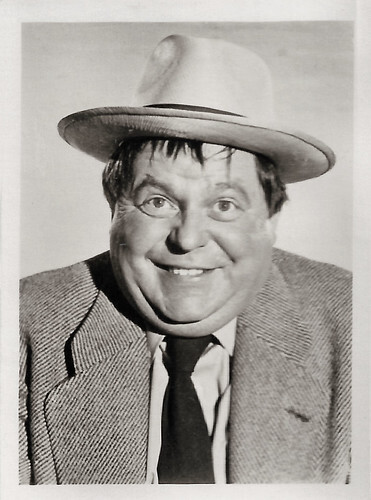
Small German collectors card in the 'Film Stars der Welt' series by Greiling-Sammelbilder, series E, no. 67. Photo: Unionfilm. Max Mairich in O du lieber Fridolin/O you dear Fridolin (Peter Hamel, 1952).
German actor Max Mairich (1910-1990) began his stage career in 1930. After a few film roles, Mairich appeared in numerous television plays, especially literary adaptations and series.
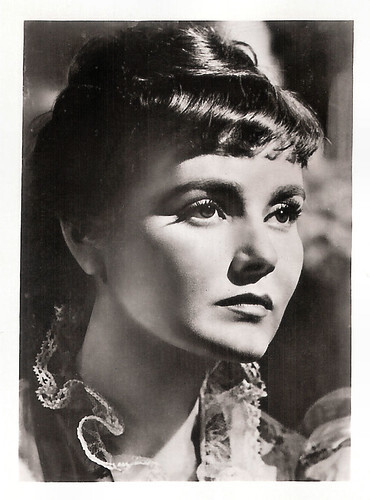
Small West-German collectors card by Greiling Sammelbilder, Serie E, no. 93. Photo: Constantin-Film. Dominique Blanchar in Le secret de Mayerling/The Secret of Mayerling (Jean Delannoy, 1949).
French actress Dominique Blanchar (1927-2018) was the daughter of the actors Pierre Blanchar and Marthe Vinot. She was married to the Belgian actor Jean Servais, until his death in 1976. Her best-known film is probably the Italian classic L'Avventura/The Adventure (1960) directed by Michelangelo Antonioni and starring Gabriele Ferzetti, and Monica Vitti. Other known films are Le secret de Mayerling (1949), Eugénie Grandet (1956), and Les enquêtes du commissaire Maigret (1967).
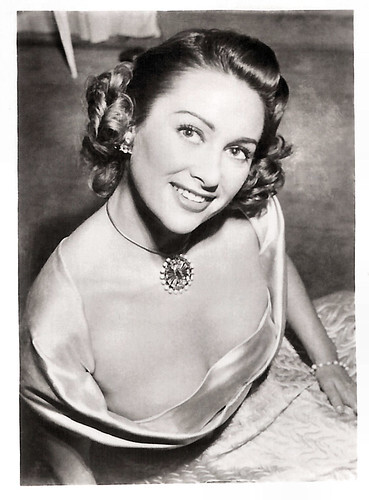
Small German collectors card by Greilings-Sammelbilder in the Filmstars der Welt series, 2. band, serie E, bild 95. Photo: Deutsche Commerz. Caption: Picture exchange vouchers contain all packs Greiling O/M, Greiling Cork, Amati Turkish 8.
Sex symbol Martine Carol (1920–1967) was one of the most beautiful women in French cinema. During the early 1950s, she was a top box office draw as an elegant blonde seductress. Her private life was filled with turmoil including a suicide attempt, drug abuse, kidnapping, and mysterious death.
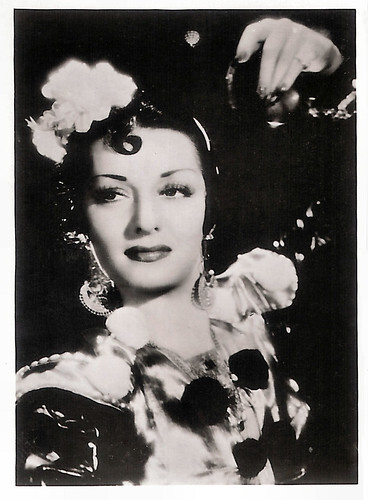
Small German collectors card in the series E - Filmstars der Welt 2. Band by Greilings-sammelbilder, no. 96. Photo: Deutsche Commerz. Viviane Romance in Carmen (Christian-Jaque, 1944).
Temperamental and beautiful French star Viviane Romance (1912-1991) played dozens of flirts, femme fatales and fallen women in black & white classics of the French cinema of the 1930s and 1940s.
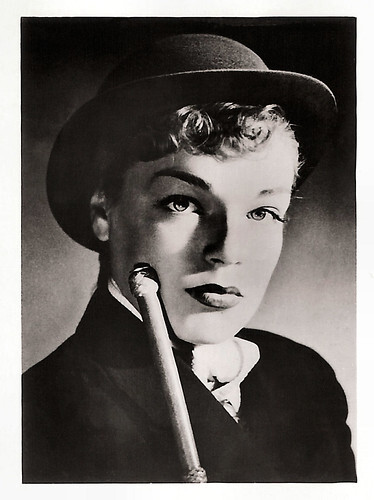
German collectors card by Greiling Sammelbilder in the series Filmstars der Welt, 2. Band, Serie E, no. 97. Photo: Allianz Film. Simone Signoret in Manèges/The Cheat (Yves Allégret, 1950).
French actress Simone Signoret (1921-1985) was given the ‘star build-up’ in the postwar years. She went on to become one of the great film actresses of the French cinema and won a BAFTA, an Oscar and many more awards.
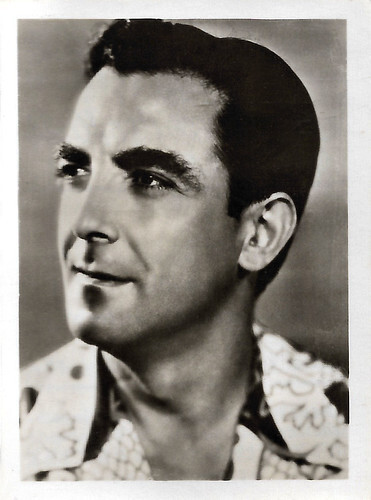
Small German collectors card in the 'Film Stars der Welt ' series by Greiling-Sammelbilder, series E, no. 98. Photo: Super-Film. Aime Barelli in Les joyeux pélerins/The Merry Pilgrims (Fred Pasquali, 1951).
Aimé Barelli (1917-1995) was one of the best-known trumpeters on the French jazz scene of the 1940s and 1950s. He also appeared in a few films.
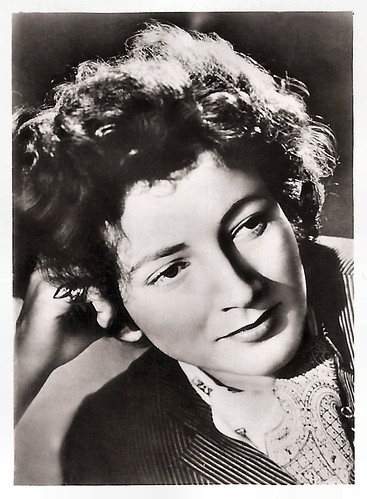
West-German collectors card in the Flmstars der Welt series ny Greiling-Sammelbilder, 2. Band, Serie E, Bild 99. Photo: 20th Century Fox.
Italian film and stage actress Valentina Cortese (1923-2019) appeared in more than 100 Italian, French, British and American films and TV series. Cortese was nominated for the Oscar for Best Supporting Actress for her role in François Truffaut’s La nuit américaine/Day for Night (1973). She also worked with such titans of cinema as Michelangelo Antonioni and Federico Fellini.
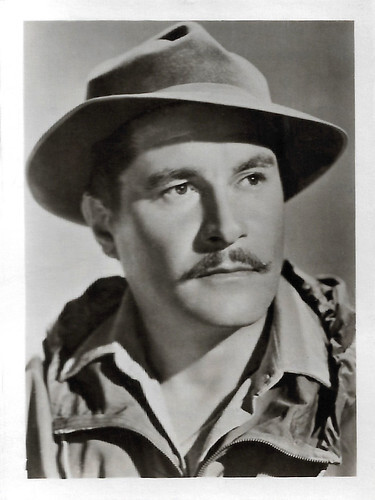
Small German collectors card in the 'Film Stars der Welt' series by Greiling-Sammelbilder, series E, no. 100. Photo: Deutsche Commerz.
Italian heartthrob Amedeo Nazzari (1907-1979) was the athletic, fearless hero and impeccable gentleman of dozens of popular films during the late 1930s, 1940s and 1950s. Because of his reckless, adventure-seeking film characters, he was compared to Errol Flynn. After the war, he made a come-back opposite Yvonne Sanson in a series of popular crime melodramas, directed by Raffaello Matarazzo. And he showed an admirable sense of irony in his portrayal of a film star in decline in Fellini’s Le notti di Cabiria (1957).
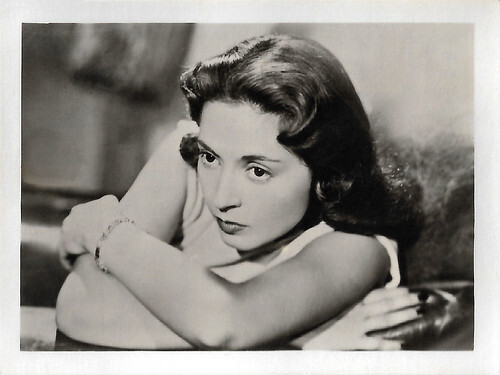
Small German collectors card in the 'Film Stars der Welt' series by Greiling-Sammelbilder, series E, no. 101. Photo: Super-Film. Lea Padovani in Atto di accusa/The Accusation (Giacomo Gentilomo, 1950).
Lea Padovani (1923-1991) was an Italian stage and film actress. She appeared in 60 films between 1945 and 1990. She starred in the French crime film Le Dossier noir/Black Dossier (André Cayatte, 1955) which was entered into the 1955 Cannes Film Festival.
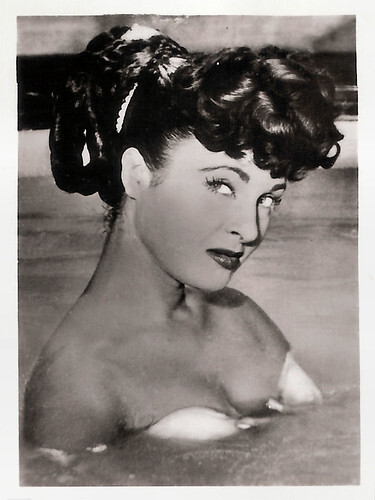
German collectors card by Greiling Sammelbilder in the series Filmstars der Welt, 2. Band, Serie E, no. 102. Photo: Allianz Film. Silvana Pampanini in O.K. Nerone/O.K. Nero (Mario Soldati, 1951).
Gorgeous Italian actress Silvana Pampanini (1925-2016) knew enormous popularity in the 1950s and 1960s. In the early 1950s, before Sophia Loren and Gina Lollobrigida reached stardom, Pampanini was one of the most well-known symbols of Italian beauty.
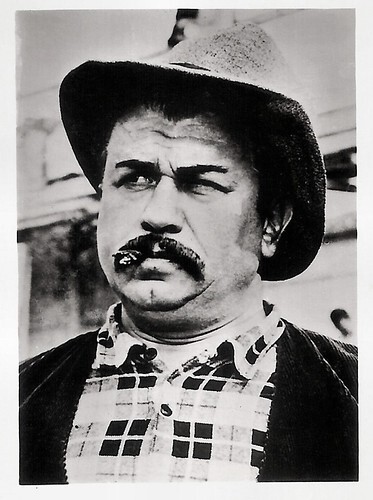
Small West-German collectors card by Greiling Sammelbilder, Serie E, no. 103. Photo: Allianz-Film. Gino Cervi in Don Camillo (Julien Duvivier, 1952).
Gino Cervi (1901-1974) was a highly active and equally popular Italian stage, film and television actor from the 1930s to the early 1970s. He is best remembered as Peppone in the Don Camillo films and as Maigret in the RAI TV series.
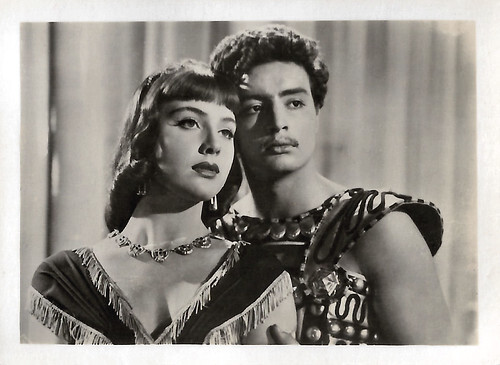
Small German collectors card in the 'Film Stars der Welt' series by Greiling-Sammelbilder, series E, no. 104. Photo: Deutsche Commerz. Leonora Ruffa and Gino Leurini in La regina di Saba/The Queen of Sheba (Pietro Francisci, 1952).
Italian film actress Leonora Ruffo (1935-2007) was active in peplum and adventure films. An exception is her role as the sensible Sandra Rubini in Federico Fellini's I Vitelloni (1954). Ruffo also starred in a number of 'Fotoromanzi'. She retired from acting in the late 1960s.
Italian film, stage and television actor Gino Leurini (1934-2014) made his film debut in the drama Legge di sangue (Luigi Capuano, 1947). One year later, he got the role of Garrone in Vittorio De Sica and Duilio Coletti's Cuore/Heart and Soul (1948). A critical and commercial success was Léonide Moguy's Domani è troppo tardi/Tomorrow Is Too Late (1949), in which Leurini played the young student Franco opposite Pier Angeli. After this success followed some major roles in adventure films and melodramas.
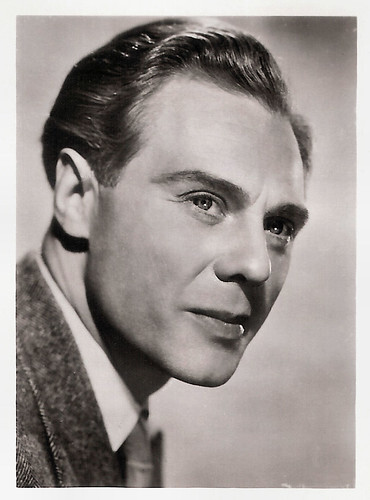
German collectors card in the series Filmstars der Welt 2. Band by Greiling-Sammelbilder, Serie E, Bild 105. Photo: Rank.
English stage and film actor Marius Goring (1912-1998) is best remembered for the four films he made with Powell & Pressburger, particularly as Conductor 71 in A Matter of Life and Death (1946) and as Julian Craster in The Red Shoes (1948). He regularly performed French and German roles.
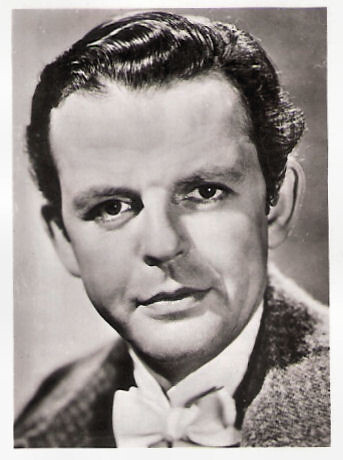
Small German Collectors card by Greiling in the Filmstars der Welt Series, 2. Band, Serie E, no. 107. Photo: Rank.
British actor David Tomlinson (1917-2000) was both a leading man, a character actor and a comedian. He is best remembered for his roles in the Walt Disney successes Mary Poppins (1964) as authority figure George Banks, The Love Bug (1968) as hapless antagonist Peter Thorndyke, and Bedknobs and Broomsticks (1971) as fraudulent magician Professor Emelius Browne.
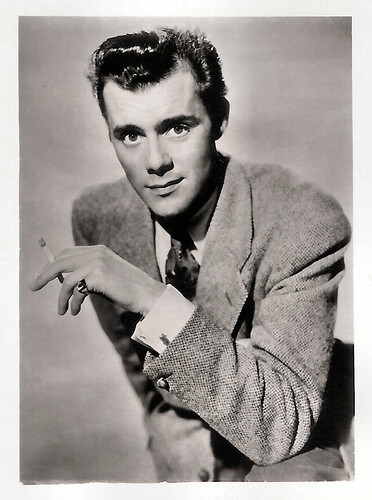
German collectors card by Greiling-Sammelbilder in the series Filmstars der Welt, 2. Band, no. E 109. Photo: Rank.
Distinguished British actor and novelist Sir Dirk Bogarde (1921-1999) was Britain's number one box office draw of the 1950s, gaining the title of ‘The Matinee Idol of the Odeon’. In the 1960s, he abandoned his heart-throb image for more challenging parts in films by Joseph Losey, John Schlesinger, Luchino Visconti, Liliane Cavani and Rainer Werner Fassbinder. Bogarde made a total of 63 films between 1939 and 1991.
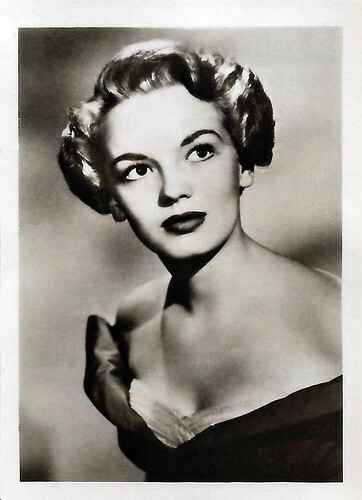
Small German collectors card in the 'Film Stars der Welt' series by Greiling-Sammelbilder, series E, no. 149. Photo: RKO.
American film actress Joan Evans (1934) was discovered by film producer Samuel Goldwyn at age 14. In a career that spanned only twelve years, Evans appeared in more than 30 films and television series.
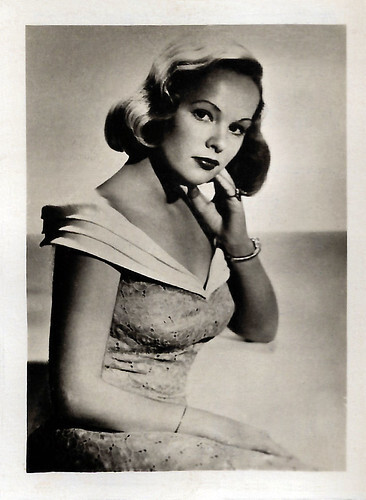
Small German collectors card in the 'Film Stars der Welt' series by Greiling-Sammelbilder, series E, no. 150. Photo: Monogram.
Blonde and beautiful Irish actress Peggy Cummins (1925-2017) was unforgettable as the trigger-happy femme fatale who robs banks with her lover in the Film Noir classic Gun Crazy (1949).
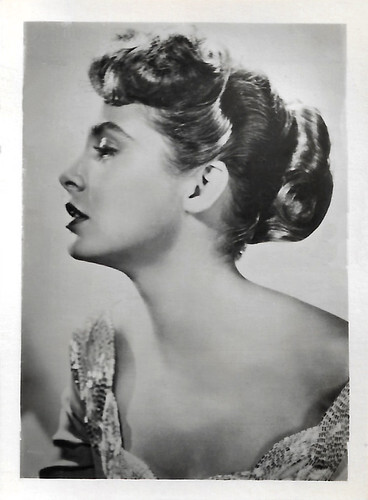
Small German collectors card in the 'Film Stars der Welt' series by Greiling-Sammelbilder, series E, no. 152. Photo: RKO.
American actress Janet Leigh (1927-2004) starred in more than 50 films, but will always be remembered for the 45 minutes that she was on the screen in Alfred Hitchcock's Psycho (1960). Her shower scene became a film landmark. She was nominated for an Oscar and received a Golden Globe. Also unforgettable are her roles in Orson Welles' Touch of Evil (1958) and The Manchurian Candidate (1962), in which she starred with Frank Sinatra. Leigh and Tony Curtis were married from 1951 to 1962.
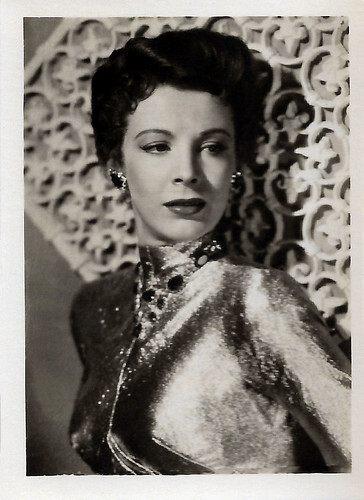
Small German collectors card in the 'Film Stars der Welt' series by Greiling-Sammelbilder, series E, no. 153. Photo: Hamann-Meyerpress.
Swedish actress Signe Hasso (1915-2002) was only 12 when she started to work as a child extra at The Royal Dramatic Theater and was at 16 one of the youngest students to study drama there. She quickly got leading roles in films and received excellent reviews. In 1940 she went to Hollywood and signed a contract with RKO, touted as the "next Garbo". Despite her talent, it didn't lead to any work and she ventured off to New York and the theatre. She signed a contract with MGM and made a dozen films, including Fred Zinnemann's The Seventh Cross (1944), The House on 92nd Street (Henry Hathaway, 1945), and George Cukor's A Double Life (1947). She made a humorous splash in Ernst Lubitsch's comedy Heaven Can Wait (1943) as a lusty French maid. However, she longed to go back to the theatre and worked on Broadway and the West End.
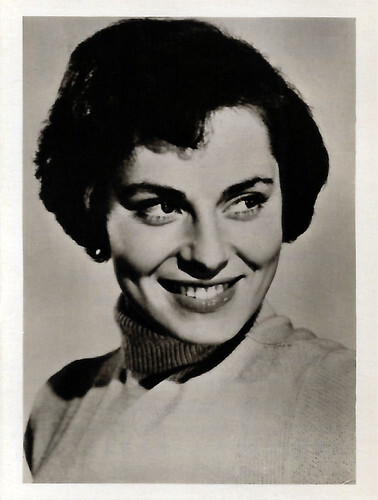
Small German collectors card in the 'Film Stars der Welt' series by Greiling-Sammelbilder, series E, no. 155. Photo: Columbia.
Tall, dark, Swedish-American actress Viveca Lindfors (1920-1995) had a film and stage career in Sweden and Hollywood which spanned more than half a century. Though as talented and beautiful as her compatriots Greta Garbo and Ingrid Bergman, she never achieved their superstar status.
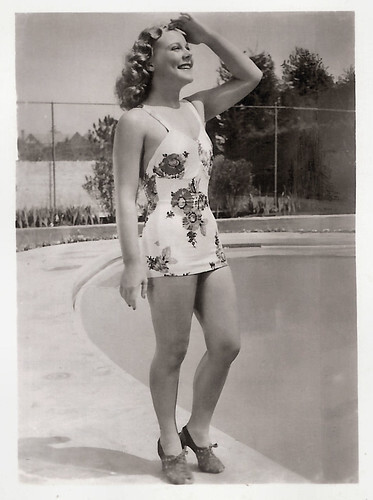
German collectors card in the series E - Filmstars der Welt 2. Band by Greilings-sammelbilder, no. 162. Photo: Hamann / Meyerpress.
Petite and glamorous Sonja Henie (1912-1969) was one of the greatest figure skaters in history, the ‘Pavlova of the ice’. She won more Olympic and World titles than any other ladies figure skater. At the height of her acting career, the Norwegian figure skater and film star was one of the highest-paid stars in Hollywood. She had a shrewd business sense and was immensely successful next with a series of ice revues.
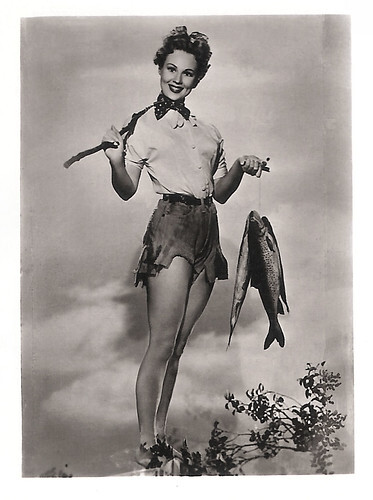
German collectors card in the series E - Filmstars der Welt 2. Band by Greilings-sammelbilder, no. 163. Photo: Hamann / Meyerpress.
American actress and dancer Virginia Mayo (1920-2005) is best known for her series of film comedies with Danny Kaye, including Wonder Man (H. Bruce Humberstone, 1945), The Kid from Brooklyn (Norman Z. McLeod, 1946), and The Secret Life of Walter Mitty (Norman Z. McLeod, 1947). The popular actress personified the dream girl or girl-next-door and audiences — particularly males — flocked to theatres just to see her blonde hair and classic looks on-screen in Technicolor. It made Mayo Warner Brothers the biggest box office money maker in the late 1940s. Going against stereotype, Mayo accepted the supporting role of unsympathetic gold-digger Marie Derry in the Oscar-winning drama The Best Years of Our Lives (William Wyler, 1946). Her performance drew favourable reviews from critics as the film also became the highest-grossing film in the US since Gone with the Wind. Later she appeared opposite James Cagney in White Heat (Raoul Walsh, 1949), Burt Lancaster in The Flame and the Arrow (Jacques Tourneur, 1950), and Gregory Peck in Captain Horatio Hornblower (Raoul Walsh, 1951).
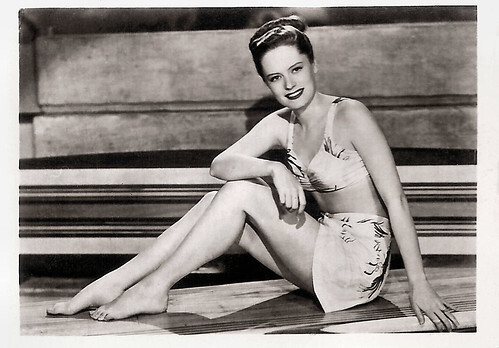
Small German collectors card in the series E - Filmstars der Welt 2. Band by Greilings-sammelbilder, no. 164. Photo: Hamann-Meyerpress.
Statuesque, smart Canadian-born Alexis Smith (1921-1993), with her blue/green eyes and a seductively husky voice, lent a touch of class to her leading ladies of the 1940s and 1950s. She was paired with the top male stars in Hollywood, including Clark Gable, Humphrey Bogart, William Holden and Bing Crosby. She was stylishly attired by costume designers like Milo Anderson and Helen Rose in the most glamorous gowns but also proved to be a capable and spirited actress. She reserved her best acting for the stage and in 1972, she won a Tony award for her starring role in Stephen Sondheim's musical 'Follies'.

Small German collectors card in the 'Film Stars der Welt' series by Greiling-Sammelbilder, series E, no. 67. Photo: Unionfilm. Max Mairich in O du lieber Fridolin/O you dear Fridolin (Peter Hamel, 1952).
German actor Max Mairich (1910-1990) began his stage career in 1930. After a few film roles, Mairich appeared in numerous television plays, especially literary adaptations and series.

Small West-German collectors card by Greiling Sammelbilder, Serie E, no. 93. Photo: Constantin-Film. Dominique Blanchar in Le secret de Mayerling/The Secret of Mayerling (Jean Delannoy, 1949).
French actress Dominique Blanchar (1927-2018) was the daughter of the actors Pierre Blanchar and Marthe Vinot. She was married to the Belgian actor Jean Servais, until his death in 1976. Her best-known film is probably the Italian classic L'Avventura/The Adventure (1960) directed by Michelangelo Antonioni and starring Gabriele Ferzetti, and Monica Vitti. Other known films are Le secret de Mayerling (1949), Eugénie Grandet (1956), and Les enquêtes du commissaire Maigret (1967).

Small German collectors card by Greilings-Sammelbilder in the Filmstars der Welt series, 2. band, serie E, bild 95. Photo: Deutsche Commerz. Caption: Picture exchange vouchers contain all packs Greiling O/M, Greiling Cork, Amati Turkish 8.
Sex symbol Martine Carol (1920–1967) was one of the most beautiful women in French cinema. During the early 1950s, she was a top box office draw as an elegant blonde seductress. Her private life was filled with turmoil including a suicide attempt, drug abuse, kidnapping, and mysterious death.

Small German collectors card in the series E - Filmstars der Welt 2. Band by Greilings-sammelbilder, no. 96. Photo: Deutsche Commerz. Viviane Romance in Carmen (Christian-Jaque, 1944).
Temperamental and beautiful French star Viviane Romance (1912-1991) played dozens of flirts, femme fatales and fallen women in black & white classics of the French cinema of the 1930s and 1940s.

German collectors card by Greiling Sammelbilder in the series Filmstars der Welt, 2. Band, Serie E, no. 97. Photo: Allianz Film. Simone Signoret in Manèges/The Cheat (Yves Allégret, 1950).
French actress Simone Signoret (1921-1985) was given the ‘star build-up’ in the postwar years. She went on to become one of the great film actresses of the French cinema and won a BAFTA, an Oscar and many more awards.

Small German collectors card in the 'Film Stars der Welt ' series by Greiling-Sammelbilder, series E, no. 98. Photo: Super-Film. Aime Barelli in Les joyeux pélerins/The Merry Pilgrims (Fred Pasquali, 1951).
Aimé Barelli (1917-1995) was one of the best-known trumpeters on the French jazz scene of the 1940s and 1950s. He also appeared in a few films.

West-German collectors card in the Flmstars der Welt series ny Greiling-Sammelbilder, 2. Band, Serie E, Bild 99. Photo: 20th Century Fox.
Italian film and stage actress Valentina Cortese (1923-2019) appeared in more than 100 Italian, French, British and American films and TV series. Cortese was nominated for the Oscar for Best Supporting Actress for her role in François Truffaut’s La nuit américaine/Day for Night (1973). She also worked with such titans of cinema as Michelangelo Antonioni and Federico Fellini.

Small German collectors card in the 'Film Stars der Welt' series by Greiling-Sammelbilder, series E, no. 100. Photo: Deutsche Commerz.
Italian heartthrob Amedeo Nazzari (1907-1979) was the athletic, fearless hero and impeccable gentleman of dozens of popular films during the late 1930s, 1940s and 1950s. Because of his reckless, adventure-seeking film characters, he was compared to Errol Flynn. After the war, he made a come-back opposite Yvonne Sanson in a series of popular crime melodramas, directed by Raffaello Matarazzo. And he showed an admirable sense of irony in his portrayal of a film star in decline in Fellini’s Le notti di Cabiria (1957).

Small German collectors card in the 'Film Stars der Welt' series by Greiling-Sammelbilder, series E, no. 101. Photo: Super-Film. Lea Padovani in Atto di accusa/The Accusation (Giacomo Gentilomo, 1950).
Lea Padovani (1923-1991) was an Italian stage and film actress. She appeared in 60 films between 1945 and 1990. She starred in the French crime film Le Dossier noir/Black Dossier (André Cayatte, 1955) which was entered into the 1955 Cannes Film Festival.

German collectors card by Greiling Sammelbilder in the series Filmstars der Welt, 2. Band, Serie E, no. 102. Photo: Allianz Film. Silvana Pampanini in O.K. Nerone/O.K. Nero (Mario Soldati, 1951).
Gorgeous Italian actress Silvana Pampanini (1925-2016) knew enormous popularity in the 1950s and 1960s. In the early 1950s, before Sophia Loren and Gina Lollobrigida reached stardom, Pampanini was one of the most well-known symbols of Italian beauty.

Small West-German collectors card by Greiling Sammelbilder, Serie E, no. 103. Photo: Allianz-Film. Gino Cervi in Don Camillo (Julien Duvivier, 1952).
Gino Cervi (1901-1974) was a highly active and equally popular Italian stage, film and television actor from the 1930s to the early 1970s. He is best remembered as Peppone in the Don Camillo films and as Maigret in the RAI TV series.

Small German collectors card in the 'Film Stars der Welt' series by Greiling-Sammelbilder, series E, no. 104. Photo: Deutsche Commerz. Leonora Ruffa and Gino Leurini in La regina di Saba/The Queen of Sheba (Pietro Francisci, 1952).
Italian film actress Leonora Ruffo (1935-2007) was active in peplum and adventure films. An exception is her role as the sensible Sandra Rubini in Federico Fellini's I Vitelloni (1954). Ruffo also starred in a number of 'Fotoromanzi'. She retired from acting in the late 1960s.
Italian film, stage and television actor Gino Leurini (1934-2014) made his film debut in the drama Legge di sangue (Luigi Capuano, 1947). One year later, he got the role of Garrone in Vittorio De Sica and Duilio Coletti's Cuore/Heart and Soul (1948). A critical and commercial success was Léonide Moguy's Domani è troppo tardi/Tomorrow Is Too Late (1949), in which Leurini played the young student Franco opposite Pier Angeli. After this success followed some major roles in adventure films and melodramas.

German collectors card in the series Filmstars der Welt 2. Band by Greiling-Sammelbilder, Serie E, Bild 105. Photo: Rank.
English stage and film actor Marius Goring (1912-1998) is best remembered for the four films he made with Powell & Pressburger, particularly as Conductor 71 in A Matter of Life and Death (1946) and as Julian Craster in The Red Shoes (1948). He regularly performed French and German roles.

Small German Collectors card by Greiling in the Filmstars der Welt Series, 2. Band, Serie E, no. 107. Photo: Rank.
British actor David Tomlinson (1917-2000) was both a leading man, a character actor and a comedian. He is best remembered for his roles in the Walt Disney successes Mary Poppins (1964) as authority figure George Banks, The Love Bug (1968) as hapless antagonist Peter Thorndyke, and Bedknobs and Broomsticks (1971) as fraudulent magician Professor Emelius Browne.

German collectors card by Greiling-Sammelbilder in the series Filmstars der Welt, 2. Band, no. E 109. Photo: Rank.
Distinguished British actor and novelist Sir Dirk Bogarde (1921-1999) was Britain's number one box office draw of the 1950s, gaining the title of ‘The Matinee Idol of the Odeon’. In the 1960s, he abandoned his heart-throb image for more challenging parts in films by Joseph Losey, John Schlesinger, Luchino Visconti, Liliane Cavani and Rainer Werner Fassbinder. Bogarde made a total of 63 films between 1939 and 1991.

Small German collectors card in the 'Film Stars der Welt' series by Greiling-Sammelbilder, series E, no. 149. Photo: RKO.
American film actress Joan Evans (1934) was discovered by film producer Samuel Goldwyn at age 14. In a career that spanned only twelve years, Evans appeared in more than 30 films and television series.

Small German collectors card in the 'Film Stars der Welt' series by Greiling-Sammelbilder, series E, no. 150. Photo: Monogram.
Blonde and beautiful Irish actress Peggy Cummins (1925-2017) was unforgettable as the trigger-happy femme fatale who robs banks with her lover in the Film Noir classic Gun Crazy (1949).

Small German collectors card in the 'Film Stars der Welt' series by Greiling-Sammelbilder, series E, no. 152. Photo: RKO.
American actress Janet Leigh (1927-2004) starred in more than 50 films, but will always be remembered for the 45 minutes that she was on the screen in Alfred Hitchcock's Psycho (1960). Her shower scene became a film landmark. She was nominated for an Oscar and received a Golden Globe. Also unforgettable are her roles in Orson Welles' Touch of Evil (1958) and The Manchurian Candidate (1962), in which she starred with Frank Sinatra. Leigh and Tony Curtis were married from 1951 to 1962.

Small German collectors card in the 'Film Stars der Welt' series by Greiling-Sammelbilder, series E, no. 153. Photo: Hamann-Meyerpress.
Swedish actress Signe Hasso (1915-2002) was only 12 when she started to work as a child extra at The Royal Dramatic Theater and was at 16 one of the youngest students to study drama there. She quickly got leading roles in films and received excellent reviews. In 1940 she went to Hollywood and signed a contract with RKO, touted as the "next Garbo". Despite her talent, it didn't lead to any work and she ventured off to New York and the theatre. She signed a contract with MGM and made a dozen films, including Fred Zinnemann's The Seventh Cross (1944), The House on 92nd Street (Henry Hathaway, 1945), and George Cukor's A Double Life (1947). She made a humorous splash in Ernst Lubitsch's comedy Heaven Can Wait (1943) as a lusty French maid. However, she longed to go back to the theatre and worked on Broadway and the West End.

Small German collectors card in the 'Film Stars der Welt' series by Greiling-Sammelbilder, series E, no. 155. Photo: Columbia.
Tall, dark, Swedish-American actress Viveca Lindfors (1920-1995) had a film and stage career in Sweden and Hollywood which spanned more than half a century. Though as talented and beautiful as her compatriots Greta Garbo and Ingrid Bergman, she never achieved their superstar status.

German collectors card in the series E - Filmstars der Welt 2. Band by Greilings-sammelbilder, no. 162. Photo: Hamann / Meyerpress.
Petite and glamorous Sonja Henie (1912-1969) was one of the greatest figure skaters in history, the ‘Pavlova of the ice’. She won more Olympic and World titles than any other ladies figure skater. At the height of her acting career, the Norwegian figure skater and film star was one of the highest-paid stars in Hollywood. She had a shrewd business sense and was immensely successful next with a series of ice revues.

German collectors card in the series E - Filmstars der Welt 2. Band by Greilings-sammelbilder, no. 163. Photo: Hamann / Meyerpress.
American actress and dancer Virginia Mayo (1920-2005) is best known for her series of film comedies with Danny Kaye, including Wonder Man (H. Bruce Humberstone, 1945), The Kid from Brooklyn (Norman Z. McLeod, 1946), and The Secret Life of Walter Mitty (Norman Z. McLeod, 1947). The popular actress personified the dream girl or girl-next-door and audiences — particularly males — flocked to theatres just to see her blonde hair and classic looks on-screen in Technicolor. It made Mayo Warner Brothers the biggest box office money maker in the late 1940s. Going against stereotype, Mayo accepted the supporting role of unsympathetic gold-digger Marie Derry in the Oscar-winning drama The Best Years of Our Lives (William Wyler, 1946). Her performance drew favourable reviews from critics as the film also became the highest-grossing film in the US since Gone with the Wind. Later she appeared opposite James Cagney in White Heat (Raoul Walsh, 1949), Burt Lancaster in The Flame and the Arrow (Jacques Tourneur, 1950), and Gregory Peck in Captain Horatio Hornblower (Raoul Walsh, 1951).

Small German collectors card in the series E - Filmstars der Welt 2. Band by Greilings-sammelbilder, no. 164. Photo: Hamann-Meyerpress.
Statuesque, smart Canadian-born Alexis Smith (1921-1993), with her blue/green eyes and a seductively husky voice, lent a touch of class to her leading ladies of the 1940s and 1950s. She was paired with the top male stars in Hollywood, including Clark Gable, Humphrey Bogart, William Holden and Bing Crosby. She was stylishly attired by costume designers like Milo Anderson and Helen Rose in the most glamorous gowns but also proved to be a capable and spirited actress. She reserved her best acting for the stage and in 1972, she won a Tony award for her starring role in Stephen Sondheim's musical 'Follies'.
Published on October 24, 2022 22:00
October 23, 2022
Soll und Haben (1924)
Soll und Haben/Debit and Credit (Carl Wilhelm, 1924) is a German silent film based on the novel of the same name by Gustav Freytag from 1855. The film had an all-star cast but also had anti-Semitic and anti-Polish tendencies.
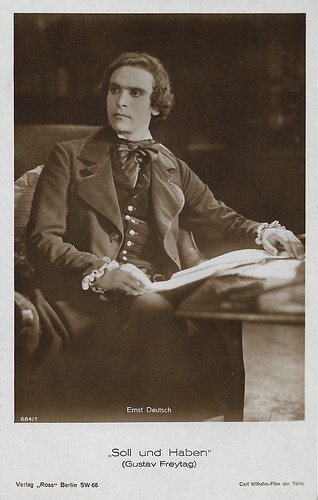
German postcard by Verlag Ross, Berlin, no. 684/1. Photo: Carl-Wilhelm-Film / Terra Film. Ernst Deutsch in Soll und Haben/Debit and Credit (Carl Wilhelm, 1924).
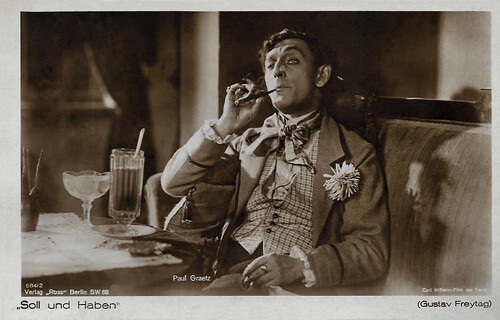
German postcard by Verlag Ross, Berlin, no. 684/2. Photo: Carl-Wilhelm-Film / Terra Film. Paul Graetz in Soll und Haben/Debit and Credit (Carl Wilhelm, 1924).
One of the most popular and widely read German novels of the 19th century
'Soll und Haben' (Debit and Credit, 1855) is a novel in six volumes by Gustav Freytag. It was one of the most popular and widely read German novels of the 19th century. The novel, a Zeitroman or 'social novel', deals with interactions among broad segments of German society during the 19th century. The classes represented are the mercantile or bourgeois class, the nobility, and the Jews.
In the film adaptation, young Anton Wohlfart ( Hans Brausewetter ) begins his professional career after the death of his father, an accountant, at his request as an apprentice in the office of the merchant T.O. Schröter ( Hans Mierendorff ) in Breslau. In the company, the newcomer meets a number of people such as Sabine ( Olga Tschechova ), the boss's sister, and another trainee Fritz von Fink ( Bruno Kastner ), a merchant's son.
Anton quickly makes friends with him. When he meets the young Baroness Lenore von Rothsattel ( Mady Christians ), Anton immediately falls in love with her. On the same day, he also meets the Jew Veitel Itzig (Paul Graetz), a former schoolmate.
Itzig is not particularly scrupulous in his methods of getting very rich very quickly. Itzig works for the Jewish merchant Hirsch Ehrenthal (Robert Garrison) and thus gets to know the once-successful lawyer Hippus ( Heinrich George ). Hippus' reputation has suffered badly since he became involved in crooked dealings.
Due to a lavish lifestyle, the Rothsattel family soon gets into money trouble, which Ehrenthal, Itzig and Hippus want to take advantage of. When Ehrenthal learns that Baron Rothsattel ( Theodor Loos ) is unable to pay his debts, he gives the nobleman some disastrous advice, which mainly benefits Ehrenthal.
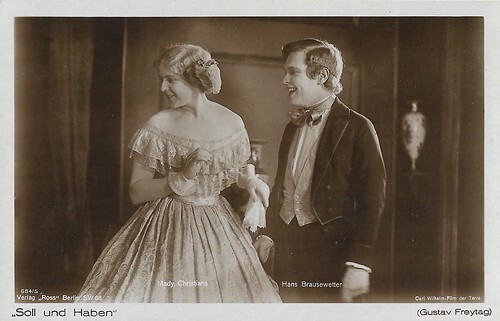
German postcard by Ross Verlag, Berlin, no. 684/5. Photo: Carl Wilhelm-Film / Terra Film. Mady Christians and Hans Brausewetter in Soll und Haben (Carl Wilhelm, 1924), based on the novel by Gustav Freytag.
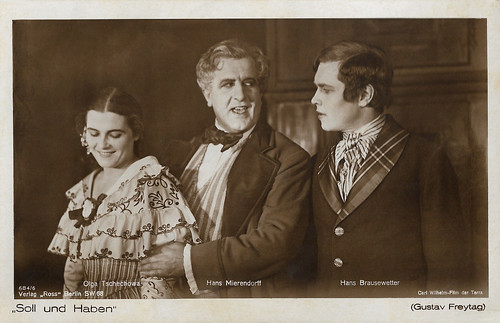
German postcard by Verlag Ross, Berlin, no. 684/6. Photo: Carl-Wilhelm-Film / Terra Film. Olga Tschechova , Hans Mierendorff and Hans Brausewetter in Soll und Haben/Debit and Credit (Carl Wilhelm, 1924).
A clear and lucid play of light
Things develop so tragically for the Rothsattels that the baron tries to shoot himself in desperation. He survives the suicide attempt but goes blind. Fritz von Fink decides to travel to the USA. Meanwhile, Anton supports the Rothsattel family in maintaining their newly acquired Polish estate and helps them defend it against Polish irregulars.
Fritz, who has returned from America, joins them in time to help blow up the Polish siege ring. During this eventful time, Fritz and Lenore von Rothsattel grow closer and eventually become engaged. Anton and the old Rothsattel fall out, whereupon Anton leaves the estate and returns to Schröter's Kontor.
Veitel, who is now quite wealthy, comes into serious conflict with Hippus, who tries to blackmail him, and kills Hippus in the heat of the moment. Morally broken and pursued by the police, Itzig drowns while trying to escape. Meanwhile, the account owner Schröter offers Anton Wohlfahrt to become his partner. He accepts and becomes engaged to Sabine Schröter.
The sets for Soll und Haben (1924) were designed by Robert A. Dietrich and the costumes by Ali Hubert. The film had a length of seven acts on 2758 metres and passed the censors on 15 September 1924. The film received the rating "popular education" and was released for young people. On 10 October 1924, Soll und Haben premiered in Berlin's Primus-Palast.
Oskar Kalbus wrote in ' Vom Werden deutscher Filmkunst. Part 1: The silent film' (1935): "Gustav Freytag's famous novel 'Soll und Haben' was filmed in 1924. Of course, the main motifs of the novel were taken over from the plot of the literary model into the film and only through this was it possible to create a clear and lucid play of light - although 27 actors were involved."
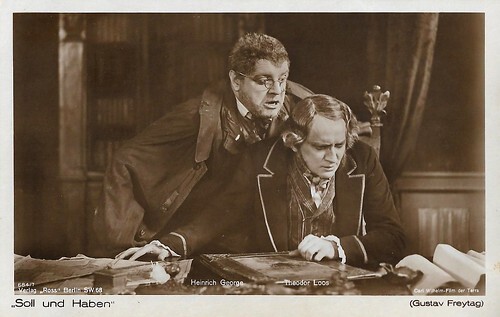
German postcard by Verlag Ross, Berlin, no. 684/7. Photo: Carl-Wilhelm-Film / Terra Film. Theodor Loos and Heinrich George in Soll und Haben/Debit and Credit (Carl Wilhelm, 1924).
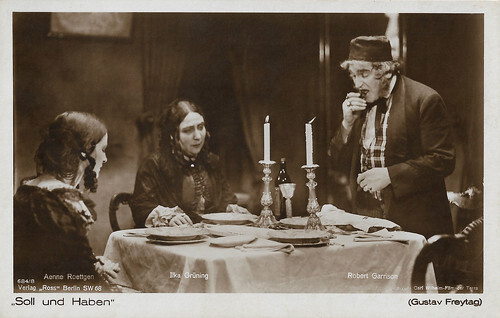
German postcard by Verlag Ross, Berlin, no. 684/8. Photo: Carl-Wilhelm-Film / Terra Film. Aenne Roettgen, Ilka Grüning and Robert Garrison in Soll und Haben/Debit and Credit (Carl Wilhelm, 1924).
Sources: Wikipedia (German and English), and IMDb.

German postcard by Verlag Ross, Berlin, no. 684/1. Photo: Carl-Wilhelm-Film / Terra Film. Ernst Deutsch in Soll und Haben/Debit and Credit (Carl Wilhelm, 1924).

German postcard by Verlag Ross, Berlin, no. 684/2. Photo: Carl-Wilhelm-Film / Terra Film. Paul Graetz in Soll und Haben/Debit and Credit (Carl Wilhelm, 1924).
One of the most popular and widely read German novels of the 19th century
'Soll und Haben' (Debit and Credit, 1855) is a novel in six volumes by Gustav Freytag. It was one of the most popular and widely read German novels of the 19th century. The novel, a Zeitroman or 'social novel', deals with interactions among broad segments of German society during the 19th century. The classes represented are the mercantile or bourgeois class, the nobility, and the Jews.
In the film adaptation, young Anton Wohlfart ( Hans Brausewetter ) begins his professional career after the death of his father, an accountant, at his request as an apprentice in the office of the merchant T.O. Schröter ( Hans Mierendorff ) in Breslau. In the company, the newcomer meets a number of people such as Sabine ( Olga Tschechova ), the boss's sister, and another trainee Fritz von Fink ( Bruno Kastner ), a merchant's son.
Anton quickly makes friends with him. When he meets the young Baroness Lenore von Rothsattel ( Mady Christians ), Anton immediately falls in love with her. On the same day, he also meets the Jew Veitel Itzig (Paul Graetz), a former schoolmate.
Itzig is not particularly scrupulous in his methods of getting very rich very quickly. Itzig works for the Jewish merchant Hirsch Ehrenthal (Robert Garrison) and thus gets to know the once-successful lawyer Hippus ( Heinrich George ). Hippus' reputation has suffered badly since he became involved in crooked dealings.
Due to a lavish lifestyle, the Rothsattel family soon gets into money trouble, which Ehrenthal, Itzig and Hippus want to take advantage of. When Ehrenthal learns that Baron Rothsattel ( Theodor Loos ) is unable to pay his debts, he gives the nobleman some disastrous advice, which mainly benefits Ehrenthal.

German postcard by Ross Verlag, Berlin, no. 684/5. Photo: Carl Wilhelm-Film / Terra Film. Mady Christians and Hans Brausewetter in Soll und Haben (Carl Wilhelm, 1924), based on the novel by Gustav Freytag.

German postcard by Verlag Ross, Berlin, no. 684/6. Photo: Carl-Wilhelm-Film / Terra Film. Olga Tschechova , Hans Mierendorff and Hans Brausewetter in Soll und Haben/Debit and Credit (Carl Wilhelm, 1924).
A clear and lucid play of light
Things develop so tragically for the Rothsattels that the baron tries to shoot himself in desperation. He survives the suicide attempt but goes blind. Fritz von Fink decides to travel to the USA. Meanwhile, Anton supports the Rothsattel family in maintaining their newly acquired Polish estate and helps them defend it against Polish irregulars.
Fritz, who has returned from America, joins them in time to help blow up the Polish siege ring. During this eventful time, Fritz and Lenore von Rothsattel grow closer and eventually become engaged. Anton and the old Rothsattel fall out, whereupon Anton leaves the estate and returns to Schröter's Kontor.
Veitel, who is now quite wealthy, comes into serious conflict with Hippus, who tries to blackmail him, and kills Hippus in the heat of the moment. Morally broken and pursued by the police, Itzig drowns while trying to escape. Meanwhile, the account owner Schröter offers Anton Wohlfahrt to become his partner. He accepts and becomes engaged to Sabine Schröter.
The sets for Soll und Haben (1924) were designed by Robert A. Dietrich and the costumes by Ali Hubert. The film had a length of seven acts on 2758 metres and passed the censors on 15 September 1924. The film received the rating "popular education" and was released for young people. On 10 October 1924, Soll und Haben premiered in Berlin's Primus-Palast.
Oskar Kalbus wrote in ' Vom Werden deutscher Filmkunst. Part 1: The silent film' (1935): "Gustav Freytag's famous novel 'Soll und Haben' was filmed in 1924. Of course, the main motifs of the novel were taken over from the plot of the literary model into the film and only through this was it possible to create a clear and lucid play of light - although 27 actors were involved."

German postcard by Verlag Ross, Berlin, no. 684/7. Photo: Carl-Wilhelm-Film / Terra Film. Theodor Loos and Heinrich George in Soll und Haben/Debit and Credit (Carl Wilhelm, 1924).

German postcard by Verlag Ross, Berlin, no. 684/8. Photo: Carl-Wilhelm-Film / Terra Film. Aenne Roettgen, Ilka Grüning and Robert Garrison in Soll und Haben/Debit and Credit (Carl Wilhelm, 1924).
Sources: Wikipedia (German and English), and IMDb.
Published on October 23, 2022 22:00
October 22, 2022
Kay Francis
American stage and film actress Kay Francis (1905-1968) was a tall, attractive, gray-eyed brunette with undeniable style and poise, known for films such as Ernst Lubitsch's Trouble in Paradise (1932). For a while, in the 1930s she ranked as one of America's most popular actresses, tagged the 'Queen of Warner Brothers'.

British postcard by Art Photo, no. 59.
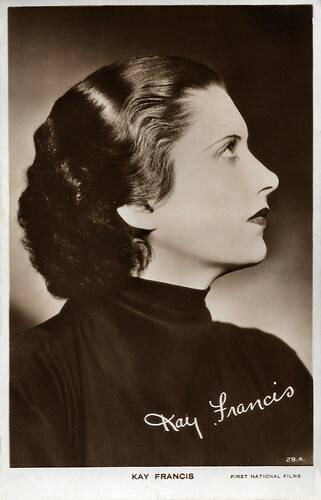
British postcard by Milton, no. 29.A. Photo: First National Films.
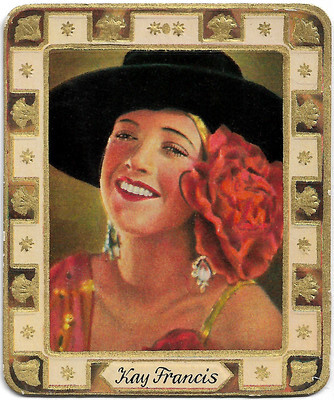
German collectors card in the Moderne Schönheitsgalerie by Ross Verlag, series 2, no 267 of 300. Photo: Paramount. Kay Francis as Carmen in the episode 'The Toreador' in Paramount on Parade (Edmund Goulding a.o., 1930). The card was a supplement with 'Edelzigarette Kurmark'.
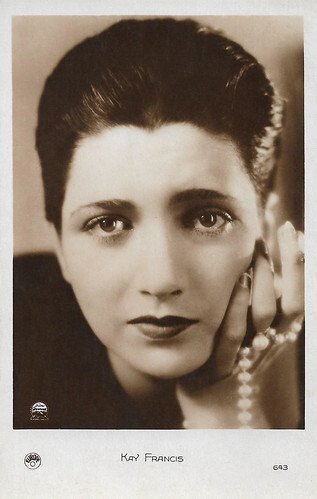
French postcard by Europe, no. 643. Photo: Films Paramount.
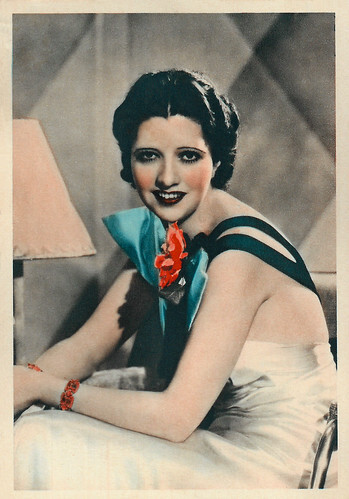
British postcard by De Reszke, no. 20 of 24. Caption: On leaving school, where she was prominent in athletes, Kay Francis became a secretary. Decided upon a stage career: first role was of the "player queen" in a modernised version of 'Hamlet'. Spent a season with a stock company and finally arrived on Broadway. Her first picture was Gentlemen of the Press and the most recent Mandalay and British Agent.
A jazz-era woman with a bob line
Kay Francis was born Katherine Edwina Gibbs in 1905 in Oklahoma City, Oklahoma. However, the year of her birth has been speculated about, with dates anywhere from 1899 to 1908. She was the daughter of actress Katherine Clinton and businessman Joseph Gibbs.
Her father left the family when Francis was four years old. The family travelled from town to town in search of work in the theatre. During this period, Francis grew up in poverty and her mother had to work as a prostitute. After attending some Catholic schools, Francis was trained to become a secretary in 1920. She sold real estate and arranged extravagant parties for wealthy socialites.
Following her marriage in 1922 to James Dwight Francis, the son of a moneyed family, Kay adopted the surname Francis. Kay returned to New York, where she tried to break into the theatre. Her first acting job was as the Player Queen in a modernised version of 'Hamlet' (1925), credited as 'Katharine Francis'. Francis acquired an image of a sexually liberated flapper: a jazz-era woman with a bob line. She played Marjorie Grey in the melodrama 'Crime' (1927) alongside Sylvia Sidney and appeared in the Ring Lardner play 'Elmer the Great' (1928), starring Walter Huston as Elmer Kane.
Huston was so pleased with Francis' performance that he advised her to take a screen test for the film Gentlemen of the Press (Millard Webb, 1929) in which he starred. She was given the role of a femme fatale, making a powerful film debut. Paramount subsequently offered her a contract (1929-1931). In Hollywood, Kay Francis achieved her greatest success between 1930 and 1936. First, she had a bit in the first Marx Brothers outing, The Cocoanuts (Robert Florey, Joseph Santley, 1929). Then she graduated to playing sophisticated seductresses opposite stars like Ronald Colman .
In 1930, she first appeared alongside William Powell in Street of Chance (John Cromwell, 1930). Because the press was so enthusiastic about the chemistry between the two, they eventually acted together in six films. She also appeared in the Lubitsch comedy Trouble in Paradise (Ernst Lubitsch, 1932), though being unhappy about being billed below Miriam Hopkins . One of her best early films was the comedy-drama One Way Passage (Tay Garnett, 1932), in which Kay portrayed a gravely-ill baroness opposite William Powell 's gentleman burglar. This doomed romance, interlaced with witty dialogue, was described by a reviewer as 'spilled cocktail and love at first sight'.
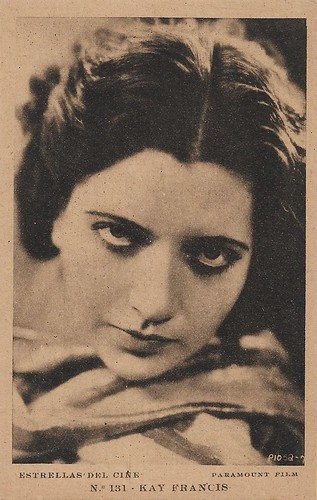
Spanish postcard in the Estrellas del cine series by Editorial Grafica, Barcelona, no. 131. Photo: Paramount Films.
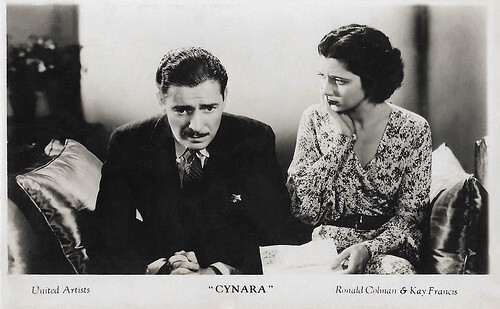
British postcard in the Film Weekly series. Photo: United Artists. Ronald Colman and Kay Francis in Cynara (King Vidor, 1932), a romantic drama film about a British lawyer (Colman) who pays a heavy price for an affair. Francis plays his wife.
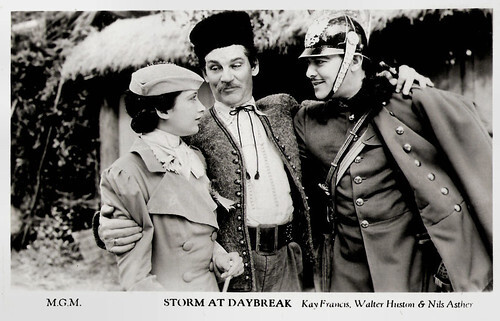
British postcard in the Filmshots Series by Film Weekly. Photo: MGM. Kay Francis, Walter Huston and Nils Asther in Storm at Daybreak (Richard Boleslawski, 1933).
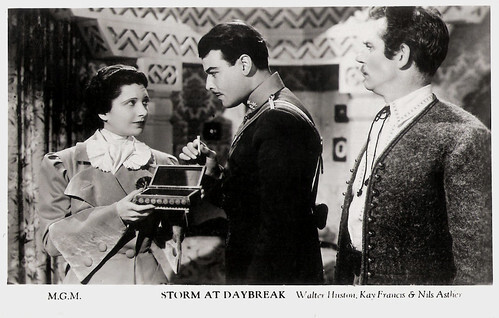
British postcard in the Filmshots Series by Film Weekly. Photo: MGM. Nils Asther , Kay Francis and Walter Huston in Storm at Daybreak (Richard Boleslawski, 1933).
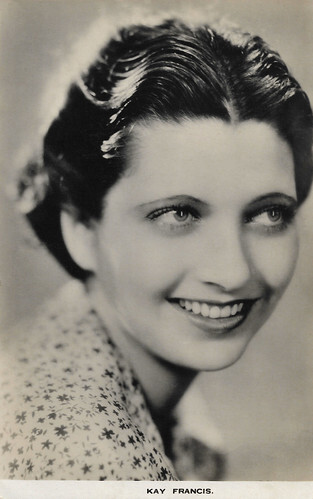
British postcard in the Film Weekly Series, London.
Hollywood's best-dressed woman
Paramount, at the time well-stocked with female stars but experiencing financial problems, decided to let Kay Francis move to Warner Brothers. The studio promised her a higher salary and star status and started promoting her.
Kay became the number one female star at the Warner Brothers studio, becoming the highest-paid American film actress in those years. By 1935, she earned a yearly salary of $115,000. She soon acquired a reputation as Hollywood's 'best-dressed woman', wearing the most glamorous gowns designed by great studio costumers like Orry-Kelly, Travis Banton and Adrian. Female audiences, in particular, often flocked to see Kay Francis's pictures simply to appreciate her sumptuous wardrobe.
'America's glamour girl' had major hits with I Found Stella Parish (Mervyn LeRoy, 1935) and Confession (Joe May, 1937), both excellent money-spinners for the studio. But in 1938 she was declared box-office poison in an advertisement in The Hollywood Reporter by the Independent Theatre Owners Association. She was first reduced to supporting parts and eventually, she had to work on Poverty Row.
During the mid-1940s, Kay co-produced several B-movies as vehicles for herself at Monogram, then made a brief return to stage work. Her most memorable role was in 'State of the Union', a play that became a huge success on Broadway and later toured the country. She acted in summer stock and also made several appearances on television and radio before retiring permanently in 1953.
Kay Francis spent the remainder of her life in New York and in her estate near Falmouth, Cape Cod. In 1961, she was diagnosed with cancer. She broke off her relationship with a younger lover because she did not want him to feel obliged to look after her. In 1967, her health deteriorated sharply and she hardly appeared in public. She died a year later, at the age of 63. She left some of her estate (in excess of one million dollars) to an organisation training guide dogs for the blind, Seeing Eye Inc. She was married and divorced three times. Her husbands were James Dwight Francis (1922-1925), William Gaston (1925-1927), and actor Kenneth MacKenna (1931-1934).
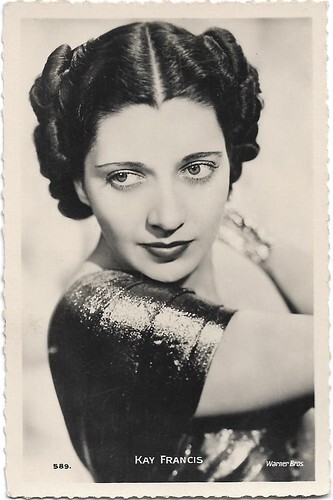
French postcard by Editions E.C., Paris, no. 289. Photo: Warner Bros.
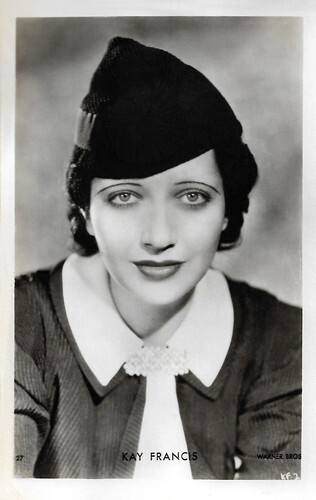
French postcard, no. 27. Photo: Warner Bros.
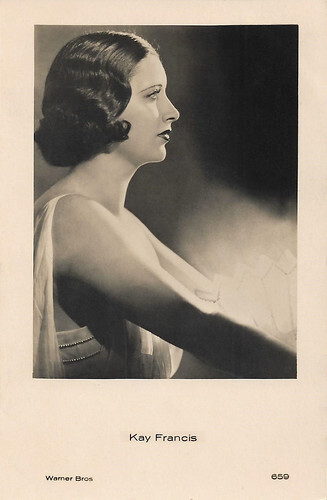
Dutch postcard, no. 659, mailed in 1936. Photo: Warner Bros.
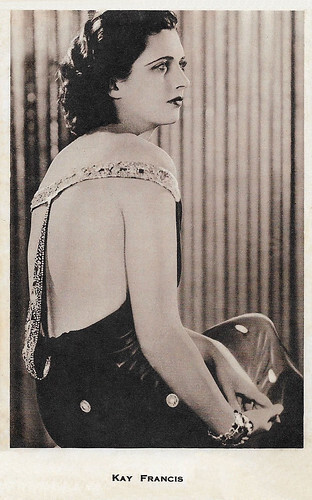
Vintage card.
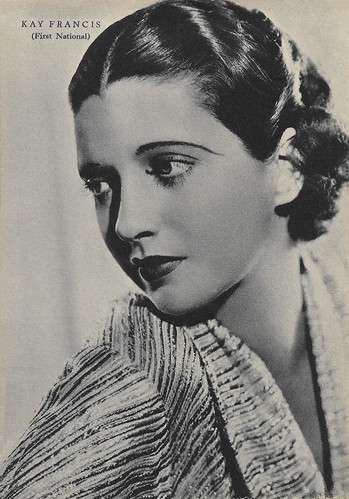
Italian postcard by Rizzoli & C. Milano, 1938. Photo: First National.
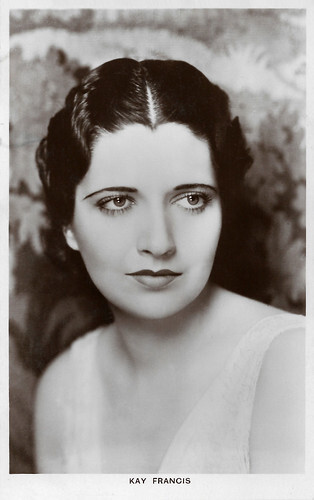
British postcard in the Picturegoer Series, London, no. 457a.
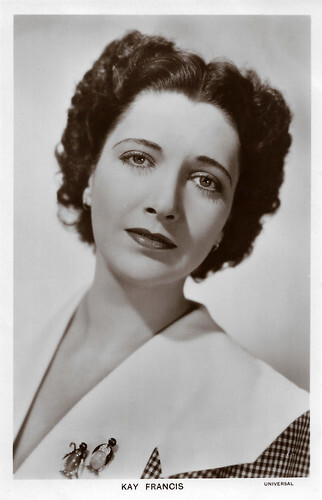
British postcard in the Picturegoer Series, London, no. 457d. Photo: Universal.
Sources: Wikipedia (Dutch) and .

British postcard by Art Photo, no. 59.

British postcard by Milton, no. 29.A. Photo: First National Films.

German collectors card in the Moderne Schönheitsgalerie by Ross Verlag, series 2, no 267 of 300. Photo: Paramount. Kay Francis as Carmen in the episode 'The Toreador' in Paramount on Parade (Edmund Goulding a.o., 1930). The card was a supplement with 'Edelzigarette Kurmark'.

French postcard by Europe, no. 643. Photo: Films Paramount.

British postcard by De Reszke, no. 20 of 24. Caption: On leaving school, where she was prominent in athletes, Kay Francis became a secretary. Decided upon a stage career: first role was of the "player queen" in a modernised version of 'Hamlet'. Spent a season with a stock company and finally arrived on Broadway. Her first picture was Gentlemen of the Press and the most recent Mandalay and British Agent.
A jazz-era woman with a bob line
Kay Francis was born Katherine Edwina Gibbs in 1905 in Oklahoma City, Oklahoma. However, the year of her birth has been speculated about, with dates anywhere from 1899 to 1908. She was the daughter of actress Katherine Clinton and businessman Joseph Gibbs.
Her father left the family when Francis was four years old. The family travelled from town to town in search of work in the theatre. During this period, Francis grew up in poverty and her mother had to work as a prostitute. After attending some Catholic schools, Francis was trained to become a secretary in 1920. She sold real estate and arranged extravagant parties for wealthy socialites.
Following her marriage in 1922 to James Dwight Francis, the son of a moneyed family, Kay adopted the surname Francis. Kay returned to New York, where she tried to break into the theatre. Her first acting job was as the Player Queen in a modernised version of 'Hamlet' (1925), credited as 'Katharine Francis'. Francis acquired an image of a sexually liberated flapper: a jazz-era woman with a bob line. She played Marjorie Grey in the melodrama 'Crime' (1927) alongside Sylvia Sidney and appeared in the Ring Lardner play 'Elmer the Great' (1928), starring Walter Huston as Elmer Kane.
Huston was so pleased with Francis' performance that he advised her to take a screen test for the film Gentlemen of the Press (Millard Webb, 1929) in which he starred. She was given the role of a femme fatale, making a powerful film debut. Paramount subsequently offered her a contract (1929-1931). In Hollywood, Kay Francis achieved her greatest success between 1930 and 1936. First, she had a bit in the first Marx Brothers outing, The Cocoanuts (Robert Florey, Joseph Santley, 1929). Then she graduated to playing sophisticated seductresses opposite stars like Ronald Colman .
In 1930, she first appeared alongside William Powell in Street of Chance (John Cromwell, 1930). Because the press was so enthusiastic about the chemistry between the two, they eventually acted together in six films. She also appeared in the Lubitsch comedy Trouble in Paradise (Ernst Lubitsch, 1932), though being unhappy about being billed below Miriam Hopkins . One of her best early films was the comedy-drama One Way Passage (Tay Garnett, 1932), in which Kay portrayed a gravely-ill baroness opposite William Powell 's gentleman burglar. This doomed romance, interlaced with witty dialogue, was described by a reviewer as 'spilled cocktail and love at first sight'.

Spanish postcard in the Estrellas del cine series by Editorial Grafica, Barcelona, no. 131. Photo: Paramount Films.

British postcard in the Film Weekly series. Photo: United Artists. Ronald Colman and Kay Francis in Cynara (King Vidor, 1932), a romantic drama film about a British lawyer (Colman) who pays a heavy price for an affair. Francis plays his wife.

British postcard in the Filmshots Series by Film Weekly. Photo: MGM. Kay Francis, Walter Huston and Nils Asther in Storm at Daybreak (Richard Boleslawski, 1933).

British postcard in the Filmshots Series by Film Weekly. Photo: MGM. Nils Asther , Kay Francis and Walter Huston in Storm at Daybreak (Richard Boleslawski, 1933).

British postcard in the Film Weekly Series, London.
Hollywood's best-dressed woman
Paramount, at the time well-stocked with female stars but experiencing financial problems, decided to let Kay Francis move to Warner Brothers. The studio promised her a higher salary and star status and started promoting her.
Kay became the number one female star at the Warner Brothers studio, becoming the highest-paid American film actress in those years. By 1935, she earned a yearly salary of $115,000. She soon acquired a reputation as Hollywood's 'best-dressed woman', wearing the most glamorous gowns designed by great studio costumers like Orry-Kelly, Travis Banton and Adrian. Female audiences, in particular, often flocked to see Kay Francis's pictures simply to appreciate her sumptuous wardrobe.
'America's glamour girl' had major hits with I Found Stella Parish (Mervyn LeRoy, 1935) and Confession (Joe May, 1937), both excellent money-spinners for the studio. But in 1938 she was declared box-office poison in an advertisement in The Hollywood Reporter by the Independent Theatre Owners Association. She was first reduced to supporting parts and eventually, she had to work on Poverty Row.
During the mid-1940s, Kay co-produced several B-movies as vehicles for herself at Monogram, then made a brief return to stage work. Her most memorable role was in 'State of the Union', a play that became a huge success on Broadway and later toured the country. She acted in summer stock and also made several appearances on television and radio before retiring permanently in 1953.
Kay Francis spent the remainder of her life in New York and in her estate near Falmouth, Cape Cod. In 1961, she was diagnosed with cancer. She broke off her relationship with a younger lover because she did not want him to feel obliged to look after her. In 1967, her health deteriorated sharply and she hardly appeared in public. She died a year later, at the age of 63. She left some of her estate (in excess of one million dollars) to an organisation training guide dogs for the blind, Seeing Eye Inc. She was married and divorced three times. Her husbands were James Dwight Francis (1922-1925), William Gaston (1925-1927), and actor Kenneth MacKenna (1931-1934).

French postcard by Editions E.C., Paris, no. 289. Photo: Warner Bros.

French postcard, no. 27. Photo: Warner Bros.

Dutch postcard, no. 659, mailed in 1936. Photo: Warner Bros.

Vintage card.

Italian postcard by Rizzoli & C. Milano, 1938. Photo: First National.

British postcard in the Picturegoer Series, London, no. 457a.

British postcard in the Picturegoer Series, London, no. 457d. Photo: Universal.
Sources: Wikipedia (Dutch) and .
Published on October 22, 2022 22:00
Paul van Yperen's Blog
- Paul van Yperen's profile
- 13 followers
Paul van Yperen isn't a Goodreads Author
(yet),
but they
do have a blog,
so here are some recent posts imported from
their feed.



